Organic Electroluminescent Materials And Devices
Chen; Hsiao-Fan ; et al.
U.S. patent application number 16/807877 was filed with the patent office on 2020-07-09 for organic electroluminescent materials and devices. This patent application is currently assigned to Universal Display Corporation. The applicant listed for this patent is Universal Display Corporation. Invention is credited to Pierre-Luc T. Boudreault, Jason Brooks, Hsiao-Fan Chen, Tyler Fleetham, Raghupathi Neelarapu, Katarina Rohlfing, Charles J. Stanton, III, Olexandr Tretyak, Douglas Williams, Peter Wolohan.
| Application Number | 20200216481 16/807877 |
| Document ID | / |
| Family ID | 71404228 |
| Filed Date | 2020-07-09 |












View All Diagrams
| United States Patent Application | 20200216481 |
| Kind Code | A1 |
| Chen; Hsiao-Fan ; et al. | July 9, 2020 |
ORGANIC ELECTROLUMINESCENT MATERIALS AND DEVICES
Abstract
Tetradentate platinum complexes comprising an imidazole/benzimidazole carbene having a structure of Formula I ##STR00001## is disclosed. In Formula I, M is Pd or Pt. These platinum carbenes with the specific substituents disclosed herein are novel and provides phosphorescent emissive compounds that exhibit physical properties that can be tuned, such as sublimation temperature, emission color, and device stability.
| Inventors: | Chen; Hsiao-Fan; (Lawrence Township, NJ) ; Fleetham; Tyler; (Newtown, PA) ; Wolohan; Peter; (Princeton Junction, NJ) ; Brooks; Jason; (Philadelphia, PA) ; Boudreault; Pierre-Luc T.; (Pennington, NJ) ; Stanton, III; Charles J.; (Wilmington, DE) ; Tretyak; Olexandr; (Newark, DE) ; Neelarapu; Raghupathi; (Newark, DE) ; Rohlfing; Katarina; (Wilmington, DE) ; Williams; Douglas; (Mullica Hill, NJ) | ||||||||||
| Applicant: |
|
||||||||||
|---|---|---|---|---|---|---|---|---|---|---|---|
| Assignee: | Universal Display
Corporation Ewing NJ |
||||||||||
| Family ID: | 71404228 | ||||||||||
| Appl. No.: | 16/807877 | ||||||||||
| Filed: | March 3, 2020 |
Related U.S. Patent Documents
| Application Number | Filing Date | Patent Number | ||
|---|---|---|---|---|
| 16718355 | Dec 18, 2019 | |||
| 16807877 | ||||
| 16211332 | Dec 6, 2018 | |||
| 16718355 | ||||
| 15967732 | May 1, 2018 | |||
| 16211332 | ||||
| 62842230 | May 2, 2019 | |||
| 62823922 | Mar 26, 2019 | |||
| 62834666 | Apr 16, 2019 | |||
| 62859919 | Jun 11, 2019 | |||
| 62897667 | Sep 9, 2019 | |||
| 62898219 | Sep 10, 2019 | |||
| 62945273 | Dec 9, 2019 | |||
| 62524080 | Jun 23, 2017 | |||
| 62524086 | Jun 23, 2017 | |||
| Current U.S. Class: | 1/1 |
| Current CPC Class: | H01L 51/0087 20130101; C07F 15/0086 20130101 |
| International Class: | C07F 15/00 20060101 C07F015/00; H01L 51/00 20060101 H01L051/00 |
Claims
1.-28. (canceled)
29. A compound comprising a structure of a formula selected from the group consisting of ##STR00445## wherein, M is selected from the group consisting of Os, Pd, Pt, Ir, Cu, and Au; at least one of R.sup.A1, R.sup.A2, R.sup.A4, R.sup.A5, or R.sup.A6 is a structure of ##STR00446## Y.sup.1A to Y.sup.4A are each independently C or N; no more than two of Y.sup.1A to Y.sup.4A are N; Z.sup.1 to Z.sup.25 are each independently C or N; three consecutive Z.sup.1 to Z.sup.25 in the same ring cannot be N; R.sup.A3, R.sup.A6, R.sup.M, R.sup.N, R.sup.O, R.sup.X, R.sup.Y, and R.sup.Z each independently represent mono to the maximum allowable substitutions, or no substitution; each R.sup.A1, R.sup.A2, R.sup.A3, R.sup.A4, R.sup.A5, R.sup.A6, R.sup.M, R.sup.N, R.sup.O, R.sup.X, R.sup.Y, and R.sup.Z is independently a hydrogen or a substituent selected from the group consisting of deuterium, halogen, alkyl, cycloalkyl, heteroalkyl, heterocycloalkyl, arylalkyl, alkoxy, aryloxy, amino, silyl, alkenyl, cycloalkenyl, heteroalkenyl, alkynyl, aryl, heteroaryl, acyl, carboxylic acid, ether, ester, nitrile, isonitrile, sulfanyl, sulfinyl, sulfonyl, phosphino, boryl, and combinations thereof; M can be coordinated to other ligands; any two substituents can be joined or fused to form a ring; and provided that when the compound is Formula V, and one of R.sup.A1 and R.sup.A2 is Formula VII, then at least one of R.sup.M, R.sup.N, and R.sup.O is selected from the group consisting of deuterium, alkyl, cycloalkyl, heteroalkyl, heterocycloalkyl, aryl, heteroaryl, and combinations thereof.
30.-58. (canceled)
59. The compound of claim 29, wherein the compound is selected from the group consisting of ##STR00447## wherein, M is Pd or Pt; rings B, C, and D are each independently a 5-membered or 6-membered carbocyclic or heterocyclic ring; X.sup.1 to X.sup.9 are each independently C or N; Y.sub.1 to Y.sub.3 are each independently selected from the group consisting of a direct bond, O, and S; at least one of Y.sub.1 to Y.sub.3 is a direct bond; Y.sup.1A to Y.sup.4A are each independently C or N; L.sup.1 to L.sup.3 are each independently selected from the group consisting of a direct bond, O, S, CR'R'', SiR'R'', BR', and NR', alkyl, cycloalkyl, heteroalkyl, heterocycloalkyl, aryl, and heteroaryl; m and n are each independently 0 or 1; at least one of m and n is 1; R.sup.A, R.sup.B, R.sup.C, R.sup.D, R.sup.E, and R.sup.F each independently represents mono to the maximum allowable substitution, or no substitution; each R, R', R'', R.sup.A, R.sup.B, R.sup.C, R.sup.D, R.sup.E, and R.sup.F is independently a hydrogen or a substituent selected from the group consisting of deuterium, halogen, alkyl, cycloalkyl, heteroalkyl, heterocycloalkyl, arylalkyl, alkoxy, aryloxy, amino, silyl, alkenyl, cycloalkenyl, heteroalkenyl, alkynyl, aryl, heteroaryl, acyl, carboxylic acid, ether, ester, nitrile, isonitrile, sulfanyl, sulfinyl, sulfonyl, phosphino, boryl, and combinations thereof; any adjacent substituents can be joined or fused into a ring; and R and an R.sup.B substituent can be joined to form a ring.
60. The compound of claim 59, wherein rings B, C, and D are each 6-membered aromatic rings.
61. The compound of claim 59, wherein L.sup.2 is O, NR', or CRR'.
62. The compound of claim 59, wherein X.sup.2 is N and X.sup.5 is C.
63. The compound of claim 59, wherein L.sup.1 is a direct bond.
64. The compound of claim 59, wherein L.sup.1 is NR'.
65. The compound of claim 59, wherein L.sup.3 is a direct bond.
66. The compound of claim 59, wherein Y.sub.1, Y.sub.2, and Y.sub.3 are each direct bonds.
67. The compound of claim 59, wherein X.sup.1, X.sup.3, and X.sup.4 are each C.
68. The compound of claim 59, wherein m+n is 2.
69. The compound of claim 59, wherein X.sup.8 is C.
70. The compound of claim 59, wherein Y.sup.1A to Y.sup.4A are each C.
71. The compound of claim 59, wherein the compound is selected from the group consisting of: ##STR00448## ##STR00449## ##STR00450## ##STR00451## wherein R is selected from the group consisting of alkyl, cycloalkyl, heteroalkyl, heterocycloalkyl, aryl, heteroaryl, and combinations thereof; wherein R.sup.P has the same definition as R.sup.B and R.sup.C; and wherein any two substituents may be joined or fused together to form a ring.
72. The compound of claim 59, the compound is selected from the group consisting of Compound y having the formula Pt(L.sub.Cm)(L.sub.Dn), wherein y is an integer defined by y=25543(m-1)+n, wherein m is an integer from 1 to 2428910 and n is an integer from 1 to 25543, wherein L.sub.Cm has the following structures: TABLE-US-00008 L.sub.Cm Structure of L.sub.Cm Ar.sup.1, R m wherein L.sub.C1 to L.sub.C110405 have the structure ##STR00452## wherein R.sup.A1 = Rj, wherein j is an integer from 1 to 110405, and m = j wherein L.sub.C110406-L.sub.C220810 have the structure ##STR00453## wherein R.sup.A1 = Rj, wherein j is an integer from 1 to 110405, and m = j + 110405 wherein L.sub.C220811-L.sub.C331215 have the structure ##STR00454## wherein R.sup.A1 = Rj, wherein j is an integer from 1 to 110405, and m = j + 220810 wherein L.sub.C331216-L.sub.C441620 have the structure ##STR00455## wherein R.sup.A1 = Rj, wherein j is an integer from 1 to 110405, and m = j + 331215 wherein L.sub.C441621-L.sub.C552025 have the structure ##STR00456## wherein R.sup.A1 = Rj, wherein j is an integer from 1 to 110405, and m = j + 441620 wherein L.sub.C552026-L.sub.C662430 have the structure ##STR00457## wherein R.sup.A1 = Rj, wherein j is an integer from 1 to 110405, and m = j + 552025 wherein L.sub.C662431-L.sub.C772835 have the structure ##STR00458## wherein R.sup.A1 = Rj, wherein j is an integer from 1 to 110405, and m = j + 662430 wherein L.sub.C772836-L.sub.C883240 have the structure ##STR00459## wherein R.sup.A1 = Rj, wherein j is an integer from 1 to 110405, and m = j + 772835 wherein L.sub.C883241-L.sub.C993645 have the structure ##STR00460## wherein R.sup.A1 = Rj, wherein j is an integer from 1 to 110405, and m = j + 883240 wherein L.sub.C993646-L.sub.C1104050 have the structure ##STR00461## wherein R.sup.A1 = Rj, wherein j is an integer from 1 to 110405, and m = j + 993645 wherein L.sub.C1104051-L.sub.C1214455 have the structure ##STR00462## wherein R.sup.A1 = Rj, wherein j is an integer from 1 to 110405, and m = j + 1104050 wherein L.sub.C1214456-L.sub.C1324860 have the structure ##STR00463## wherein R.sup.A1 = Rj, wherein j is an integer from 1 to 110405, and m = j + 1214455 wherein L.sub.C1324861-L.sub.C1435265 have the structure ##STR00464## wherein R.sup.A1 = Rj, wherein j is an integer from 1 to 110405, and m = j + 1324860 wherein L.sub.C1435266-L.sub.C1545670 have the structure ##STR00465## wherein R.sup.A1 = Rj, wherein j is an integer from 1 to 110405, and m = j + 1435265 wherein L.sub.C1545671-L.sub.C1656075 have the structure ##STR00466## wherein R.sup.A1 = Rj, wherein j is an integer from 1 to 110405, and m = j + 1545670 wherein L.sub.C1656076-L.sub.C1766480 have the structure ##STR00467## wherein R.sup.A1 = Rj, wherein j is an integer from 1 to 110405, and m = j + 1656075 wherein L.sub.C1766481-L.sub.C1876885 have the structure ##STR00468## wherein R.sup.A1 = Rj, wherein j is an integer from 1 to 110405, and m = j + 1766480 wherein L.sub.C1876886-L.sub.C1987290 have the structure ##STR00469## wherein R.sup.A1 = Rj, wherein j is an integer from 1 to 110405, and m = j + 1876885 wherein L.sub.C1987291-L.sub.C2097695 have the structure ##STR00470## wherein R.sup.A1 = Rj, wherein j is an integer from 1 to 110405, and m = j + 1987290 wherein L.sub.C2097696-L.sub.C2208100 have the structure ##STR00471## wherein R.sup.A1 = Rj, wherein j is an integer from 1 to 110405, and m = j + 2097695 wherein L.sub.C2208101-L.sub.C2318505 have the structure ##STR00472## wherein R.sup.A1 = Rj, wherein j is an integer from 1 to 110405, and m = j + 2208100 wherein L.sub.C2318506-L.sub.C2428910 have the structure ##STR00473## wherein R.sup.A1 = Rj, wherein j is an integer from 1 to 110405, and m = j + 2318505 wherein L.sub.C2428910-L.sub.C2438910 have the structure ##STR00474## wherein R.sup.A1 = Bj, R.sup.A2 = Bk, wherein j and k is an integer from 1 to 100, and m = 100(j - 1) + k + 2428910
wherein R1 to R110405 have the following structures: TABLE-US-00009 Rj Structure of Rm R.sup.S1, R.sup.S2, R.sup.S3 j wherein R1-R100 have the structure ##STR00475## wherein R.sup.S1 = Bt, wherein t is an integer from 1 to 100, and j = t wherein R101-R10100 have the structure ##STR00476## wherein R.sup.S1 = Bt, R.sup.S2 = Bu wherein t and u are an integer from 1 to 100, and j = 100(t - 1) + u + 100 wherein R10101-R20100 have the structure ##STR00477## wherein R.sup.S1 = Bt, R.sup.S2 = Bu wherein t and u are an integer from 1 to 100, and j = 100(t - 1) + u + 10100 wherein R20101-R20200 have the structure ##STR00478## wherein R.sup.S1 = Bt, wherein t is an integer from 1 to 100, and j = t + 20100 wherein R20201-R30200 have the structure ##STR00479## wherein R.sup.S1 = Bt, R.sup.S2 = Bu wherein t and u are an integer from 1 to 100, and j = 100(t - 1) + u + 20100 wherein R30201-R40200 have the structure ##STR00480## wherein R.sup.S1 = Bt, R.sup.S2 = Bu wherein t and u are an integer from 1 to 100, and j = 100(t - 1) + u + 30200 wherein R40201 have the structure ##STR00481## j = 40201 wherein R40202-R40301 have the structure ##STR00482## wherein R.sup.S1 = Bt, wherein t is an integer from 1 to 100, and j = t + 40201 wherein R40302-R40401 have the structure ##STR00483## wherein R.sup.S1 = Bt, wherein t is an integer from 1 to 100, and j = t + 40301 wherein R40402 have the structure ##STR00484## j = 40402 wherein R40403-R40502 have the structure ##STR00485## wherein R.sup.S1 = Bt, wherein t is an integer from 1 to 100, and j = t + 40402 wherein R40503-R40602 have the structure ##STR00486## wherein R.sup.S1 = Bt, wherein t is an integer from 1 to 100, and j = t + 40502 wherein R40603-R50602 have the structure ##STR00487## wherein R.sup.S1 = Bt, R.sup.S2 = Bu wherein t and u are an integer from 1 to 100, and j = 100(t - 1) + u + 40602 wherein R50603 have the structure ##STR00488## j = 50603 wherein R50604-R50703 have the structure ##STR00489## wherein R.sup.S1 = Bt, wherein t is an integer from 1 to 100, and j = t + 50603 wherein R50704 have the structure ##STR00490## j = 50704 wherein R50705-R50804 have the structure ##STR00491## wherein R.sup.S1 = Bt, wherein t is an integer from 1 to 100, and j = t + 50704 wherein R50805-R50904 have the structure ##STR00492## wherein R.sup.S1 = Bt, wherein t is an integer from 1 to 100, and j = t + 50804 wherein R50905-R51004 have the structure ##STR00493## wherein R.sup.S1 = Bt, wherein t is an integer from 1 to 100, and s = t + 50904 wherein R51005-R61004 have the structure ##STR00494## wherein R.sup.S1 = Bt, R.sup.S2 = Bu wherein t and u are an integer from 1 to 100, and j = 30(t - 1) + u + 51004 wherein R61005-R71004 have the structure ##STR00495## wherein R.sup.S1 = Bt, R.sup.S2 = Bu wherein t and u are an integer from 1 to 100, and j = 30(t - 1) + u + 61004 wherein R71005 have the structure ##STR00496## j = 71005 wherein R71006-R71105 have the structure ##STR00497## wherein R.sup.S1 = Bt, wherein t is an integer from 1 to 100, and j = t + 71105 wherein R71106-R71205 have the structure ##STR00498## wherein R.sup.S1 = Bt, wherein t is an integer from 1 to 100, and j = t + 71105 wherein R71206-R71305 have the structure ##STR00499## wherein R.sup.S1 = Bt, wherein t is an integer from 1 to 100, and j = t + 71205 wherein R71306-R81305 have the structure ##STR00500## wherein R.sup.S1 = Bt, R.sup.S2 = Bu wherein t and u are an integer from 1 to 100, and j = 100(t - 1) + u + 71305 wherein R81306-R91305 have the structure ##STR00501## wherein R.sup.S1 = Bt, R.sup.S2 = Bu wherein t and u are an integer from 1 to 100, and j = 100(t - 1) + u + 81305 wherein R91306-R91405 have the structure ##STR00502## wherein R.sup.S1 = Bt, wherein t is an integer from 1 to 100, and j = t + 91305 wherein R91406-R101405 have the structure ##STR00503## wherein R.sup.S1 = Bt, R.sup.S2 = Bu wherein t and u are an integer from 1 to 100, and j = 100(t - 1) + u + 91405 wherein R101406-R110405 have the structure ##STR00504## wherein R.sup.S1 = Bt, R.sup.S2 = Bu wherein t and u are an integer from 1 to 100, and j = 100(t - 1) + u + 101405
wherein B1 to B100 have the following structures: ##STR00505## ##STR00506## ##STR00507## ##STR00508## ##STR00509## ##STR00510## ##STR00511## ##STR00512## ##STR00513## ##STR00514## wherein L.sub.Dn has the following structures: TABLE-US-00010 L.sub.Dm L.sub.Dm structure Ar.sup.2, Ar.sup.3, R.sup.2 n wherein L.sub.D1-L.sub.D30 have the structure ##STR00515## wherein Ar.sup.2 = Aj, wherein j is an integer from 1 to 30, and n = j wherein L.sub.D31 has the structure ##STR00516## n = 31 wherein L.sub.D32-L.sub.D931 have the structure ##STR00517## wherein Ar.sup.2 = Aj and Ar.sup.3 = Am, wherein j is an integer from 1 to 30 and m is an integer from 1 to 30, and n = 30(j - 1) + m + 31 wherein L.sub.D932-L.sub.D961 have the structure ##STR00518## wherein Ar.sup.2 = Aj, wherein j is an integer from 1 to 30, and n = j + 931 wherein L.sub.D962-L.sub.D1861 have the structure ##STR00519## wherein Ar.sup.2 = Aj and Ar.sup.3 = Am, wherein j is an integer from 1 to 30 and m is an integer from 1 to 30, and n = 30(j - 1) + m + 961 wherein L.sub.D1862-L.sub.D1891 have the structure ##STR00520## wherein Ar.sup.2 = Aj, wherein j is an integer from 1 to 30, and n = j + 1861 wherein L.sub.D1892-L.sub.D1921 have the structure ##STR00521## wherein Ar.sup.2 = Aj, wherein j is an integer from 1 to 30, and n = j + 1891 wherein L.sub.D1922-L.sub.D2821 have the structure ##STR00522## wherein Ar.sup.2 = Aj and Ar.sup.3 = Am, wherein j is an integer from 1 to 30 and m is an integer from 1 to 30, and n = 30(j - 1) + m + 1921 wherein L.sub.D2822-L.sub.D3721 have the structure ##STR00523## wherein Ar.sup.2 = Aj and Ar.sup.3 = Am, wherein j is an integer from 1 to 30 and m is an integer from 1 to 30, and n = 30(j - 1) + m + 2821 wherein L.sub.D3722-L.sub.D4621 have the structure ##STR00524## wherein Ar.sup.2 = Aj and Ar.sup.3 = Am, wherein j is an integer from 1 to 30 and m is an integer from 1 to 30, and n = 30(j - 1) + m + 3721 wherein L.sub.D4622-L.sub.D4651 have the structure ##STR00525## wherein Ar.sup.2 = Aj, wherein j is an integer from 1 to 30, and n = j + 4621 wherein L.sub.D4652-L.sub.D5551 have the structure ##STR00526## wherein Ar.sup.2 = Aj and Ar.sup.3 = Am, wherein j is an integer from 1 to 30 and m is an integer from 1 to 30, and n = 30(j - 1) + m + 4651 wherein L.sub.D5552-L.sub.D5581 have the structure ##STR00527## wherein Ar.sup.2 = Aj, wherein j is an integer from 1 to 30, and n = j + 5551 wherein L.sub.D5582-L.sub.D6481 have the structure ##STR00528## wherein Ar.sup.2 = Aj and Ar.sup.3 = Am, wherein j is an integer from 1 to 30 and m is an integer from 1 to 30, and n = 30(j - 1) + m + 5581 wherein L.sub.D6482-L.sub.D7381 have the structure ##STR00529## wherein Ar.sup.2 = Aj and Ar.sup.3 = Am, wherein j is an integer from 1 to 30 and m is an integer from 1 to 30, and n = 30(j - 1) + m + 6481 wherein L.sub.D7382 has the structure ##STR00530## n = 7382 wherein L.sub.D7383-L.sub.D7412 have the structure ##STR00531## wherein Ar.sup.2 = Aj, wherein j is an integer from 1 to 30, and n = j + 7382 wherein L.sub.D7413-L.sub.D7442 have the structure ##STR00532## wherein Ar.sup.2 = Aj, wherein j is an integer from 1 to 30, and n = j + 7412 wherein L.sub.D7443-L.sub.D7472 have the structure ##STR00533## wherein Ar.sup.2 = Aj, wherein j is an integer from 1 to 30, and n = j + 7442 wherein L.sub.D7473-L.sub.D7502 have the structure ##STR00534## wherein Ar.sup.2 = Aj, wherein j is an integer from 1 to 30, and n = j + 7472 wherein L.sub.D7503 have the structure ##STR00535## n = 7503 wherein L.sub.D7504-L.sub.D7533 have the structure ##STR00536## wherein Ar.sup.2 = Aj, wherein j is an integer from 1 to 30, and n = j + 7503 wherein L.sub.D7534-L.sub.D8433 have the structure ##STR00537## wherein Ar.sup.2 = Aj and Ar.sup.3 = Am, wherein j is an integer from 1 to 30 and m is an integer from 1 to 30, and n = 30(j - 1) + m + 7533 wherein L.sub.D8434-L.sub.D8463 have the structure ##STR00538## wherein Ar.sup.2 = Aj, wherein j is an integer from 1 to 30, and n = j + 8433 wherein L.sub.D8464-L.sub.D9363 have the structure ##STR00539## wherein Ar.sup.2 = Aj and Ar.sup.3 = Am, wherein j is an integer from 1 to 30 and m is an integer from 1 to 30, and n = 30(j - 1) + m + 8463 wherein L.sub.D9364-L.sub.D9393 have the structure ##STR00540## wherein Ar.sup.2 = Aj, wherein j is an integer from 1 to 30, and n = j + 9363 wherein L.sub.D9394-L.sub.D9423 have the structure ##STR00541## wherein Ar.sup.2 = Aj, wherein j is an integer from 1 to 30, and n = j + 9393 wherein L.sub.D9424-L.sub.D10323 have the structure ##STR00542## wherein Ar.sup.2 = Aj and Ar.sup.3 = Am, wherein j is an integer from 1 to 30 and m is an integer from 1 to 30, and n = 30(j - 1) + m + 9423 wherein L.sub.D10324-L.sub.D11223 have the structure ##STR00543## wherein Ar.sup.2 = Aj and Ar.sup.3 = Am, wherein j is an integer from 1 to 30 and m is an integer from 1 to 30, and n = 30(j - 1) + m + 10323 wherein L.sub.D11224-L.sub.D11253 have the structure ##STR00544## wherein Ar.sup.2 = Aj, wherein j is an integer from 1 to 30, and n = j + 11223 wherein L.sub.D11254 has the structure ##STR00545## n = 11254 wherein L.sub.D11255-L.sub.D11284 have the structure ##STR00546## wherein Ar.sup.2 = Aj, wherein j is an integer from 1 to 30, and n = j + 11254 wherein L.sub.D11285 has the structure ##STR00547## n = 11285 wherein L.sub.D11286-L.sub.D12185 have the structure ##STR00548## wherein Ar.sup.2 = Aj and R.sup.2 = Al wherein j is an integer from 1 to 30 and l is an integer from 1 to 30, and n = 30(j - 1) + l + 11285 wherein L.sub.D12186-L.sub.D12215 have the structure ##STR00549## wherein R.sup.2 = Al, wherein l is an integer from 1 to 30, and n = l + 12185 wherein L.sub.D12216-L.sub.D13115 have the structure ##STR00550## wherein Ar.sup.2 = Aj and R.sup.2 = Al, wherein j is an integer from 1 to 30 and l is an integer from 1 to 30, and n = 30(j - 1) + l + 12215 wherein L.sub.D13116-L.sub.D13145 have the structure ##STR00551## wherein R.sup.2 = Al, wherein l is an integer from 1 to 30, and n = l + 13115 wherein L.sub.D13146-L.sub.D14045 have the structure ##STR00552## wherein Ar.sup.2 = Aj and R.sup.2 = Al, wherein j is an integer from 1 to 30 and l is an integer from 1 to 30, and n = 30(j - 1) + l + 13145 wherein L.sub.D14046-L.sub.D14075 have the structure ##STR00553## wherein R.sup.2 = Al, wherein l is an integer from 1 to 30, and n = l + 14045 wherein L.sub.D14076-L.sub.D14975 have the structure ##STR00554## wherein Ar.sup.2 = Aj and R.sup.2 = Al, wherein j is an integer from 1 to 30 and l is an integer from 1 to 30, and n = 30(j - 1) + l + 14075 wherein L.sub.D14976-L.sub.D15005 have the structure ##STR00555## wherein R.sup.2 = Al, wherein l is an integer from 1 to 30, and n = l + 14975 wherein L.sub.D15006-L.sub.D15905 have the structure ##STR00556## wherein Ar.sup.2 = Aj and R.sup.2 = Al, wherein j is an integer from 1 to 30 and l is an integer from 1 to 30, and n = 30(j - 1) + l + 15005 wherein L.sub.D15906-L.sub.D15935 have the structure ##STR00557## wherein R.sup.2 = Al, wherein l is an integer from 1 to 30, and n = l + 15905 wherein L.sub.D15936-L.sub.D16835 have the structure ##STR00558## wherein Ar.sup.2 = Aj and R.sup.2 = Al, wherein j is an integer from 1 to 30 and l is an integer from 1 to 30, and n = 30(j - 1) + l + 15935 wherein L.sub.D16836-L.sub.D16865 have the structure ##STR00559## wherein R.sup.2 = Al, wherein l is an integer from 1 to 30, and n = l + 16835 wherein L.sub.D16866-L.sub.D17765 have the structure ##STR00560## wherein Ar.sup.2 = Aj and R.sup.2 = Al, wherein j is an integer from 1 to 30 and l is an integer from 1 to 30, and n = 30(j - 1) + l + 16865 wherein L.sub.D17766-L.sub.D17795 have the structure ##STR00561## wherein R.sup.2 = Al, wherein l is an integer from 1 to 30, and n = l + 17765 wherein L.sub.D17796-L.sub.D17825 have the structure ##STR00562## wherein Ar.sup.2 = Aj, wherein j is an integer from 1 to 30, and n = j + 17795 wherein L.sub.D17826 has the structure ##STR00563## n = 17826 wherein L.sub.D17827-L.sub.D18726 have the structure ##STR00564## wherein Ar.sup.2 = Aj and Ar.sup.3 = Am, wherein j is an integer from 1 to 30 and m is an integer from 1 to 30, and n = 30 (j - 1) + m + 17826 wherein L.sub.D18727-L.sub.D18756 have the structure ##STR00565## wherein Ar.sup.2 = Aj, wherein j is an integer from 1 to 30, and n = j + 18726 wherein L.sub.D18757-L.sub.D19656 have the structure ##STR00566## wherein Ar.sup.2 = Aj and Ar.sup.3 = Am, wherein j is an integer from 1 to 30 and m is an integer from 1 to 30, and n = 30(j - 1) + m + 18756 wherein L.sub.D19657-L.sub.D19686 have the structure ##STR00567## wherein Ar.sup.2 = Aj, wherein j is an integer from 1 to 30, and n = j + 19656 wherein L.sub.D19687-L.sub.D19716 have the structure ##STR00568## wherein Ar.sup.2 = Aj, wherein j is an integer from 1 to 30, and n = j + 19686 wherein L.sub.D19717 have the structure ##STR00569## n = 19717 wherein L.sub.D19718-L.sub.D20617 have the structure ##STR00570## wherein Ar.sup.2 = Aj and Ar.sup.3 = Am, wherein j is an integer from 1 to 30 and m is an integer from 1 to 30, and n = 30(j - 1) + m + 19717 wherein L.sub.D20618-L.sub.D20647 have the structure ##STR00571## wherein Ar.sup.2 = Aj, wherein j is an integer from 1 to 30, and n = j + 20617 wherein L.sub.D20648-L.sub.D21547 have the structure ##STR00572## wherein Ar.sup.2 = Aj and Ar.sup.3 = Am, wherein j is an integer from 1 to 30 and m is an integer from 1 to 30, and n = 30(j - 1) + m + 20647 wherein L.sub.D21548-L.sub.D21577 have the structure ##STR00573## wherein Ar.sup.2 = Aj, wherein j is an integer from 1 to 30, and n = j + 21547 wherein L.sub.D21578-L.sub.D22477 have the structure ##STR00574## wherein Ar.sup.2 = Aj and Ar.sup.3 = Am, wherein j is an integer from 1 to 30 and m is an integer from 1 to 30, and n = 30(j - 1) + m + 21577 wherein L.sub.D22478-L.sub.D22507 have the structure ##STR00575## wherein Ar.sup.2 = Aj, wherein j is an integer from 1 to 30, and n = j + 22477 wherein L.sub.D22508-L.sub.D23407 have the structure ##STR00576## wherein Ar.sup.2 = Aj and Ar.sup.3 = Am, wherein j is an integer from 1 to 30 and m is an integer from 1 to 30, and n = 30(j - 1) + m + 22507 wherein L.sub.D23408-L.sub.D23437 have the structure ##STR00577## wherein Ar.sup.2 = Aj, wherein j is an integer from 1 to 30, and n = j + 23407 wherein L.sub.D23438-L.sub.D24337 have the structure ##STR00578## wherein Ar.sup.2 = Aj and Ar.sup.3 = Am, wherein j is an integer from 1 to 30 and m is an integer from 1 to 30, and n = 30(j - 1) + m + 23437 wherein L.sub.D24338-L.sub.D24367 have the structure ##STR00579## wherein Ar.sup.2 = Aj, wherein j is an integer from 1 to 30, and n = j + 24337 wherein L.sub.D24368-L.sub.D25267 have the structure ##STR00580## wherein Ar.sup.2 = Aj and Ar.sup.3 = Am, wherein j is an integer from 1 to 30 and m is an integer from 1 to 30, and n = 30(j - 1) + m + 24367 wherein L.sub.D25268-L.sub.D25297 have the structure ##STR00581## wherein Ar.sup.2 = Aj, wherein j is an integer from 1 to 30, and n = j + 25267 wherein L.sub.D25298-L.sub.D25327 have the structure ##STR00582## wherein Ar.sup.2 = Aj, wherein j is an integer from 1 to 30, and n = j + 25297
wherein L.sub.D25328-L.sub.D25357 have the structure ##STR00583## wherein Ar.sup.2 = Aj, wherein j is an integer from 1 to 30, and n = j + 25327 wherein L.sub.D25358-L.sub.D25387 have the structure ##STR00584## wherein Ar.sup.2 = Aj, wherein j is an integer from 1 to 30, and n = j + 25357 wherein L.sub.D25388-L.sub.D25417 have the structure ##STR00585## wherein Ar.sup.2 = Aj, wherein j is an integer from 1 to 30, and n = j + 25387 wherein L.sub.D25418-L.sub.D25447 have the structure ##STR00586## wherein Ar.sup.2 = Aj, wherein j is an integer from 1 to 30, and n = j + 25417 wherein L.sub.D25448-L.sub.B25477 has the structure ##STR00587## wherein Ar.sup.2 = Aj, wherein j is an integer from 1 to 30, and n = j + 25447 wherein L.sub.D25478 has the structure ##STR00588## n = 25478 wherein L.sub.D25479 has the structure ##STR00589## n = 25479 wherein L.sub.D25480 has the structure ##STR00590## n = 25480 wherein L.sub.D25481 has the structure ##STR00591## n = 25481 wherein L.sub.D25482 has the structure ##STR00592## n = 25482 wherein L.sub.D25483 has the structure ##STR00593## n = 25483 wherein L.sub.D25484-L.sub.D25513 have the structure ##STR00594## wherein Ar.sup.2 = Aj, wherein j is an integer from 1 to 30, and n = j + 25483 wherein L.sub.D25514-L.sub.D25543 have the structure ##STR00595## wherein Ar.sup.2 = Aj, wherein j is an integer from 1 to 30, and n = j + 25513
wherein A1 to A30 have the following structures: ##STR00596## ##STR00597## ##STR00598## ##STR00599##
73. An organic light emitting device (OLED) comprising: an anode; a cathode; and an organic layer, disposed between the anode and the cathode, comprising a compound of ##STR00600## wherein, M is Pd or Pt; rings B, C, and D are each independently a 5-membered or 6-membered carbocyclic or heterocyclic ring; X.sup.1 to X.sup.9 are each independently C or N; Y.sub.1 to Y.sub.3 are each independently selected from the group consisting of a direct bond, O, and S; at least one of Y.sub.1 to Y.sub.3 is a direct bond; C.sup.A is a carbene carbon; L.sup.1 to L.sup.3 are each independently selected from the group consisting of a direct bond, O, S, CR'R'', SiR'R'', BR', and NR', alkyl, cycloalkyl, heteroalkyl, heterocycloalkyl, aryl, and heteroaryl; m and n are each independently 0 or 1; at least one of m and n is 1; at least one of R, R.sup.A, R.sup.B, R.sup.C, R.sup.D, L.sup.1, L.sup.2, and L.sup.3 comprises a group having a structure of Formula II: ##STR00601## wherein, [X] is a 5-membered heterocyclic ring, 5-membered carbocyclic ring, a 6-membered heterocyclic ring, a 6-membered carbocyclic ring, or a fused heterocylic or carbocyclic ring system comprising two or more fused rings; rings E and F are each independently a 5-membered or 6-membered carbocyclic or heterocyclic ring; R.sup.A, R.sup.B, R.sup.C, R.sup.D, R.sup.E, and R.sup.F each independently represents mono to the maximum number of allowable substitutions, or no substitution; each R, R', R'', R.sup.A, R.sup.B, R.sup.C, R.sup.D, R.sup.E, and R.sup.F is independently a hydrogen or a substituent selected from the group consisting of deuterium, halogen, alkyl, cycloalkyl, heteroalkyl, heterocycloalkyl, arylalkyl, alkoxy, aryloxy, amino, silyl, alkenyl, cycloalkenyl, heteroalkenyl, alkynyl, aryl, heteroaryl, acyl, carboxylic acid, ether, ester, nitrile, isonitrile, sulfanyl, sulfinyl, sulfonyl, phosphino, boryl, and combinations thereof; any adjacent substituents can be joined or fused into a ring; R and an R.sup.B substituent can be joined to form a ring; and the molecular weight of the group having a structure of Formula II is greater than or equal to 395 grams/mole.
74. The OLED of claim 73, wherein the organic layer further comprises a host, wherein host comprises at least one chemical group selected from the group consisting of triphenylene, carbazole, dibenzothiphene, dibenzofuran, dibenzoselenophene, azatriphenylene, azacarbazole, aza-dibenzothiophene, aza-dibenzofuran, and aza-dibenzoselenophene.
75. A consumer product comprising an organic light-emitting device (OLED) comprising: an anode; a cathode; and an organic layer, disposed between the anode and the cathode, comprising the compound of ##STR00602## wherein, M is Pd or Pt; rings B, C, and D are each independently a 5-membered or 6-membered carbocyclic or heterocyclic ring; X.sup.1 to X.sup.9 are each independently C or N; Y.sub.1 to Y.sub.3 are each independently selected from the group consisting of a direct bond, O, and S; at least one of Y.sub.1 to Y.sub.3 is a direct bond; C.sup.A is a carbene carbon; L.sup.1 to L.sup.3 are each independently selected from the group consisting of a direct bond, O, S, CR'R'', SiR'R'', BR', and NR', alkyl, cycloalkyl, heteroalkyl, heterocycloalkyl, aryl, and heteroaryl; m and n are each independently 0 or 1; at least one of m and n is 1; at least one of R, R.sup.A, R.sup.B, R.sup.C, R.sup.D, L.sup.1, L.sup.2, and L.sup.3 comprises a group having a structure of Formula II: ##STR00603## wherein, [X] is a 5-membered heterocyclic ring, 5-membered carbocyclic ring, a 6-membered heterocyclic ring, a 6-membered carbocyclic ring, or a fused heterocylic or carbocyclic ring system comprising two or more fused rings; rings E and F are each independently a 5-membered or 6-membered carbocyclic or heterocyclic ring; R.sup.A, R.sup.B, R.sup.C, R.sup.D, R.sup.E, and R.sup.F each independently represents mono to the maximum number of allowable substitutions, or no substitution; each R, R', R'', R.sup.A, R.sup.B, R.sup.C, R.sup.D, R.sup.E, and R.sup.F is independently a hydrogen or a substituent selected from the group consisting of deuterium, halogen, alkyl, cycloalkyl, heteroalkyl, heterocycloalkyl, arylalkyl, alkoxy, aryloxy, amino, silyl, alkenyl, cycloalkenyl, heteroalkenyl, alkynyl, aryl, heteroaryl, acyl, carboxylic acid, ether, ester, nitrile, isonitrile, sulfanyl, sulfinyl, sulfonyl, phosphino, boryl, and combinations thereof, any adjacent substituents can be joined or fused into a ring; R and an R.sup.B substituent can be joined to form a ring; and the molecular weight of the group having a structure of Formula II is greater than or equal to 395 grams/mole.
76. A formulation comprising a compound according to claim 29.
77. The compound of claim 29, wherein the compound is selected from the group consisting of: ##STR00604## ##STR00605## ##STR00606## ##STR00607## ##STR00608## ##STR00609## ##STR00610## ##STR00611## ##STR00612## ##STR00613## ##STR00614## ##STR00615## ##STR00616## ##STR00617## ##STR00618## ##STR00619## ##STR00620## ##STR00621## ##STR00622## ##STR00623## ##STR00624## ##STR00625## ##STR00626## ##STR00627## ##STR00628## ##STR00629## ##STR00630## ##STR00631## ##STR00632## ##STR00633## ##STR00634## ##STR00635## ##STR00636## ##STR00637## ##STR00638## ##STR00639## ##STR00640## ##STR00641## ##STR00642## ##STR00643## ##STR00644## ##STR00645## ##STR00646## ##STR00647## ##STR00648## ##STR00649## ##STR00650##
Description
CROSS-REFERENCE TO RELATED APPLICATIONS
[0001] This application claims priority under 35 U.S.C. .sctn. 119(e) to U.S. Provisional Application No. 62/842,230, filed on May 2, 2019, the entire contents of which are incorporated herein by reference. This application is also a continuation-in-part application of U.S. patent application Ser. No. 16/718,355, filed Dec. 18, 2019, which claims priority under 35 U.S.C. .sctn. 119(e) to U.S. Provisional Applications No. 62/945,273, filed on Dec. 9, 2019, No. 62/898,219, filed on Sep. 10, 2019, No. 62/897,667, filed on Sep. 9, 2019, No. 62/859,919, filed on Jun. 11, 2019, No. 62/834,666, filed on Apr. 16, 2019, No. 62/823,922, filed on Mar. 26, 2019, the entire contents of which are incorporated herein by reference. The U.S. patent application Ser. No. 16/718,355 is also a continuation-in-part of U.S. patent application Ser. No. 16/211,332, filed on Dec. 6, 2018, which is a continuation-in-part of U.S. patent application Ser. No. 15/967,732, filed on May 1, 2018, which claims priority under 35 U.S.C. .sctn. 119(e) to U.S. Provisional Application No. 62/524,080, filed on Jun. 23, 2017, and No. 62/524,086, filed on Jun. 23, 2017, the entire contents of which are incorporated herein by reference.
FIELD
[0002] The present invention relates to compounds for use as emitters, and devices, such as organic light emitting diodes, including the same.
BACKGROUND
[0003] Opto-electronic devices that make use of organic materials are becoming increasingly desirable for a number of reasons. Many of the materials used to make such devices are relatively inexpensive, so organic opto-electronic devices have the potential for cost advantages over inorganic devices. In addition, the inherent properties of organic materials, such as their flexibility, may make them well suited for particular applications such as fabrication on a flexible substrate. Examples of organic opto-electronic devices include organic light emitting diodes/devices (OLEDs), organic phototransistors, organic photovoltaic cells, and organic photodetectors. For OLEDs, the organic materials may have performance advantages over conventional materials. For example, the wavelength at which an organic emissive layer emits light may generally be readily tuned with appropriate dopants.
[0004] OLEDs make use of thin organic films that emit light when voltage is applied across the device. OLEDs are becoming an increasingly interesting technology for use in applications such as flat panel displays, illumination, and backlighting. Several OLED materials and configurations are described in U.S. Pat. Nos. 5,844,363, 6,303,238, and 5,707,745, which are incorporated herein by reference in their entirety.
[0005] One application for phosphorescent emissive molecules is a full color display. Industry standards for such a display call for pixels adapted to emit particular colors, referred to as "saturated" colors. In particular, these standards call for saturated red, green, and blue pixels. Alternatively the OLED can be designed to emit white light. In conventional liquid crystal displays emission from a white backlight is filtered using absorption filters to produce red, green and blue emission. The same technique can also be used with OLEDs. The white OLED can be either a single EML device or a stack structure. Color may be measured using CIE coordinates, which are well known to the art.
[0006] One example of a green emissive molecule is tris(2-phenylpyridine) iridium, denoted Ir(ppy).sub.3, which has the following structure:
##STR00002##
[0007] In this, and later figures herein, we depict the dative bond from nitrogen to metal (here, Ir) as a straight line.
[0008] As used herein, the term "organic" includes polymeric materials as well as small molecule organic materials that may be used to fabricate organic opto-electronic devices. "Small molecule" refers to any organic material that is not a polymer, and "small molecules" may actually be quite large. Small molecules may include repeat units in some circumstances. For example, using a long chain alkyl group as a substituent does not remove a molecule from the "small molecule" class. Small molecules may also be incorporated into polymers, for example as a pendent group on a polymer backbone or as a part of the backbone. Small molecules may also serve as the core moiety of a dendrimer, which consists of a series of chemical shells built on the core moiety. The core moiety of a dendrimer may be a fluorescent or phosphorescent small molecule emitter. A dendrimer may be a "small molecule," and it is believed that all dendrimers currently used in the field of OLEDs are small molecules.
[0009] As used herein, "top" means furthest away from the substrate, while "bottom" means closest to the substrate. Where a first layer is described as "disposed over" a second layer, the first layer is disposed further away from substrate. There may be other layers between the first and second layer, unless it is specified that the first layer is "in contact with" the second layer. For example, a cathode may be described as "disposed over" an anode, even though there are various organic layers in between.
[0010] As used herein, "solution processible" means capable of being dissolved, dispersed, or transported in and/or deposited from a liquid medium, either in solution or suspension form.
[0011] A ligand may be referred to as "photoactive" when it is believed that the ligand directly contributes to the photoactive properties of an emissive material. A ligand may be referred to as "ancillary" when it is believed that the ligand does not contribute to the photoactive properties of an emissive material, although an ancillary ligand may alter the properties of a photoactive ligand.
[0012] As used herein, and as would be generally understood by one skilled in the art, a first "Highest Occupied Molecular Orbital" (HOMO) or "Lowest Unoccupied Molecular Orbital" (LUMO) energy level is "greater than" or "higher than" a second HOMO or LUMO energy level if the first energy level is closer to the vacuum energy level. Since ionization potentials (IP) are measured as a negative energy relative to a vacuum level, a higher HOMO energy level corresponds to an IP having a smaller absolute value (an IP that is less negative). Similarly, a higher LUMO energy level corresponds to an electron affinity (EA) having a smaller absolute value (an EA that is less negative). On a conventional energy level diagram, with the vacuum level at the top, the LUMO energy level of a material is higher than the HOMO energy level of the same material. A "higher" HOMO or LUMO energy level appears closer to the top of such a diagram than a "lower" HOMO or LUMO energy level.
[0013] As used herein, and as would be generally understood by one skilled in the art, a first work function is "greater than" or "higher than" a second work function if the first work function has a higher absolute value. Because work functions are generally measured as negative numbers relative to vacuum level, this means that a "higher" work function is more negative. On a conventional energy level diagram, with the vacuum level at the top, a "higher" work function is illustrated as further away from the vacuum level in the downward direction. Thus, the definitions of HOMO and LUMO energy levels follow a different convention than work functions.
[0014] More details on OLEDs, and the definitions described above, can be found in U.S. Pat. No. 7,279,704, which is incorporated herein by reference in its entirety.
SUMMARY
[0015] The carbene carbon is chemically reactive and can potentially form a C--C bond with a neighboring group intra- and intermolecularly. This process can lead to compound degradation and shorten the OLED device lifetime. In this invention, a bulky group is introduced to prevent any close contacts intermolecularly between the carbene carbon and a host molecule. In the meanwhile, the introduced bulky group cannot sit too close to the carbene carbon to avoid intramolecular interaction. By incorporating these two criteria into complex design, there is a good possibility to achieve long device lifetime, especially for blue emitter.
[0016] Tetradentate platinum complexes comprising an imidazole/benzimidazole carbene are disclosed. These platinum carbenes with the specific substituents disclosed herein are novel and provides phosphorescent emissive compounds that exhibit physical properties that can be tuned, such as sublimation temperature, emission color, and device stability. These compounds are useful in OLED applications.
[0017] A compound of Formula I
##STR00003##
is disclosed. In Formula I, M is Pd or Pt; rings B, C, and D are each independently a 5-membered or 6-membered carbocyclic or heterocyclic ring; X.sup.1 to X.sup.9 are each independently C or N; Y.sub.1 to Y.sub.3 are each independently selected from the group consisting of a direct bond, O, and S; at least one of Y.sub.1 to Y.sub.3 is a direct bond; C.sup.A is a carbene carbon; L.sup.1 to L.sup.3 are each independently selected from the group consisting of a direct bond, O, S, CR'R'', SiR'R'', BR', and NR', alkyl, cycloalkyl, heteroalkyl, heterocycloalkyl, aryl, and heteroaryl; m and n are each independently 0 or 1; at least one of m and n is 1; at least one of R, R.sup.A, R.sup.B, R.sup.C, R.sup.D, L.sup.1, L.sup.2, and L.sup.3 comprises a group having a structure of Formula II
##STR00004##
In Formula II, [X] is a 5-membered heterocyclic ring, 5-membered carbocyclic ring, a 6-membered heterocyclic ring, a 6-membered carbocyclic ring, or a fused heterocylic or carbocyclic ring system comprising two or more fused rings; and rings E and F are each independently a 5-membered or 6-membered carbocyclic or heterocyclic ring. In Formula I and Formula II, R.sup.A, R.sup.B, R.sup.C, R.sup.D, R.sup.E, and R.sup.F each independently represents mono to the maximum allowable substitutions, or no substitution; each R, R', R'', R.sup.A, R.sup.B, R.sup.C, R.sup.D, R.sup.E, and R.sup.F is independently a hydrogen or a substituent selected from the group consisting of the general substituents defined herein; any adjacent substituents can be joined or fused into a ring; R and an R.sup.B substituent can be joined to form a ring; and the molecular weight of the group having a structure of Formula II is greater than or equal to 395 grams/mole.
[0018] In another embodiment, a compound comprising a structure selected from the group consisting of:
##STR00005##
is disclosed, where,
[0019] M is selected from the group consisting of Os, Pd, Pt, Ir, Cu, and Au;
[0020] at least one of R.sup.A1, R.sup.A2, R.sup.A4, R.sup.A5, or R.sup.A6 is a structure of
##STR00006##
[0021] Y.sup.1A to Y.sup.4A are each independently C or N;
[0022] no more than two of Y.sup.1A to Y.sup.4A are N;
[0023] Z.sup.1 to Z.sup.25 are each independently C or N;
[0024] three consecutive Z.sup.1 to Z.sup.25 in the same ring cannot be N;
[0025] R.sup.A3, R.sup.A6, R.sup.M, R.sup.N, R.sup.O, R.sup.X, R.sup.Y, and R.sup.Z each independently represent mono to the maximum allowable substitutions, or no substitution;
[0026] each R.sup.A1, R.sup.A2, R.sup.A3, R.sup.A4, R.sup.A5, R.sup.A6, R.sup.M, R.sup.N, R.sup.O, R.sup.X, R.sup.Y, and R.sup.Z is independently a hydrogen or a substituent selected from the group consisting of deuterium, halogen, alkyl, cycloalkyl, heteroalkyl, heterocycloalkyl, arylalkyl, alkoxy, aryloxy, amino, silyl, alkenyl, cycloalkenyl, heteroalkenyl, alkynyl, aryl, heteroaryl, acyl, carboxylic acid, ether, ester, nitrile, isonitrile, sulfanyl, sulfinyl, sulfonyl, phosphino, boryl, and combinations thereof;
[0027] M can be coordinated to other ligands;
[0028] any two substituents can be joined or fused to form a ring; and
[0029] provided that when the compound is Formula V, and one of R.sup.A1 and R.sup.A2 is Formula VII, then at least one of R.sup.M, R.sup.N, and R.sup.O is selected from the group consisting of deuterium, alkyl, cycloalkyl, heteroalkyl, heterocycloalkyl, aryl, heteroaryl, and combinations thereof.
[0030] An OLED comprising at least one of the compounds of the present disclosure in an organic layer therein is also disclosed.
[0031] A consumer product comprising such OLED is also disclosed.
BRIEF DESCRIPTION OF THE DRAWINGS
[0032] FIG. 1 shows an organic light emitting device.
[0033] FIG. 2 shows an inverted organic light emitting device that does not have a separate electron transport layer.
DETAILED DESCRIPTION
[0034] Generally, an OLED comprises at least one organic layer disposed between and electrically connected to an anode and a cathode. When a current is applied, the anode injects holes and the cathode injects electrons into the organic layer(s). The injected holes and electrons each migrate toward the oppositely charged electrode. When an electron and hole localize on the same molecule, an "exciton," which is a localized electron-hole pair having an excited energy state, is formed. Light is emitted when the exciton relaxes via a photoemissive mechanism. In some cases, the exciton may be localized on an excimer or an exciplex. Non-radiative mechanisms, such as thermal relaxation, may also occur, but are generally considered undesirable.
[0035] The initial OLEDs used emissive molecules that emitted light from their singlet states ("fluorescence") as disclosed, for example, in U.S. Pat. No. 4,769,292, which is incorporated by reference in its entirety. Fluorescent emission generally occurs in a time frame of less than 10 nanoseconds.
[0036] More recently, OLEDs having emissive materials that emit light from triplet states ("phosphorescence") have been demonstrated. Baldo et al., "Highly Efficient Phosphorescent Emission from Organic Electroluminescent Devices," Nature, vol. 395, 151-154, 1998; ("Baldo-I") and Baldo et al., "Very high-efficiency green organic light-emitting devices based on electrophosphorescence," Appl. Phys. Lett., vol. 75, No. 3, 4-6 (1999) ("Baldo-II"), are incorporated by reference in their entireties. Phosphorescence is described in more detail in U.S. Pat. No. 7,279,704 at cols. 5-6, which are incorporated by reference.
[0037] FIG. 1 shows an organic light emitting device 100. The figures are not necessarily drawn to scale. Device 100 may include a substrate 110, an anode 115, a hole injection layer 120, a hole transport layer 125, an electron blocking layer 130, an emissive layer 135, a hole blocking layer 140, an electron transport layer 145, an electron injection layer 150, a protective layer 155, a cathode 160, and a barrier layer 170. Cathode 160 is a compound cathode having a first conductive layer 162 and a second conductive layer 164. Device 100 may be fabricated by depositing the layers described, in order. The properties and functions of these various layers, as well as example materials, are described in more detail in U.S. Pat. No. 7,279,704 at cols. 6-10, which are incorporated by reference.
[0038] More examples for each of these layers are available. For example, a flexible and transparent substrate-anode combination is disclosed in U.S. Pat. No. 5,844,363, which is incorporated by reference in its entirety. An example of a p-doped hole transport layer is m-MTDATA doped with F.sub.4-TCNQ at a molar ratio of 50:1, as disclosed in U.S. Patent Application Publication No. 2003/0230980, which is incorporated by reference in its entirety. Examples of emissive and host materials are disclosed in U.S. Pat. No. 6,303,238 to Thompson et al., which is incorporated by reference in its entirety. An example of an n-doped electron transport layer is BPhen doped with Li at a molar ratio of 1:1, as disclosed in U.S. Patent Application Publication No. 2003/0230980, which is incorporated by reference in its entirety. U.S. Pat. Nos. 5,703,436 and 5,707,745, which are incorporated by reference in their entireties, disclose examples of cathodes including compound cathodes having a thin layer of metal such as Mg:Ag with an overlying transparent, electrically-conductive, sputter-deposited ITO layer. The theory and use of blocking layers is described in more detail in U.S. Pat. No. 6,097,147 and U.S. Patent Application Publication No. 2003/0230980, which are incorporated by reference in their entireties. Examples of injection layers are provided in U.S. Patent Application Publication No. 2004/0174116, which is incorporated by reference in its entirety. A description of protective layers may be found in U.S. Patent Application Publication No. 2004/0174116, which is incorporated by reference in its entirety.
[0039] FIG. 2 shows an inverted OLED 200. The device includes a substrate 210, a cathode 215, an emissive layer 220, a hole transport layer 225, and an anode 230. Device 200 may be fabricated by depositing the layers described, in order. Because the most common OLED configuration has a cathode disposed over the anode, and device 200 has cathode 215 disposed under anode 230, device 200 may be referred to as an "inverted" OLED. Materials similar to those described with respect to device 100 may be used in the corresponding layers of device 200. FIG. 2 provides one example of how some layers may be omitted from the structure of device 100.
[0040] The simple layered structure illustrated in FIGS. 1 and 2 is provided by way of non-limiting example, and it is understood that embodiments of the invention may be used in connection with a wide variety of other structures. The specific materials and structures described are exemplary in nature, and other materials and structures may be used. Functional OLEDs may be achieved by combining the various layers described in different ways, or layers may be omitted entirely, based on design, performance, and cost factors. Other layers not specifically described may also be included. Materials other than those specifically described may be used. Although many of the examples provided herein describe various layers as comprising a single material, it is understood that combinations of materials, such as a mixture of host and dopant, or more generally a mixture, may be used. Also, the layers may have various sublayers. The names given to the various layers herein are not intended to be strictly limiting. For example, in device 200, hole transport layer 225 transports holes and injects holes into emissive layer 220, and may be described as a hole transport layer or a hole injection layer. In one embodiment, an OLED may be described as having an "organic layer" disposed between a cathode and an anode. This organic layer may comprise a single layer, or may further comprise multiple layers of different organic materials as described, for example, with respect to FIGS. 1 and 2.
[0041] Structures and materials not specifically described may also be used, such as OLEDs comprised of polymeric materials (PLEDs) such as disclosed in U.S. Pat. No. 5,247,190 to Friend et al., which is incorporated by reference in its entirety. By way of further example, OLEDs having a single organic layer may be used. OLEDs may be stacked, for example as described in U.S. Pat. No. 5,707,745 to Forrest et al, which is incorporated by reference in its entirety. The OLED structure may deviate from the simple layered structure illustrated in FIGS. 1 and 2. For example, the substrate may include an angled reflective surface to improve out-coupling, such as a mesa structure as described in U.S. Pat. No. 6,091,195 to Forrest et al., and/or a pit structure as described in U.S. Pat. No. 5,834,893 to Bulovic et al., which are incorporated by reference in their entireties.
[0042] Unless otherwise specified, any of the layers of the various embodiments may be deposited by any suitable method. For the organic layers, preferred methods include thermal evaporation, ink-jet, such as described in U.S. Pat. Nos. 6,013,982 and 6,087,196, which are incorporated by reference in their entireties, organic vapor phase deposition (OVPD), such as described in U.S. Pat. No. 6,337,102 to Forrest et al., which is incorporated by reference in its entirety, and deposition by organic vapor jet printing (OVJP), such as described in U.S. Pat. No. 7,431,968, which is incorporated by reference in its entirety. Other suitable deposition methods include spin coating and other solution based processes. Solution based processes are preferably carried out in nitrogen or an inert atmosphere. For the other layers, preferred methods include thermal evaporation. Preferred patterning methods include deposition through a mask, cold welding such as described in U.S. Pat. Nos. 6,294,398 and 6,468,819, which are incorporated by reference in their entireties, and patterning associated with some of the deposition methods such as ink-jet and organic vapor jet printing (OVJP). Other methods may also be used. The materials to be deposited may be modified to make them compatible with a particular deposition method. For example, substituents such as alkyl and aryl groups, branched or unbranched, and preferably containing at least 3 carbons, may be used in small molecules to enhance their ability to undergo solution processing. Substituents having 20 carbons or more may be used, and 3-20 carbons is a preferred range. Materials with asymmetric structures may have better solution processability than those having symmetric structures, because asymmetric materials may have a lower tendency to recrystallize. Dendrimer substituents may be used to enhance the ability of small molecules to undergo solution processing.
[0043] Devices fabricated in accordance with embodiments of the present invention may further optionally comprise a barrier layer. One purpose of the barrier layer is to protect the electrodes and organic layers from damaging exposure to harmful species in the environment including moisture, vapor and/or gases, etc. The barrier layer may be deposited over, under or next to a substrate, an electrode, or over any other parts of a device including an edge. The barrier layer may comprise a single layer, or multiple layers. The barrier layer may be formed by various known chemical vapor deposition techniques and may include compositions having a single phase as well as compositions having multiple phases. Any suitable material or combination of materials may be used for the barrier layer. The barrier layer may incorporate an inorganic or an organic compound or both. The preferred barrier layer comprises a mixture of a polymeric material and a non-polymeric material as described in U.S. Pat. No. 7,968,146, PCT Pat. Application Nos. PCT/US2007/023098 and PCT/US2009/042829, which are herein incorporated by reference in their entireties. To be considered a "mixture", the aforesaid polymeric and non-polymeric materials comprising the barrier layer should be deposited under the same reaction conditions and/or at the same time. The weight ratio of polymeric to non-polymeric material may be in the range of 95:5 to 5:95. The polymeric material and the non-polymeric material may be created from the same precursor material. In one example, the mixture of a polymeric material and a non-polymeric material consists essentially of polymeric silicon and inorganic silicon.
[0044] Devices fabricated in accordance with embodiments of the invention can be incorporated into a wide variety of electronic component modules (or units) that can be incorporated into a variety of electronic products or intermediate components. Examples of such electronic products or intermediate components include display screens, lighting devices such as discrete light source devices or lighting panels, etc. that can be utilized by the end-user product manufacturers. Such electronic component modules can optionally include the driving electronics and/or power source(s). Devices fabricated in accordance with embodiments of the invention can be incorporated into a wide variety of consumer products that have one or more of the electronic component modules (or units) incorporated therein. A consumer product comprising an OLED that includes the compound of the present disclosure in the organic layer in the OLED is disclosed. Such consumer products would include any kind of products that include one or more light source(s) and/or one or more of some type of visual displays. Some examples of such consumer products include flat panel displays, curved displays, computer monitors, medical monitors, televisions, billboards, lights for interior or exterior illumination and/or signaling, heads-up displays, fully or partially transparent displays, flexible displays, rollable displays, foldable displays, stretchable displays, laser printers, telephones, mobile phones, tablets, phablets, personal digital assistants (PDAs), wearable devices, laptop computers, digital cameras, camcorders, viewfinders, micro-displays (displays that are less than 2 inches diagonal), 3-D displays, virtual reality or augmented reality displays, vehicles, video walls comprising multiple displays tiled together, theater or stadium screen, a light therapy device, and a sign. Various control mechanisms may be used to control devices fabricated in accordance with the present invention, including passive matrix and active matrix. Many of the devices are intended for use in a temperature range comfortable to humans, such as 18 degrees C. to 30 degrees C., and more preferably at room temperature (20-25 degrees C.), but could be used outside this temperature range, for example, from -40 degree C. to +80 degree C.
[0045] The materials and structures described herein may have applications in devices other than OLEDs. For example, other optoelectronic devices such as organic solar cells and organic photodetectors may employ the materials and structures. More generally, organic devices, such as organic transistors, may employ the materials and structures.
[0046] The terms "halo," "halogen," and "halide" are used interchangeably and refer to fluorine, chlorine, bromine, and iodine.
[0047] The term "acyl" refers to a substituted carbonyl radical (C(O)--R.sub.S).
[0048] The term "ester" refers to a substituted oxycarbonyl (--O--C(O)--R.sub.S or --C(O)--O--R.sub.S) radical.
[0049] The term "ether" refers to an --OR.sub.S radical.
[0050] The terms "sulfanyl" or "thio-ether" are used interchangeably and refer to a --SR.sub.S radical.
[0051] The term "sulfinyl" refers to a --S(O)--R.sub.S radical.
[0052] The term "sulfonyl" refers to a --SO.sub.2--R.sub.S radical.
[0053] The term "phosphino" refers to a --P(R.sub.S).sub.3 radical, wherein each R.sub.S can be same or different.
[0054] The term "silyl" refers to a --Si(R.sub.S).sub.3 radical, wherein each R.sub.S can be same or different.
[0055] The term "boryl" refers to a --B(R.sub.s).sub.2 radical or its Lewis adduct --B(R.sub.s).sub.3 radical, wherein R.sub.s can be same or different.
[0056] In each of the above, R.sub.S can be hydrogen or a substituent selected from the group consisting of deuterium, halogen, alkyl, cycloalkyl, heteroalkyl, heterocycloalkyl, arylalkyl, alkoxy, aryloxy, amino, silyl, alkenyl, cycloalkenyl, heteroalkenyl, alkynyl, aryl, heteroaryl, and combination thereof. Preferred R.sub.s is selected from the group consisting of alkyl, cycloalkyl, aryl, heteroaryl, and combination thereof.
[0057] The term "alkyl" refers to and includes both straight and branched chain alkyl radicals. Preferred alkyl groups are those containing from one to fifteen carbon atoms and includes methyl, ethyl, propyl, 1-methylethyl, butyl, 1-methylpropyl, 2-methylpropyl, pentyl, 1-methylbutyl, 2-methylbutyl, 3-methylbutyl, 1,1-dimethylpropyl, 1,2-dimethylpropyl, 2,2-dimethylpropyl, and the like. Additionally, the alkyl group is optionally substituted.
[0058] The term "cycloalkyl" refers to and includes monocyclic, polycyclic, and spiro alkyl radicals. Preferred cycloalkyl groups are those containing 3 to 12 ring carbon atoms and includes cyclopropyl, cyclopentyl, cyclohexyl, bicyclo[3.1.1]heptyl, spiro[4.5]decyl, spiro[5.5]undecyl, adamantyl, and the like. Additionally, the cycloalkyl group is optionally substituted.
[0059] The terms "heteroalkyl" or "heterocycloalkyl" refer to an alkyl or a cycloalkyl radical, respectively, having at least one carbon atom replaced by a heteroatom. Optionally the at least one heteroatom is selected from O, S, N, P, B, Si and Se, preferably, O, S or N. Additionally, the heteroalkyl or heterocycloalkyl group is optionally substituted.
[0060] The term "alkenyl" refers to and includes both straight and branched chain alkene radicals. Alkenyl groups are essentially alkyl groups that include at least one carbon-carbon double bond in the alkyl chain. Cycloalkenyl groups are essentially cycloalkyl groups that include at least one carbon-carbon double bond in the cycloalkyl ring. The term "heteroalkenyl" as used herein refers to an alkenyl radical having at least one carbon atom replaced by a heteroatom. Optionally the at least one heteroatom is selected from O, S, N, P, B, Si, and Se, preferably, O, S, or N. Preferred alkenyl, cycloalkenyl, or heteroalkenyl groups are those containing two to fifteen carbon atoms. Additionally, the alkenyl, cycloalkenyl, or heteroalkenyl group is optionally substituted.
[0061] The term "alkynyl" refers to and includes both straight and branched chain alkyne radicals. Preferred alkynyl groups are those containing two to fifteen carbon atoms. Additionally, the alkynyl group is optionally substituted.
[0062] The terms "aralkyl" or "arylalkyl" are used interchangeably and refer to an alkyl group that is substituted with an aryl group. Additionally, the aralkyl group is optionally substituted.
[0063] The term "heterocyclic group" refers to and includes aromatic and non-aromatic cyclic radicals containing at least one heteroatom. Optionally the at least one heteroatom is selected from O, S, N, P, B, Si, and Se, preferably, O, S, or N. Hetero-aromatic cyclic radicals may be used interchangeably with heteroaryl. Preferred hetero-non-aromatic cyclic groups are those containing 3 to 7 ring atoms which includes at least one hetero atom, and includes cyclic amines such as morpholino, piperidino, pyrrolidino, and the like, and cyclic ethers/thio-ethers, such as tetrahydrofuran, tetrahydropyran, tetrahydrothiophene, and the like. Additionally, the heterocyclic group may be optionally substituted.
[0064] The term "aryl" refers to and includes both single-ring aromatic hydrocarbyl groups and polycyclic aromatic ring systems. The polycyclic rings may have two or more rings in which two carbons are common to two adjoining rings (the rings are "fused") wherein at least one of the rings is an aromatic hydrocarbyl group, e.g., the other rings can be cycloalkyls, cycloalkenyls, aryl, heterocycles, and/or heteroaryls. Preferred aryl groups are those containing six to thirty carbon atoms, preferably six to twenty carbon atoms, more preferably six to twelve carbon atoms. Especially preferred is an aryl group having six carbons, ten carbons or twelve carbons. Suitable aryl groups include phenyl, biphenyl, triphenyl, triphenylene, tetraphenylene, naphthalene, anthracene, phenalene, phenanthrene, fluorene, pyrene, chrysene, perylene, and azulene, preferably phenyl, biphenyl, triphenyl, triphenylene, fluorene, and naphthalene. Additionally, the aryl group is optionally substituted.
[0065] The term "heteroaryl" refers to and includes both single-ring aromatic groups and polycyclic aromatic ring systems that include at least one heteroatom. The heteroatoms include, but are not limited to O, S, N, P, B, Si, and Se. In many instances, O, S, or N are the preferred heteroatoms. Hetero-single ring aromatic systems are preferably single rings with 5 or 6 ring atoms, and the ring can have from one to six heteroatoms. The hetero-polycyclic ring systems can have two or more rings in which two atoms are common to two adjoining rings (the rings are "fused") wherein at least one of the rings is a heteroaryl, e.g., the other rings can be cycloalkyls, cycloalkenyls, aryl, heterocycles, and/or heteroaryls. The hetero-polycyclic aromatic ring systems can have from one to six heteroatoms per ring of the polycyclic aromatic ring system. Preferred heteroaryl groups are those containing three to thirty carbon atoms, preferably three to twenty carbon atoms, more preferably three to twelve carbon atoms. Suitable heteroaryl groups include dibenzothiophene, dibenzofuran, dibenzoselenophene, furan, thiophene, benzofuran, benzothiophene, benzoselenophene, carbazole, indolocarbazole, pyridylindole, pyrrolodipyridine, pyrazole, imidazole, triazole, oxazole, thiazole, oxadiazole, oxatriazole, dioxazole, thiadiazole, pyridine, pyridazine, pyrimidine, pyrazine, triazine, oxazine, oxathiazine, oxadiazine, indole, benzimidazole, indazole, indoxazine, benzoxazole, benzisoxazole, benzothiazole, quinoline, isoquinoline, cinnoline, quinazoline, quinoxaline, naphthyridine, phthalazine, pteridine, xanthene, acridine, phenazine, phenothiazine, phenoxazine, benzofuropyridine, furodipyridine, benzothienopyridine, thienodipyridine, benzoselenophenopyridine, and selenophenodipyridine, preferably dibenzothiophene, dibenzofuran, dibenzoselenophene, carbazole, indolocarbazole, imidazole, pyridine, triazine, benzimidazole, 1,2-azaborine, 1,3-azaborine, 1,4-azaborine, borazine, and aza-analogs thereof. Additionally, the heteroaryl group is optionally substituted.
[0066] Of the aryl and heteroaryl groups listed above, the groups of triphenylene, naphthalene, anthracene, dibenzothiophene, dibenzofuran, dibenzoselenophene, carbazole, indolocarbazole, imidazole, pyridine, pyrazine, pyrimidine, triazine, and benzimidazole, and the respective aza-analogs of each thereof are of particular interest.
[0067] The terms alkyl, cycloalkyl, heteroalkyl, heterocycloalkyl, alkenyl, cycloalkenyl, heteroalkenyl, alkynyl, aralkyl, heterocyclic group, aryl, and heteroaryl, as used herein, are independently unsubstituted, or independently substituted, with one or more general substituents.
[0068] In many instances, the general substituents are selected from the group consisting of deuterium, halogen, alkyl, cycloalkyl, heteroalkyl, heterocycloalkyl, arylalkyl, alkoxy, aryloxy, amino, silyl, alkenyl, cycloalkenyl, heteroalkenyl, alkynyl, aryl, heteroaryl, acyl, carboxylic acid, ether, ester, nitrile, isonitrile, sulfanyl, sulfinyl, sulfonyl, phosphino, boryl, and combinations thereof.
[0069] In some instances, the preferred general substituents are selected from the group consisting of deuterium, fluorine, alkyl, cycloalkyl, heteroalkyl, alkoxy, aryloxy, amino, silyl, alkenyl, cycloalkenyl, heteroalkenyl, aryl, heteroaryl, nitrile, isonitrile, sulfanyl, boryl, and combinations thereof.
[0070] In some instances, the more preferred general substituents are selected from the group consisting of deuterium, fluorine, alkyl, cycloalkyl, alkoxy, aryloxy, amino, silyl, aryl, heteroaryl, sulfanyl, and combinations thereof.
[0071] In yet other instances, the most preferred general substituents are selected from the group consisting of deuterium, fluorine, alkyl, cycloalkyl, aryl, heteroaryl, and combinations thereof.
[0072] The terms "substituted" and "substitution" refer to a substituent other than H that is bonded to the relevant position, e.g., a carbon or nitrogen. For example, when R.sup.1 represents mono-substitution, then one R.sup.1 must be other than H (i.e., a substitution). Similarly, when R.sup.1 represents di-substitution, then two of R.sup.1 must be other than H. Similarly, when R.sup.1 represents no substitution, R.sup.1, for example, can be a hydrogen for available valencies of ring atoms, as in carbon atoms for benzene and the nitrogen atom in pyrrole, or simply represents nothing for ring atoms with fully filled valencies, e.g., the nitrogen atom in pyridine. The maximum number of substitutions possible in a ring structure will depend on the total number of available valencies in the ring atoms.
[0073] As used herein, "combinations thereof" indicates that one or more members of the applicable list are combined to form a known or chemically stable arrangement that one of ordinary skill in the art can envision from the applicable list. For example, an alkyl and deuterium can be combined to form a partial or fully deuterated alkyl group; a halogen and alkyl can be combined to form a halogenated alkyl substituent; and a halogen, alkyl, and aryl can be combined to form a halogenated arylalkyl. In one instance, the term substitution includes a combination of two to four of the listed groups. In another instance, the term substitution includes a combination of two to three groups. In yet another instance, the term substitution includes a combination of two groups. Preferred combinations of substituent groups are those that contain up to fifty atoms that are not hydrogen or deuterium, or those which include up to forty atoms that are not hydrogen or deuterium, or those that include up to thirty atoms that are not hydrogen or deuterium. In many instances, a preferred combination of substituent groups will include up to twenty atoms that are not hydrogen or deuterium.
[0074] The "aza" designation in the fragments described herein, i.e. aza-dibenzofuran, aza-dibenzothiophene, etc. means that one or more of the C--H groups in the respective aromatic ring can be replaced by a nitrogen atom, for example, and without any limitation, azatriphenylene encompasses both dibenzo[f,h]quinoxaline and dibenzo[f,h]quinoline. One of ordinary skill in the art can readily envision other nitrogen analogs of the aza-derivatives described above, and all such analogs are intended to be encompassed by the terms as set forth herein.
[0075] As used herein, "deuterium" refers to an isotope of hydrogen. Deuterated compounds can be readily prepared using methods known in the art. For example, U.S. Pat. No. 8,557,400, Patent Pub. No. WO 2006/095951, and U.S. Pat. Application Pub. No. US 2011/0037057, which are hereby incorporated by reference in their entireties, describe the making of deuterium-substituted organometallic complexes. Further reference is made to Ming Yan, et al., Tetrahedron 2015, 71, 1425-30 and Atzrodt et al., Angew. Chem. Int. Ed. (Reviews) 2007, 46, 7744-65, which are incorporated by reference in their entireties, describe the deuteration of the methylene hydrogens in benzyl amines and efficient pathways to replace aromatic ring hydrogens with deuterium, respectively.
[0076] It is to be understood that when a molecular fragment is described as being a substituent or otherwise attached to another moiety, its name may be written as if it were a fragment (e.g. phenyl, phenylene, naphthyl, dibenzofuryl) or as if it were the whole molecule (e.g. benzene, naphthalene, dibenzofuran). As used herein, these different ways of designating a substituent or attached fragment are considered to be equivalent.
[0077] In some instance, a pair of adjacent substituents can be optionally joined or fused into a ring. The preferred ring is a five, six, or seven-membered carbocyclic or heterocyclic ring, includes both instances where the portion of the ring formed by the pair of substituents is saturated and where the portion of the ring formed by the pair of substituents is unsaturated. As used herein, "adjacent" means that the two substituents involved can be on the same ring next to each other, or on two neighboring rings having the two closest available substitutable positions, such as 2, 2' positions in a biphenyl, or 1, 8 position in a naphthalene, as long as they can form a stable fused ring system.
[0078] A compound of
##STR00007##
is disclosed. In Formula I, M is Pd or Pt; rings B, C, and D are each independently a 5-membered or 6-membered carbocyclic or heterocyclic ring; X.sup.1 to X.sup.9 are each independently C or N; Y.sub.1 to Y.sub.3 are each independently selected from the group consisting of a direct bond, O, and S; at least one of Y.sub.1 to Y.sub.3 is a direct bond; C.sup.A is a carbene carbon; L.sup.1 to L.sup.3 are each independently selected from the group consisting of a direct bond, O, S, CR'R'', SiR'R'', BR', and NR', alkyl, cycloalkyl, heteroalkyl, heterocycloalkyl, aryl, and heteroaryl; m and n are each independently 0 or 1; at least one of m and n is 1. In some embodiments at least one of R, R.sup.A, R.sup.B, R.sup.C, R.sup.D, L.sup.1, L.sup.2, and L.sup.3 comprises a group having a structure of
##STR00008##
In Formula II, [X] is a 5-membered heterocyclic ring, 5-membered carbocyclic ring, a 6-membered heterocyclic ring, a 6-membered carbocyclic ring, or a fused heterocylic or carbocyclic ring system comprising two or more fused rings; and rings E and F are each independently a 5-membered or 6-membered carbocyclic or heterocyclic ring. In Formula I and Formula II, R.sup.A, R.sup.B, R.sup.C, R.sup.D, R.sup.E, and R.sup.F each independently represents mono to the maximum allowable substitutions, or no substitution; each R, R', R'', R.sup.A, R.sup.B, R.sup.C, R.sup.D, R.sup.E, and R.sup.F is independently a hydrogen or a substituent selected from the group consisting of the general substituents defined herein; any adjacent substituents can be joined or fused into a ring; R and an R.sup.B substituent can be joined to form a ring; and the molecular weight of the group having a structure of Formula II is greater than or equal to 395 grams/mole. In some embodiments, at least one of R, R.sup.A, R.sup.B, R.sup.C, R.sup.D, L.sup.1, L.sup.2, and L.sup.3 comprises a chemical group containing at least three 6-membered aromatic rings that are not fused next to each other, each R, R.sup.A, R.sup.B, R.sup.C, and R.sup.D is independently a hydrogen or a substituent selected from the group consisting of the general substituents defined herein; any adjacent substituents can be joined or fused into a ring. In some embodiments, at least one of R, R.sup.A, R.sup.B, R.sup.C, R.sup.D, L.sup.1, L.sup.2, and L.sup.3 comprises a chemical group containing at least four 6-membered aromatic rings that are not fused next to each other. In some embodiments, at least one of R, R.sup.A, R.sup.B, R.sup.C, R.sup.D, L.sup.1, L.sup.2, and L.sup.3 comprises a chemical group containing at least five 6-membered aromatic rings that are not fused next to each other. In some embodiments, at least one of R, R.sup.A, R.sup.B, R.sup.C, R.sup.D, L.sup.1, L.sup.2, and L.sup.3 comprises a chemical group containing at least six 6-membered aromatic rings that are not fused next to each other. In some embodiments, at least two of R, R.sup.A, R.sup.B, R.sup.C, R.sup.D, L.sup.1, L.sup.2, and L.sup.3 comprises a chemical group containing at least three 6-membered aromatic rings that are not fused next to each other.
[0079] In some embodiments of the compound, each R, R', R'', R.sup.A, R.sup.B, R.sup.C, R.sup.D, R.sup.E, and R.sup.F is independently a hydrogen or a substituent selected from the group consisting of the preferred general substituents defined herein.
[0080] In some embodiments of the compound, the closest calculated intramolecular contact between the carbene carbon C.sup.A and the next nearest closest non-hydrogen atomic position of any substituent group on the ring A excluding the heavy atom of any substituent R directly attached to the N of ring A in the compound at 0 K is greater than or equal to 2.70 .ANG.. The structure of the compound used to measure this distance was derived from the ground state geometry of the molecular structure calculated using Gaussian 09, Revision D.01 with the B3LYP functional applying the Grimme dispersion correction, a 6-31G* basis set for host structures and CEP-31G for emitter structures. This was after performing a systematic torsional sampling of the conformational space of the molecular structure using Maestro, Release 2019-1 from Schrodinger, LLC, with the OPLS3e forcefield. The lowest energy conformer was used as input for the ground state B3LYP calculation described above.
[0081] The ground state molecular structure of the platinum emitter, from the Gaussian calculation, was used to measure the closest intramolecular contact between the carbene carbon, C.sup.A, and the next nearest closest non-hydrogen atomic position of any substituent group on the ring A excluding the heavy atom of any substituent R directly attached to of the N of ring A, in units of Angstrom.
[0082] In some embodiments, the closest calculated intermolecular distance between the carbene carbon C.sup.A and a non-hydrogen atom in a compound of Formula III or Formula IV, shown below, in an amorphous film configuration at 0 K is greater than or equal to 2.70 .ANG.. To measure the equivalent intermolecular close contact, it is necessary to find low energy bimolecular pairs between host like molecules, compounds of Formula III and Formula IV, and the emitter itself that will occur in the emissive layer of an OLED device. To model the most favorable low energy pairwise structures the following procedure was used. The ground state B3LYP structures served as input for a Metropolis Monte Carlo simulated annealing sampling of molecular pairs using BIOVIA Materials Studio, Release 18.1, with the Adsorption Locator tool. In each Monte Carlo simulation, the Universal forcefield was used while electrostatic interactions were described by extracting the Hirshfeld charges fitted to the dipole moment from a single point DMol3 calculation with the PBE functional, employing a DNP basis set. A total number of 10 heating cycles were used for each simulation and 500,000 molecular pair configurations were sampled at each cycle using automated temperature control. From each intermolecular pair simulation, the lowest 50 pairs were returned. Of these pairs those within 1 kcal/mol of the lowest pair were examined for the closest intermolecular contact between the carbene carbon of the emitter, C.sup.A, and next nearest non-hydrogen closest atomic position, in units of Angstrom. Formula III and Formula IV are shown below:
##STR00009##
[0083] In some embodiments of the compound, rings B, C, and D are each 6-membered aromatic rings. In some embodiments, ring B is a pyridine ring.
[0084] In some embodiments of the compound, L.sup.1 is a direct bond. In some embodiments, L.sup.3 is a direct bond. In some embodiments, L.sup.2 is O.
[0085] In some embodiments of the compound, R.sup.A comprises a group having a structure of Formula II. In some embodiments, R.sup.D comprises a group having a structure of Formula II.
[0086] In some embodiments of the compound, [X] comprises a benzene ring. In some embodiments, [X] comprises carbazole.
[0087] In some embodiments of the compound, Y.sub.1 to Y.sub.3 are each a direct bond. In some embodiments, one of Y.sub.1 to Y.sub.3 is O, and the remainder are direct bonds. In some embodiments, one of X.sup.2, X.sup.5, and X.sup.8 is N, and the others are C. In some embodiments, X.sup.2 is N, X.sup.1 is C, and X.sup.3 to X.sup.9 are each C.
[0088] In some embodiments of the compound, the closest calculated intramolecular contact between the carbene carbon C.sup.A and any other non-hydrogen atom in the compound at 0 K is greater than or equal to 2.90 .ANG.. In some embodiments, the closest calculated intramolecular contact between the carbene carbon C.sup.A and any other non-hydrogen atom in the compound at 0 K is greater than or equal to 2.90 .ANG.. In some embodiments, the closest calculated intramolecular contact between the carbene carbon C.sup.A and any other non-hydrogen atom in the compound at 0 K is greater than or equal to 3.00 .ANG.. In some embodiments, the closest calculated intramolecular contact between the carbene carbon C.sup.A and any other non-hydrogen atom in the compound at 0 K is greater than or equal to 3.10 .ANG..
[0089] In some embodiments of the compound, the closest calculated intermolecular distance between the carbene carbon C.sup.A and a non-hydrogen atom in a compound of Formula III or Formula IV in an amorphous film at 0 K is greater than or equal to 2.80 .ANG.. In some embodiments, the closest calculated intermolecular distance between the carbene carbon C.sup.A and a non-hydrogen atom in a compound of Formula III or Formula IV in an amorphous film at 0 K is greater than or equal to 2.90 .ANG.. In some embodiments, the closest calculated intermolecular distance between the carbene carbon C.sup.A and a non-hydrogen atom in a compound of Formula III or Formula IV in an amorphous film at 0K is greater than or equal to 3.00 .ANG.. In some embodiments, the closest calculated intermolecular distance between the carbene carbon C.sup.A and a non-hydrogen atom in a compound of Formula III or Formula IV in an amorphous film at 0 K is greater than or equal to 3.10 .ANG..
[0090] In some embodiments of the compound, M is Pt.
[0091] In some embodiments of the compound, the group having a structure of Formula II is selected from the group consisting of:
##STR00010## ##STR00011## ##STR00012##
and where each R.sup.1 to R.sup.8 is independently selected from the group consisting of hydrogen, deuterium, alkyl, cycloalkyl, heteroalkyl, heterocycloalkyl, aryl, heteroaryl, and combinations thereof.
[0092] In some embodiments of the compound, the compound of Formula I is selected from the group consisting of:
##STR00013## ##STR00014## ##STR00015## ##STR00016##
[0093] A compound comprising a structure selected from the group consisting of
##STR00017##
is disclosed; wherein, M is selected from the group consisting of Os, Pd, Pt, Ir, Cu, and Au. In some embodiments, at least one of R.sup.A1, R.sup.A2, R.sup.A4, R.sup.A5, or R.sup.A6 is a structure of
##STR00018##
where Y.sup.1A to Y.sup.4A are each independently C or N; no more than two of Y.sup.1A to Y.sup.4A are N; Z.sup.1 to Z.sup.25 are each independently C or N; three consecutive Z.sup.1 to Z.sup.25 in the same ring cannot be N; R.sup.A3, R.sup.A6, R.sup.M, R.sup.N, R.sup.O, R.sup.X, R.sup.Y, and R.sup.Z each independently represent mono to the maximum allowable substitutions, or no substitution; each R.sup.A1, R.sup.A2, R.sup.A3, R.sup.A4, R.sup.A5, R.sup.A6, R.sup.M, R.sup.N, R.sup.O, R.sup.X, R.sup.Y, and R.sup.Z is independently a hydrogen or a substituent selected from the group consisting of the general substituents defined herein; M can be coordinated to other ligands; any two substituents can be joined or fused to form a ring; and provided that when the compound is Formula V, and one of R.sup.A1 and R.sup.A2 is Formula VII, then at least one of R.sup.M, R.sup.N, and R.sup.O is selected from the group consisting of deuterium, alkyl, cycloalkyl, heteroalkyl, heterocycloalkyl, aryl, heteroaryl, and combinations thereof. In some embodiments, only at least one of R.sup.A1 and R.sup.A2 in Formula V can be a structure of Formula VII, Formula VIII, or Formula IX. In some embodiments, only at least one of R.sup.A4 and R.sup.A5 in Formula VI can be a structure of Formula VII, Formula VIII, or Formula IX.
[0094] In some embodiments of the compound having the structure selected from the group consisting of Formula V or Formula VI as defined above, at least one of R.sup.A1, R.sup.A2, R.sup.A4, R.sup.A5, or R.sup.A6 comprises a chemical group containing at least three 6-membered aromatic rings that are not fused next to each other, each R.sup.A1, R.sup.A2, R.sup.A3, R.sup.A4, R.sup.A5, and R.sup.A6 is independently a hydrogen or a substituent selected from the group consisting of the general substituents defined herein, any adjacent substituents can be joined or fused into a ring. In some embodiments, at least one of R.sup.A1, R.sup.A2, R.sup.A4, R.sup.A5, or R.sup.A6 comprises a chemical group containing at least four 6-membered aromatic rings that are not fused next to each other. In some embodiments, at least one of R.sup.A1, R.sup.A2, R.sup.A4, R.sup.A5, or R.sup.A6 comprises a chemical group containing at least five 6-membered aromatic rings that are not fused next to each other. In some embodiments, at least one of R.sup.A1, R.sup.A2, R.sup.A4, R.sup.A5, or R.sup.A6 comprises a chemical group containing at least six 6-membered aromatic rings that are not fused next to each other. In some embodiments, at least two of R.sup.A1, R.sup.A2, R.sup.A4, R.sup.A5, or R.sup.A6 comprises a chemical group containing at least three 6-membered aromatic rings that are not fused next to each other.
[0095] In some embodiments of the compound having the structure of Formula V or Formula VI as defined above, each R.sup.A1, R.sup.A2, R.sup.A3, R.sup.A4, R.sup.A5, R.sup.A6, R.sup.M, R.sup.N, R.sup.O, R.sup.X, R.sup.Y, and R.sup.Z is independently a hydrogen or a substituent selected from the group consisting of deuterium, fluorine, alkyl, cycloalkyl, heteroalkyl, alkoxy, aryloxy, amino, silyl, alkenyl, cycloalkenyl, heteroalkenyl, aryl, heteroaryl, nitrile, isonitrile, sulfanyl, boryl, and combinations thereof. In some embodiments, M is coordinated to at least one monoanionic bidentate ligand. In some embodiments, Y.sup.1A to Y.sup.4A are each C. In some embodiments, Z.sup.1 to Z.sup.13 are each C. In some embodiments, at least one of Z.sup.1 to Z.sup.13 is N.
[0096] In some embodiments of the compound having the structure of Formula V or Formula VI as defined above, at least one of R.sup.M, R.sup.N, and R.sup.O is a secondary or tertiary alkyl group. In some embodiments, at least one of R.sup.M, R.sup.N, and R.sup.O is a fully or partially deuterated of alkyl, cycloalkyl, heteroalkyl, heterocycloalkyl, aryl, heteroaryl group, and combinations thereof. In some embodiments, Z.sup.14 to Z.sup.25 are each C. In some embodiments, at least one of Z.sup.14 to Z.sup.25 is N. In some embodiments, at least one R.sup.X is selected from the group consisting of alkyl, cycloalkyl, heteroalkyl, heterocycloalkyl, aryl, heteroaryl, and combinations thereof. In some embodiments, M is four-coordinate. In some embodiments, M is six-coordinate.
[0097] In some embodiments of the compound having the structure of Formula V or Formula VI as defined above, at least one of R.sup.A1 and R.sup.A2 in Formula V, or at least one of R.sup.A4 and R.sup.A5 in Formula VI, is linked with other ligands to comprise a bidentate, tridentate, tetradentate, pentadentate, or hexadentate ligand. In some embodiments, M is Pd, Pt, or Ir. In some embodiments, at least one of R.sup.A1, R.sup.A2, R.sup.A4, R.sup.A5, or R.sup.A6 is selected from the group consisting of:
##STR00019## ##STR00020## ##STR00021##
[0098] In some embodiments of the compound having the structure of Formula V or Formula VI as defined above, M is Ir, Pt, or Pd and the compound comprises a ligand L.sub.A, that is coordinated to M, selected from the group consisting of
##STR00022##
where, ring D is a 5-membered or 6-membered carbocyclic or heterocyclic ring; R.sup.D represents mono to the maximum number of allowable substitutions, or no substitution; each R.sup.D is hydrogen or or a substituent selected from the group consisting of deuterium, fluorine, alkyl, cycloalkyl, heteroalkyl, alkoxy, aryloxy, amino, silyl, alkenyl, cycloalkenyl, heteroalkenyl, aryl, heteroaryl, nitrile, isonitrile, sulfanyl, boryl, and combinations thereof; and any two substituents can be joined or fused to form a ring. In some embodiments of the compound that comprises a ligand L.sub.A selected from the group consisting of Formula X and Formula XI as defined above, ring D is a 6-membered aromatic ring. In some embodiments, X.sup.8 is C. In some embodiments, each R.sup.A3 and R.sup.A6 is independently selected from the group consisting of hydrogen, deuterium, alkyl, cycloalkyl, heteroalkyl, heterocycloalkyl, aryl, heteroaryl, and combinations thereof. In some embodiments, R.sup.A1 and R.sup.A4 are independently selected from the group consisting of alkyl, cycloalkyl, heteroalkyl, heterocycloalkyl, aryl, heteroaryl, and combinations thereof. In some embodiments, R.sup.A1 and R.sup.A4 are each independently selected from the group consisting of Formula VII, Formula VIII, and Formula IX, defined above.
[0099] In some embodiments, the ligand L.sub.A is selected from the group consisting of:
##STR00023## ##STR00024## ##STR00025## ##STR00026## ##STR00027## ##STR00028##
[0100] In some embodiments of the compound that comprises a ligand L.sub.A selected from the group consisting of Formula X and Formula XI as defined above, the ligand L.sub.A is selected from the group consisting of L.sub.A1 to L.sub.A2438910 that are defined as follows:
TABLE-US-00001 L.sub.Ai Structure of L.sub.Ai Ar.sup.1, R i wherein L.sub.A1 to L.sub.A110405 have the structure ##STR00029## wherein R.sup.A1 = Rj, wherein j is an integer from 1 to 110405, and i = j wherein L.sub.A110406-L.sub.A220810 have the structure ##STR00030## wherein R.sup.A1 = Rj, wherein j is an integer from 1 to 110405, and i = j + 110405 wherein L.sub.A220811-L.sub.A331215 have the structure ##STR00031## wherein R.sup.A1 = Rj, wherein j is an integer from 1 to 110405, and i = j + 220810 wherein L.sub.A331216-L.sub.A441620 have the structure ##STR00032## wherein R.sup.A1 = Rj, wherein j is an integer from 1 to 110405, and i = j + 331215 wherein L.sub.A441621-L.sub.A552025 have the structure ##STR00033## wherein R.sup.A1 = Rj, R.sup.A2 = Rk wherein j and k are an integer from 1 to 110405, and i = j + 441620 wherein L.sub.A552026-L.sub.A662430 have the structure ##STR00034## wherein R.sup.A1 = Rj, wherein j is an integer from 1 to 110405, and i = j + 552025 wherein L.sub.A662431-L.sub.A772835 have the structure ##STR00035## wherein R.sup.A1 = Rj, wherein j is an integer from 1 to 110405, and i = j + 662430 wherein L.sub.A772836-L.sub.A883240 have the structure ##STR00036## wherein R.sup.A1 = Rj, wherein j is an integer from 1 to 110405, and i = j - 772835 wherein L.sub.A883241-L.sub.A993645 have the structure ##STR00037## wherein R.sup.A1 = Rj, wherein j is an integer from 1 to 110405, and i = j + 883240 wherein L.sub.A993646-L.sub.A1104050 have the structure ##STR00038## wherein R.sup.A1 = Rj, wherein j is an integer from 1 to 110405, and i = j + 993645 wherein L.sub.A1104051-L.sub.A1214455 have the structure ##STR00039## wherein R.sup.A1 = Rj, wherein j is an integer from 1 to 110405, and i = j + 1104050 wherein L.sub.A1214456-L.sub.A1324860 have the structure ##STR00040## wherein R.sup.A1 = Rj, wherein j is an integer from 1 to 110405, and i = j + 1214455 wherein L.sub.A1324861-L.sub.A1435265 have the structure ##STR00041## wherein R.sup.A1 = Rj, wherein j is an integer from 1 to 110405, and i = j + 1324860 wherein L.sub.A1435266-L.sub.A1545670 have the structure ##STR00042## wherein R.sup.A1 = Rj, wherein j is an integer from 1 to 110405, and i = j + 1435265 wherein L.sub.A1545671-L.sub.A1656075 have the structure ##STR00043## wherein R.sup.A1 = Rj, wherein j is an integer from 1 to 110405, and i = j + 1545670 wherein L.sub.A1656076-L.sub.A1766480 have the structure ##STR00044## wherein R.sup.A1 = Rj, wherein j is an integer from 1 to 110405, and i = j + 1656075 wherein L.sub.A1766481-L.sub.A1876885 have the structure ##STR00045## wherein R.sup.A1 = Rj, wherein j is an integer from 1 to 110405, and i = j + 1766480 wherein L.sub.A1876886-L.sub.A1987290 have the structure ##STR00046## wherein R.sup.A1 = Rj, wherein j is an integer from 1 to 110405, and i = j + 1876885 wherein L.sub.A1987291-L.sub.A2097695 have the structure ##STR00047## wherein R.sup.A1 = Rj, wherein j is an integer from 1 to 110405, and i = j + 1987290 wherein L.sub.A2097696-L.sub.A2208100 have the structure ##STR00048## wherein R.sup.A1 = Rj, wherein j is an integer from 1 to 110405, and i = j + 2097695 wherein L.sub.A2208101-L.sub.A2318505 have the structure ##STR00049## wherein R.sup.A1 = Rj, wherein j is an integer from 1 to 110405, and i = j + 2208100 wherein L.sub.A2318506-L.sub.A2428910 have the structure ##STR00050## wherein R.sup.A1 = Rj, wherein j is an integer from 1 to 110405, and i = j + 2318505 wherein L.sub.A2428910-L.sub.A2438910 have the structure ##STR00051## wherein R.sup.A1 = Bj, R.sup.A2 = Bk, wherein j and k is an integer from 1 to 100, and i = 100(j - 1) + k + 2428910
where R1 to R110405 have the following structures:
TABLE-US-00002 Rj Structure of Rm R.sup.S1, R.sup.S2, R.sup.S3 j wherein R1-R100 have the structure ##STR00052## wherein R.sup.S1 = Bt, wherein t is an integer from 1 to 100, and j = t wherein R101-R10100 have the structure ##STR00053## wherein R.sup.S1 = Bt, R.sup.S2 = Bu wherein t and u are an integer from 1 to 100, and j = 100(t - 1) + u + 100 wherein R10101-R20100 have the structure ##STR00054## wherein R.sup.S1 = Bt, R.sup.S2 = Bu wherein t and u are an integer from 1 to 100, and j = 100(t - 1) + u + 10100 wherein R20101-R20200 have the structure ##STR00055## wherein R.sup.S1 = Bt, wherein t is an integer from 1 to 100, and j = t + 20100 wherein R20201-R30200 have the structure ##STR00056## wherein R.sup.S1 = Bt, R.sup.S2 = Bu wherein t and u are an integer from 1 to 100, and j = 100(t - 1) + u + 20100 wherein R30201-R40200 have the structure ##STR00057## wherein R.sup.S1 = Bt, R.sup.S2 = Bu wherein t and u are an integer from 1 to 100, and j = 100(t - 1) + u + 30200 wherein R40201 have the structure ##STR00058## j = 40201 wherein R40202-R40301 have the structure ##STR00059## wherein R.sup.S1 = Bt, wherein t is an integer from 1 to 100, and j = t + 40201 wherein R40302-R40401 have the structure ##STR00060## wherein R.sup.S1 = Bt, wherein t is an integer from 1 to 100, and j = t + 40301 wherein R40402 have the structure ##STR00061## j = 40402 wherein R40403-R40502 have the structure ##STR00062## wherein R.sup.S1 = Bt, wherein t is an integer from 1 to 100, and j = t + 40402 wherein R40503-R40602 have the structure ##STR00063## wherein R.sup.S1 = Bt, wherein t is an integer from 1 to 100, and j = t + 40502 wherein R40603-R50602 have the structure ##STR00064## wherein R.sup.S1 = Bt, R.sup.S2 = Bu wherein t and u are an integer from 1 to 100, and j = 100(t - 1) + u + 40602 wherein R50603 have the structure ##STR00065## j = 50603 wherein R50604-R50703 have the structure ##STR00066## wherein R.sup.S1 = Bt, wherein t is an integer from 1 to 100, and j = t + 50603 wherein R50704 have the structure ##STR00067## j = 50704 wherein R50705-R50804 have the structure ##STR00068## wherein R.sup.S1 = Bt, wherein t is an integer from 1 to 100, and j = t + 50704 wherein R50805-R50904 have the structure ##STR00069## wherein R.sup.S1 = Bt, wherein t is an integer from 1 to 100, and j = t + 50804 wherein R50905-R51004 have the structure ##STR00070## wherein R.sup.S1 = Bt, wherein t is an integer from 1 to 100, and s = t + 50904 wherein R51005-R61004 have the structure ##STR00071## wherein R.sup.S1 = Bt, R.sup.S2 = Bu wherein t and u are an integer from 1 to 100, and j = 30(t - 1) + u + 51004 wherein R61005-R71004 have the structure ##STR00072## wherein R.sup.S1 = Bt, R.sup.S2 = Bu wherein t and u are an integer from 1 to 100, and j = 30(t - 1) + u + 61004 wherein R71005 have the structure ##STR00073## j = 71005 wherein R71006-R71105 have the structure ##STR00074## wherein R.sup.S1 = Bt, wherein t is an integer from 1 to 100, and j = t + 71105 wherein R71106-R71205 have the structure ##STR00075## wherein R.sup.S1 = Bt, wherein t is an integer from 1 to 100, and j = t + 71105 wherein R71206-R71305 have the structure ##STR00076## wherein R.sup.S1 = Bt, wherein t is an integer from 1 to 100, and j = t + 71205 wherein R71306-R81305 have the structure ##STR00077## wherein R.sup.S1 = Bt, R.sup.S2 = Bu wherein t and u are an integer from 1 to 100, and j = 100(t - 1) + u + 71305 wherein R81306-R91305 have the structure ##STR00078## wherein R.sup.S1 = Bt, R.sup.S2 = Bu wherein t and u are an integer from 1 to 100, and j = 100(t - 1) + u + 81305 wherein R91306-R91405 have the structure ##STR00079## wherein R.sup.S1 = Bt, wherein t is an integer from 1 to 100, and j = t + 91305 wherein R91406-R101405 have the structure ##STR00080## wherein R.sup.S1 = Bt, R.sup.S2 = Bu wherein t and u are an integer from 1 to 100, and j = 100(t - 1) + u + 91405 wherein R101406- R110405 have the structure ##STR00081## wherein R.sup.S1 = Bt, R.sup.S2 = Bu wherein t and u are an integer from 1 to 100, and j = 100(t - 1) + u + 101405
where B1 to B60 have the following structures:
##STR00082## ##STR00083## ##STR00084## ##STR00085## ##STR00086## ##STR00087## ##STR00088## ##STR00089## ##STR00090## ##STR00091## ##STR00092## ##STR00093##
[0101] In some embodiments of the compound that comprises a ligand L.sub.A selected from the group consisting of Formula X and Formula XI as defined above, those ligands among L.sub.A1 to L.sub.A2428910 that contain substituent R.sup.A1 that contains one of the following structures B1, B2, B7, B13, B30, B36, B37, B44, B45, B46, B47, B48, B49, B50, B64, B65, B66, B67, B68, B69, B70, B76, B77, B78, B86, B91, B93, B94, B96, B97, B98, B99, or B100 as the substituents R.sup.S1 or R.sup.S2 are preferred.
[0102] In some embodiments of the compound where the ligand L.sub.A is selected from the group consisting of Formula X and Formula XI, the ligand L.sub.A is preferably selected from the group consisting of
##STR00094##
[0103] In some embodiments of the compound where the ligand L.sub.A is selected from the group consisting of Formula X and Formula XI, the compound has a formula of M(L.sub.A).sub.x(L.sub.B).sub.y(L.sub.C).sub.z where L.sub.B and L.sub.C are each a bidentate ligand; x is 1, 2, or 3; y is 0, 1, or 2; z is 0, 1, or 2; and x+y+z is the oxidation state of the metal M. In some embodiments, the compound has a formula selected from the group consisting of Ir(L.sub.A).sub.3, Ir(L.sub.A)(L.sub.B).sub.2, Ir(L.sub.A).sub.2(L.sub.B), Ir(L.sub.A).sub.2(L.sub.C), and Ir(L.sub.A)(L.sub.B)(L.sub.C); and L.sub.A, L.sub.B, and L.sub.C are different from each other. In some embodiments, the compound has a formula of Pt(L.sub.A)(L.sub.B); and L.sub.A and L.sub.B can be same or different.
[0104] In some embodiments where the compound has the formula of Pt(L.sub.A)(L.sub.B) defined above, L.sub.A and L.sub.B can be connected to form a tetradentate ligand.
[0105] In some embodiments of the compound that has the formula of M(L.sub.A).sub.x(L.sub.B).sub.y(L.sub.C) defined above, L.sub.B and L.sub.C are each independently selected from the group consisting of:
##STR00095## ##STR00096## ##STR00097##
where, each Y.sup.1 to Y.sup.13 are independently selected from the group consisting of carbon and nitrogen; Y' is selected from the group consisting of B R.sub.e, N R.sub.e, P R.sub.e, O, S, Se, C.dbd.O, S.dbd.O, SO.sub.2, CR.sub.eR.sub.f, SiR.sub.eR.sub.f, and GeR.sub.eR.sub.f; R.sub.e and R.sub.f can be fused or joined to form a ring; each R.sub.a, R.sub.b, R.sub.c, and R.sub.d may independently represent from mono substitution to the maximum possible number of substitution, or no substitution; each R.sub.a, R.sub.b, R.sub.c, R.sub.d, R.sub.e and R.sub.f is independently a hydrogen or a substituent selected from the group consisting of the general substituents defined herein; and any two adjacent substituents of R.sub.a, R.sub.b, R.sub.c, and R.sub.d can be fused or joined to form a ring or form a multidentate ligand.
[0106] In some embodiments of the compound that has the formula of M(L.sub.A).sub.x(L.sub.B).sub.y(L.sub.C) defined above, L.sub.B and L.sub.C are each independently selected from the group consisting of:
##STR00098## ##STR00099## ##STR00100## ##STR00101## ##STR00102## ##STR00103##
[0107] In some embodiments of the compound where the compound has a formula selected from the group consisting of Ir(L.sub.A).sub.3, Ir(L.sub.A)(L.sub.B).sub.2, Ir(L.sub.A).sub.2(L.sub.B), Ir(L.sub.A).sub.2(L.sub.C), and Ir(L.sub.A)(L.sub.B)(L.sub.C), and L.sub.A, L.sub.B, and L.sub.C are different from each other, the compound is the Compound Ax having the formula Ir(L.sub.Ai).sub.3, or the Compound By having the formula Ir(L.sub.Ai).sub.2(L.sub.Bl), or the Compound Cz having the formula Ir(L.sub.Ai)(L.sub.Bl).sub.2; where,
[0108] x=i, y=263(i-1)+l, and z=263(i-1)+l;
[0109] i is an integer from 1 to 889790, and l is an integer from 1 to 263;
[0110] L.sub.Bl have the following structures:
##STR00104## ##STR00105## ##STR00106## ##STR00107## ##STR00108## ##STR00109## ##STR00110## ##STR00111## ##STR00112## ##STR00113## ##STR00114## ##STR00115## ##STR00116## ##STR00117## ##STR00118## ##STR00119## ##STR00120## ##STR00121## ##STR00122## ##STR00123## ##STR00124## ##STR00125## ##STR00126## ##STR00127## ##STR00128## ##STR00129## ##STR00130## ##STR00131## ##STR00132## ##STR00133## ##STR00134## ##STR00135## ##STR00136## ##STR00137## ##STR00138## ##STR00139## ##STR00140## ##STR00141## ##STR00142## ##STR00143## ##STR00144## ##STR00145## ##STR00146## ##STR00147## ##STR00148## ##STR00149## ##STR00150## ##STR00151##
[0111] In some embodiments, Compound By and Compound Cz having one of the following L.sub.Bl are preferred: L.sub.B1, L.sub.B2, L.sub.B18, L.sub.B28, L.sub.B38, L.sub.B108, L.sub.B118, L.sub.B122, L.sub.B124, L.sub.B126, L.sub.B128, L.sub.B130, L.sub.B32, L.sub.B134, L.sub.B136, L.sub.B138, L.sub.B140, L.sub.B142, L.sub.B144, L.sub.B156, L.sub.B58, L.sub.B160, L.sub.B162, L.sub.B164, L.sub.B168, L.sub.B172, L.sub.B175, L.sub.B204, L.sub.B206, L.sub.B214, L.sub.B216, L.sub.B218, L.sub.B220, L.sub.B222, L.sub.B231, L.sub.B233, L.sub.B235, L.sub.B237, L.sub.B240, L.sub.B242, L.sub.B244, L.sub.B246, L.sub.B248, L.sub.B250, L.sub.B252, L.sub.B254, L.sub.B256, L.sub.B258, L.sub.B260, L.sub.B262, and L.sub.B263.
[0112] In some embodiments, Compound By and Compound Cz having one of the following L.sub.Bl are more preferred: L.sub.B1, L.sub.B2, L.sub.B18, L.sub.B28, L.sub.B38, L.sub.B108, L.sub.B118, L.sub.B122, L.sub.B124, L.sub.B126, L.sub.B128, L.sub.B132, L.sub.B136, L.sub.B138, L.sub.B142, L.sub.B156, L.sub.B162, L.sub.B204, L.sub.B206, L.sub.B214, L.sub.B216, L.sub.B218, L.sub.B220, L.sub.B231, L.sub.B233, and L.sub.B237.
[0113] In some embodiments of the compound having a formula selected from the group consisting of Formula V and Formula VI as defined above, the compound is selected from the group consisting of
##STR00152##
where, M is Pd or Pt; rings B, C, and D are each independently a 5-membered or 6-membered carbocyclic or heterocyclic ring; X.sup.1 to X.sup.9 are each independently C or N; Y.sub.1 to Y.sub.3 are each independently selected from the group consisting of a direct bond, O, and S; at least one of Y.sub.1 to Y.sub.3 is a direct bond; Y.sup.1A to Y.sup.4A are each independently C or N; L.sup.1 to L.sup.3 are each independently selected from the group consisting of a direct bond, O, S, CR'R'', SiR'R'', BR', and NR', alkyl, cycloalkyl, heteroalkyl, heterocycloalkyl, aryl, and heteroaryl; m and n are each independently 0 or 1; at least one of m and n is 1; R.sup.A, R.sup.B, R.sup.C, R.sup.D, R.sup.E, and R.sup.F each independently represents mono to the maximum allowable substitutions, or no substitution; each R, R', R'', R.sup.A, R.sup.B, R.sup.C, R.sup.D, R.sup.E, and R.sup.F is independently a hydrogen or a substituent selected from the group consisting of the general substituents defined herein; any adjacent substituents can be joined or fused into a ring; and R and an R.sup.B substituent can be joined to form a ring. In some embodiments, rings B, C, and D are each 6-membered aromatic rings. In some embodiments, ring D is phenyl. In some embodiments, ring C is phenyl. In some embodiments, ring B is selected from the group consisting of phenyl, pyridine, pyridazine, pyrimidine, pyrazine, triazine, imidazole, and imidazole-derived carbene. In some embodiments, L.sup.2 is O, NR', or CRR'. In some embodiments, X.sup.2 is N and X.sup.5 is C. In some embodiments, X.sup.5 is C and X.sup.2 is N. In some embodiments, L.sup.1 is a direct bond. In some embodiments, L.sup.1 is NR'. In some embodiments, L.sup.3 is a direct bond. In some embodiments, Y.sub.1, Y.sub.2, and Y.sub.3 are each direct bonds. In some embodiments, one of Y.sub.1, Y.sub.2, and Y.sub.3 is O, the remaining of Y.sub.1, Y.sub.2, and Y.sub.3 are each direct bonds. In some embodiments, X.sup.1, X.sup.3, and X.sup.4 are each C. In some embodiments, m+n is 2. In some embodiments, X.sup.8 is C. In some embodiments, Y.sup.1A to Y.sup.4A are each C.
[0114] In some embodiments of the compound selected from the group consisting of Formula XII and Formula XIII as defined above, the compound can be selected from the group consisting of:
##STR00153## ##STR00154## ##STR00155## ##STR00156##
where R is selected from the group consisting of alkyl, cycloalkyl, heteroalkyl, heterocycloalkyl, aryl, heteroaryl, and combinations thereof; R.sup.P has the same definition as R.sup.B and R.sup.C; and any two substituents may be joined or fused together to form a ring.
[0115] In some embodiments of the compound selected from the group consisting of Formula XII and Formula XIII as defined above, the compound is selected from the group consisting of Compound y having the formula Pt(L.sub.Cm)(L.sub.Dn), wherein y is an integer defined by y=25543(m-1)+n, wherein m is an integer from 1 to 2438910 and n is an integer from 1 to 25543, wherein L.sub.Cm have the following structures:
TABLE-US-00003 L.sub.Cm Structure of L.sub.Cm Ar.sup.1, R m wherein L.sub.C1 to L.sub.C110405 have the structure ##STR00157## wherein R.sup.A1 = Rj, wherein j is an integer from 1 to 110405, and m = j wherein L.sub.C110406- L.sub.C220810 have the structure ##STR00158## wherein R.sup.A1 = Rj, wherein j is an integer from 1 to 110405, and m = j + 110405 wherein L.sub.C220811- L.sub.C331215 have the structure ##STR00159## wherein R.sup.A1 = Rj, wherein j is an integer from 1 to 110405, and m = j + 220810 wherein L.sub.C331216- L.sub.C441620 have the structure ##STR00160## wherein R.sup.A1 = Rj, wherein j is an integer from 1 to 110405, and m = j + 331215 wherein L.sub.C441621- L.sub.C552025 have the structure ##STR00161## wherein R.sup.A1 = Rj, wherein j is an integer from 1 to 110405, and m = j + 441620 wherein L.sub.C552026- L.sub.C662430 have the structure ##STR00162## wherein R.sup.A1 = Rj, wherein j is an integer from 1 to 110405, and m = j + 552025 wherein L.sub.C662431- L.sub.C772835 have the structure ##STR00163## wherein R.sup.A1 = Rj, wherein j is an integer from 1 to 110405, and m = j + 662430 wherein L.sub.C772836- L.sub.C883240 have the structure ##STR00164## wherein R.sup.A1 = Rj, wherein j is an integer from 1 to 110405, and m = j + 772835 wherein L.sub.C883241- L.sub.C993645 have the structure ##STR00165## wherein R.sup.A1 = Rj, wherein j is an integer from 1 to 110405, and m = j + 883240 wherein L.sub.C993646- L.sub.C1104050 have the structure ##STR00166## wherein R.sup.A1 = Rj, wherein j is an integer from 1 to 110405, and m = j + 993645 wherein L.sub.C1104051- L.sub.C1214455 have the structure ##STR00167## wherein R.sup.A1 = Rj, wherein j is an integer from 1 to 110405, and m = j + 1104050 wherein L.sub.C1214456- L.sub.C1324860 have the structure ##STR00168## wherein R.sup.A1 = Rj, wherein j is an integer from 1 to 110405, and m = j + 1214455 wherein L.sub.C1324861- L.sub.C1435265 have the structure ##STR00169## wherein R.sup.A1 = Rj, wherein j is an integer from 1 to 110405, and m = j + 1324860 wherein L.sub.C1435266- L.sub.C1545670 have the structure ##STR00170## wherein R.sup.A1 = Rj, wherein j is an integer from 1 to 110405, and m = j + 1435265 wherein L.sub.C1545671- L.sub.C1656075 have the structure ##STR00171## wherein R.sup.A1 = Rj, wherein j is an integer from 1 to 110405, and m = j + 1545670 wherein L.sub.C1656076- L.sub.C1766480 have the structure ##STR00172## wherein R.sup.A1 = Rj, wherein j is an integer from 1 to 110405, and m = j + 1656075 wherein L.sub.C1766481- L.sub.C1876885 have the structure ##STR00173## wherein R.sup.A1 = Rj, wherein j is an integer from 1 to 110405, and m = j + 1766480 wherein L.sub.C1876886- L.sub.C1987290 have the structure ##STR00174## wherein R.sup.A1 = Rj, wherein j is an integer from 1 to 110405, and m = j + 1876885 wherein L.sub.C1987291- L.sub.2097695 have the structure ##STR00175## wherein R.sup.A1 = Rj, wherein j is an integer from 1 to 110405, and m = j + 1987290 wherein L.sub.C2097696- L.sub.C2208100 have the structure ##STR00176## wherein R.sup.A1 = Rj, wherein j is an integer from 1 to 110405, and m = j + 2097695 wherein L.sub.C2208101- L.sub.C2318505 have the structure ##STR00177## wherein R.sup.A1 = Rj, wherein j is an integer from 1 to 110405, and m = j + 2208100 wherein L.sub.C2318506- L.sub.C2428910 have the structure ##STR00178## wherein R.sup.A1 = Rj, wherein j is an integer from 1 to 110405, and m = j + 2318505 wherein L.sub.C2428910- L.sub.C2438910 have the structure ##STR00179## wherein R.sup.A1 = Bj, R.sup.A2 = Bk, wherin j and k is an integer from 1 to 100, and m = 100(j - 1) + k + 2428910
wherein R1 to R110405 have the following structures:
TABLE-US-00004 Rj Structure of Rm R.sup.S1, R.sup.S2, R.sup.S3 j wherein R1- R100 have the structure ##STR00180## wherein R.sup.S1 = Bt, wherein t is an integer from 1 to 100, and j = t wherein R101- R10100 have the structure ##STR00181## wherein R.sup.S1 = Bt, R.sup.S2 = Bu wherein t and u are an integer from 1 to 100, and j = 100(t - 1) + u + 100 wherein R10101- R20100 have the structure ##STR00182## wherein R.sup.S1 = Bt, R.sup.S2 = Bu wherein t and u are an integer from 1 to 100, and j = 100(t - 1) + u + 10100 wherein R20101- R20200 have the structure ##STR00183## wherein R.sup.S1 = Bt, wherein t is an integer from 1 to 100, and j = t + 20100 wherein R20201- R30200 have the structure ##STR00184## wherein R.sup.S1 = Bt, R.sup.S2 = Bu wherein t and u are an integer from 1 to 100, and j = 100(t - 1) + u + 20100 wherein R30201- R40200 have the structure ##STR00185## wherein R.sup.S1 = Bt, R.sup.S2 = Bu wherein t and u are an integer from 1 to 100, and j = 100(t - 1) + u + 30200 wherein R40201 have the structure ##STR00186## j = 40201 wherein R40202- R40301 have the structure ##STR00187## wherein R.sup.S1 = Bt, wherein t is an integer from 1 to 100, and j = t + 40201 wherein R40302- R40401 have the structure ##STR00188## wherein R.sup.S1 = Bt, wherein t is an integer from 1 to 100, and j = t + 40301 wherein R40402 have the structure ##STR00189## j = 40402 wherein R40403- R40502 have the structure ##STR00190## wherein R.sup.S1 = Bt, wherein t is an integer from 1 to 100, and j = t + 40402 wherein R40503- R40602 have the structure ##STR00191## wherein R.sup.S1 = Bt, wherein t is an integer from 1 to 100, and j = t + 40502 wherein R40603- R50602 have the structure ##STR00192## wherein R.sup.S1 = Bt, R.sup.S2 = Bu wherein t and u are an integer from 1 to 100, and j = 100(t - 1) + u + 40602 wherein R50603 have the structure ##STR00193## j = 50603 wherein R50604- R50703 have the structure ##STR00194## wherein R.sup.S1 = Bt, wherein t is an integer from 1 to 100, and j = t + 50603 wherein R50704 have the structure ##STR00195## j = 50704 wherein R50705- R50804 have the structure ##STR00196## wherein R.sup.S1 = Bt, wherein t is an integer from 1 to 100, and j = t + 50704 wherein R50805- R50904 have the structure ##STR00197## wherein R.sup.S1 = Bt, wherein t is an integer from 1 to 100, and j = t + 50804 wherein R50905- R51004 have the structure ##STR00198## wherein R.sup.S1 = Bt, wherein t is an integer from 1 to 100, and s = t + 50904 wherein R51005- R61004 have the structure ##STR00199## wherein R.sup.S1 = Bt, R.sup.S2 = Bu wherein t and u are an integer from 1 to 100, and j = 30(t - 1) + u + 51004 wherein R61005- R71004 have the structure ##STR00200## wherein R.sup.S1 = Bt, R.sup.S2 = Bu wherein t and u are an integer from 1 to 100, and j = 30(t - 1) + u + 61004 wherein R71005 have the structure ##STR00201## j = 71005 wherein R71006- R71105 have the structure ##STR00202## wherein R.sup.S1 = Bt, wherein t is an integer from 1 to 100, and j = t + 71105 wherein R71106- R71205 have the structure ##STR00203## wherein R.sup.S1 = Bt, wherein t is an integer from 1 to 100, and j = t + 71105 wherein R71206- R71305 have the structure ##STR00204## wherein R.sup.S1 = Bt, wherein t is an integer from 1 to 100, and j = t + 71205 wherein R71306- R81305 have the structure ##STR00205## wherein R.sup.S1 = Bt, R.sup.S2 = Bu wherein t and u are an integer from 1 to 100, and j = 100(t - 1) + u + 70305 wherein R81306- R91305 have the structure ##STR00206## wherein R.sup.S1 = Bt, R.sup.S2 = Bu wherein t and u are an integer from 1 to 100, and j = 100(t - 1) + u + 81305 wherein R91306- R91405 have the structure ##STR00207## wherein R.sup.S1 = Bt, wherein t is an integer from 1 to 100, and j = t + 91305 wherein R91406- R101405 have the structure ##STR00208## wherein R.sup.S1 = Bt, R.sup.S2 = Bu wherein t and u are an integer from 1 to 100, and j = 100(t - 1) + u + 91405 wherein R101406- R110405 have the structure ##STR00209## wherein R.sup.S1 = Bt, R.sup.S2 = Bu wherein t and u are an integer from 1 to 100, and j = 100(t - 1) + u + 101405
wherein B1 to B100 have the following structures:
##STR00210## ##STR00211## ##STR00212## ##STR00213## ##STR00214## ##STR00215## ##STR00216## ##STR00217## ##STR00218## ##STR00219## ##STR00220## ##STR00221## ##STR00222## ##STR00223##
and L.sub.Dn have the following structures L.sub.D1 to L.sub.D25543:
TABLE-US-00005 L.sub.Dn L.sub.Dn structure Ar.sup.2, Ar.sup.3, R.sup.2 n wherein L.sub.D1-L.sub.D30 have the structure ##STR00224## wherein Ar.sup.2 = Aj, wherein j is an integer from 1 to 30, and n = j wherein L.sub.D31 has the structure ##STR00225## n = 31 wherein L.sub.D32-L.sub.D931 have the structure ##STR00226## wherein Ar.sup.2 = Aj, and Ar.sup.3 = Am, wherein j is an integer from 1 to 30 and m is an integer from 1 to 30, and n = 30(j - 1) + m + 31 wherein L.sub.D932-L.sub.D961 have the structure ##STR00227## wherein Ar.sup.2 = Aj, wherein j is an integer from 1 to 30, and n = j + 931 wherein L.sub.D962-L.sub.D1861 have the structure ##STR00228## wherein Ar.sup.2 = Aj and Ar.sup.3 = Am, wherein j is an integer from 1 to 30 and m is an integer from 1 to 30, and n = 30(j - 1) + m + 961 wherein L.sub.D1862-L.sub.D1891 have the structure ##STR00229## wherein Ar.sup.2 = Aj, wherein j is an integer from 1 to 30, and n = j + 1861 wherein L.sub.D1892-L.sub.D1921 have the structure ##STR00230## wherein Ar.sup.2 = Aj, wherein j is an integer from 1 to 30, and n = j + 1891 wherein L.sub.D1922-L.sub.D2821 have the structure ##STR00231## wherein Ar.sup.2 = Aj, and Ar.sup.3 = Am, wherein j is an integer from 1 to 30 and m is an integer from 1 to 30, and n = 30(j - 1) + m + 1921 wherein L.sub.D2822-L.sub.D3721 have the structure ##STR00232## wherein Ar.sup.2 = Aj, and Ar.sup.3 = Am, wherein j is an integer from 1 to 30 and m is an integer from 1 to 30, and n = 30(j - 1) + m + 2821 wherein L.sub.D3722-L.sub.D4621 have the structure ##STR00233## wherein Ar.sup.2 = Aj, and Ar.sup.3 = Am, wherein j is an integer from 1 to 30 and m is an integer from 1 to 30, and n = 30(j - 1) + m + 3721 wherein L.sub.D4622-L.sub.D4651 have the structure ##STR00234## wherein Ar.sup.2 = Aj, wherein j is an integer from 1 to 30, and n = j + 4621 wherein L.sub.D4652-L.sub.D5551 have the structure ##STR00235## wherein Ar.sup.2 = Aj, and Ar.sup.3 = Am, wherein j is an integer from 1 to 30 and m is an integer from 1 to 30, and n = 30(j - 1) + m + 4651 wherein L.sub.D5552-L.sub.D5581 have the structure ##STR00236## wherein Ar.sup.2 = Aj, wherein j is an integer from 1 to 30, and n = j + 5551 wherein L.sub.D5582-L.sub.D6481 have the structure ##STR00237## wherein Ar.sup.2 = Aj, and Ar.sup.3 = Am, wherein j is an integer from 1 to 30 and m is an integer from 1 to 30, and n = 30(j - 1) + m + 5581 wherein L.sub.D6482-L.sub.D7381 have the structure ##STR00238## wherein Ar.sup.2 = Aj, and Ar.sup.3 = Am, wherein j is an integer from 1 to 30 and m is an integer from 1 to 30, and n = 30(j - 1) + m + 6481 wherein L.sub.D7382 has the structure ##STR00239## n = 7382 wherein L.sub.D7383-L.sub.D7412 have the structure ##STR00240## wherein Ar.sup.2 = Aj, wherein j is an integer from 1 to 30, and n = j + 7382 wherein L.sub.D7413-L.sub.D7442 have the structure ##STR00241## wherein Ar.sup.2 = Aj, wherein j is an integer from 1 to 30, and n = j + 7412 wherein L.sub.D7443-L.sub.D7472 have the structure ##STR00242## wherein Ar.sup.2 = Aj, wherein j is an integer from 1 to 30, and n = j + 7442 wherein L.sub.D7473-L.sub.D7502 have the structure ##STR00243## wherein Ar.sup.2 = Aj, wherein j is an integer from 1 to 30, and n = j + 7472 wherein L.sub.D7503 have the structure ##STR00244## n = 7503 wherein L.sub.D7504-L.sub.D7533 have the structure ##STR00245## wherein Ar.sup.2 = Aj, wherein j is an integer from 1 to 30, and n = j + 7503 wherein L.sub.D7534-L.sub.D8433 have the structure ##STR00246## wherein Ar.sup.2 = Aj, and Ar.sup.3 = Am, wherein j is an integer from 1 to 30 and m is an integer from 1 to 30, and n = 30(j - 1) + m + 7533 wherein L.sub.D8434-L.sub.D8463 have the structure ##STR00247## wherein Ar.sup.2 = Aj, wherein j is an integer from 1 to 30, and n = j + 8433 wherein L.sub.D8464-L.sub.D9363 have the structure ##STR00248## wherein Ar.sup.2 = Aj, and Ar.sup.3 = Am, wherein j is an integer from 1 to 30 and m is an integer from 1 to 30, and n = 30(j - 1) + m + 8463 wherein L.sub.D9364-L.sub.D9393 have the structure ##STR00249## wherein Ar.sup.2 = Aj, wherein j is an integer from 1 to 30, and n = j + 9363 wherein L.sub.D9394-L.sub.D9423 have the structure ##STR00250## wherein Ar.sup.2 = Aj, wherein j is an integer from 1 to 30, and n = j + 9393 wherein L.sub.D9424-L.sub.D10323 have the structure ##STR00251## wherein Ar.sup.2 = Aj, and Ar.sup.3 = Am, wherein j is an integer from 1 to 30 and m is an integer from 1 to 30, and n = 30(j - 1) + m + 9423 wherein L.sub.D10324-L.sub.D11223 have the structure ##STR00252## wherein Ar.sup.2 = Aj, and Ar.sup.3 = Am, wherein j is an integer from 1 to 30 and m is an integer from 1 to 30, and n = 30(j - 1) + m + 10323 wherein L.sub.D11224-L.sub.D11253 have the structure ##STR00253## wherein Ar.sup.2 = Aj, wherein j is an integer from 1 to 30, and n = j + 11223 wherein L.sub.D11254 has the structure ##STR00254## n = 11254 wherein L.sub.D11255-L.sub.D11284 have the structure ##STR00255## wherein Ar.sup.2 = Aj, wherein j is an integer from 1 to 30, and n = j + 11254 wherein L.sub.D11285 has the structure ##STR00256## n = 11285 wherein L.sub.D11286-L.sub.D12185 have the structure ##STR00257## wherein Ar.sup.2 = Aj, and R.sup.2 = Al, wherein j is an integer from 1 to 30 and l is an integer from 1 to 30, and n = 30(j - 1) + l + 11285 wherein L.sub.D12186-L.sub.D12215 have the structure ##STR00258## wherein R.sup.2 = Al, wherein l is an integer from 1 to 30, and n = l + 12185 wherein L.sub.D12216-L.sub.D13115 have the structure ##STR00259## wherein Ar.sup.2 = Aj, and R.sup.2 = Al, wherein j is an integer from 1 to 30 and l is an integer from 1 to 30, and n = 30(j - 1) + l + 12215 wherein L.sub.D13116-L.sub.D13145 have the structure ##STR00260## wherein R.sup.2 = Al, wherein l is an integer from 1 to 30, and n = l + 13115 wherein L.sub.D13146-L.sub.D14045 have the structure ##STR00261## wherein Ar.sup.2 = Aj, and R.sup.2 = Al, wherein j is an integer from 1 to 30 and l is an integer from 1 to 30, and n = 30(j - 1) + l + 13145 wherein L.sub.D14046-L.sub.D14075 have the structure ##STR00262## wherein R.sup.2 = Al, wherein l is an integer from 1 to 30, and n = l + 14045 wherein L.sub.D14076-L.sub.D14975 have the structure ##STR00263## wherein Ar.sup.2 = Aj, and R.sup.2 = Al, wherein j is an integer from 1 to 30 and l is an integer from 1 to 30, and n = 30(j - 1) + l + 14075 wherein L.sub.D14976-L.sub.D15005 have the structure ##STR00264## wherein R.sup.2 = Al, wherein l is an integer from 1 to 30, and n = l + 14975 wherein L.sub.D15006-L.sub.D15905 have the structure ##STR00265## wherein Ar.sup.2 = Aj, and R.sup.2 = Al, wherein j is an integer from 1 to 30 and l is an integer from 1 to 30, and n = 3(j - 1) + l + 15005 wherein L.sub.D15906-L.sub.D15935 have the structure ##STR00266## wherein R.sup.2 = Al, wherein l is an integer from 1 to 30, and n = l + 15905 wherein L.sub.D15936-L.sub.D16835 have the structure ##STR00267## wherein Ar.sup.2 = Aj, and R.sup.2 = Al, wherein j is an integer from 1 to 30 and l is an integer from 1 to 30, and n = 30(j - 1) + l + 15935 wherein L.sub.D16836-L.sub.D16865 have the structure ##STR00268## wherein R.sup.2 = Al, wherein l is an integer from 1 to 30, and n = l + 16835 wherein L.sub.D16866-L.sub.D17765 have the structure ##STR00269## wherein Ar.sup.2 = Aj, and R.sup.2 = Al, wherein j is an integer from 1 to 30 and l is an integer from 1 to 30, and n = 30(j - 1 ) + l + 16865 wherein L.sub.D17766-L.sub.D17795 have the structure ##STR00270## wherein R.sup.2 = Al, wherein l is an integer from 1 to 30, and n = l + 17765 wherein L.sub.D17796-L.sub.D17825 have the structure ##STR00271## wherein Ar.sup.2 = Aj, wherein j is an integer from 1 to 30, and n = j + 17795 wherein L.sub.D17826 has the structure ##STR00272## n = 17826 wherein L.sub.D17827-L.sub.D18726 have the structure ##STR00273## wherein Ar.sup.2 = Aj, and Ar.sup.3 = Am, wherein j is an integer from 1 to 30 and m is an integer from 1 to 30, and n = 30(j - 1) + m + 17826 wherein L.sub.D18727-L.sub.D18756 have the structure ##STR00274## wherein Ar.sup.2 = Aj, wherein j is an integer from 1 to 30, and n = j + 18726 wherein L.sub.D18757-L.sub.D19656 have the structure ##STR00275## wherein Ar.sup.2 = Aj, and Ar.sup.3 = Am, wherein j is an integer from 1 to 30 and m is an integer from 1 to 30, and n = 30(j - 1) + m + 18756 wherein L.sub.D19657-L.sub.D19686 have the structure ##STR00276## wherein Ar.sup.2 = Aj, wherein j is an integer from 1 to 30, and n = j + 19656 wherein L.sub.D19687-L.sub.D19716 have the structure ##STR00277## wherein Ar.sup.2 = Aj, wherein j is an integer from 1 to 30, and n = j + 19686 wherein L.sub.D19717 have the structure ##STR00278## n = 19717 wherein L.sub.D19718-L.sub.D20617 have the structure ##STR00279## wherein Ar.sup.2 = Aj, and Ar.sup.3 = Am, wherein j is an integer from 1 to 30 and m is an integer from 1 to 30, and n = 30(j - 1) + m + 19717 wherein L.sub.D20618-L.sub.D20647 have the structure ##STR00280## wherein Ar.sup.2 = Aj, wherein j is an integer from 1 to 30, and n = j + 20617 wherein L.sub.D20648-L.sub.D21547 have the structure ##STR00281## wherein Ar.sup.2 = Aj, and Ar.sup.3 = Am, wherein j is an integer from 1 to 30 and m is an integer from 1 to 30, and n = 30(j - 1) + m + 20647 wherein L.sub.D21548-L.sub.D21577 have the structure ##STR00282## wherein Ar.sup.2 = Aj, wherein j is an integer from 1 to 30, and n = j + 21547 wherein L.sub.D21578-L.sub.D22477 have the structure ##STR00283## wherein Ar.sup.2 = Aj, and Ar.sup.3 = Am, wherein j is an integer from 1 to 30 and m is an integer from 1 to 30, and n = 30(j - 1) + m + 21577 wherein L.sub.D22478-L.sub.D22507 have the structure ##STR00284##
wherein Ar.sup.2 = Aj, wherein j is an integer from 1 to 30, and n = j + 22477 wherein L.sub.D22508-L.sub.D23407 have the structure ##STR00285## wherein Ar.sup.2 = Aj, and Ar.sup.3 = Am, wherein j is an integer from 1 to 30 and m is an integer from 1 to 30, and n = 30(j - 1) + m + 22507 wherein L.sub.D23408-L.sub.D23437 have the structure ##STR00286## wherein Ar.sup.2 = Aj, wherein j is an integer from 1 to 30, and n = j + 23407 wherein L.sub.D23438-L.sub.D24337 have the structure ##STR00287## wherein Ar.sup.2 = Aj, and Ar.sup.3 = Am, wherein j is an integer from 1 to 30 and m is an integer from 1 to 30, and n = 30(j - 1) + m + 23437 wherein L.sub.D24338-L.sub.D24367 have the structure ##STR00288## wherein Ar.sup.2 = Aj, wherein j is an integer from 1 to 30, and n = j + 24337 wherein L.sub.D24368-L.sub.D25267 have the structure ##STR00289## wherein Ar.sup.2 = Aj, and Ar.sup.3 = Am, wherein j is an integer from 1 to 30 and m is an integer from 1 to 30, and n = 30(j - 1) + m + 24367 wherein L.sub.D25268-L.sub.D25297 have the structure ##STR00290## wherein Ar.sup.2 = Aj, wherein j is an integer from 1 to 30, and n = j + 25267 wherein L.sub.D25298-L.sub.D25327 have the structure ##STR00291## wherein Ar.sup.2 = Aj, wherein j is an integer from 1 to 30, and n = j + 25297 wherein L.sub.D25328-L.sub.D25357 have the structure ##STR00292## wherein Ar.sup.2 = Aj, wherein j is an integer from 1 to 30, and n = j + 25327 wherein L.sub.D25358-L.sub.D25387 have the structure ##STR00293## wherein Ar.sup.2 = Aj, wherein j is an integer from 1 to 30, and n = j + 25357 wherein L.sub.D25388-L.sub.D25417 have the structure ##STR00294## wherein Ar.sup.2 = Aj, wherein j is an integer from 1 to 30, and n = j + 25387 wherein L.sub.D25418-L.sub.D25447 have the structure ##STR00295## wherein Ar.sup.2 = Aj, wherein j is an integer from 1 to 30, and n = j + 25417 wherein L.sub.D25448-L.sub.B25477 has the structure ##STR00296## wherein Ar.sup.2 = Aj, wherein j is an integer from 1 to 30, and n = j + 25447 wherein L.sub.D25478 has the structure ##STR00297## n = 25478 wherein L.sub.D25479 has the structure ##STR00298## n = 25479 wherein L.sub.D25480 has the structure ##STR00299## n = 25480 wherein L.sub.D25481 has the structure ##STR00300## n = 25481 wherein L.sub.D25482 has the structure ##STR00301## n = 25482 wherein L.sub.D25483 has the structure ##STR00302## n = 25483 wherein L.sub.D25484-L.sub.D225513 have the structure ##STR00303## wherein Ar.sup.2 = Aj, wherein j is an integer from 1 to 30, and n = j + 25483 wherein L.sub.D25514-L.sub.D25543 have the structure ##STR00304## wherein Ar.sup.2 = Aj, wherein j is an integer from 1 to 30, and n = j + 22513
where A1 to A30 have the following structures:
##STR00305## ##STR00306## ##STR00307## ##STR00308##
[0116] In some embodiments of the compound selected from the group consisting of Compound y having the formula Pt(L.sub.Cm)(L.sub.Dn), wherein y is an integer defined by y=25543(m-1)+n, wherein m is an integer from 1 to 2438910 and n is an integer from 1 to 25543, those Compound y whose ligand L.sub.Cm contains the structure R.sup.A1 that contain the following structures B1, B2, B7, B13, B30, B36, B37, B44, B45, B46, B47, B48, B49, B50, B64, B65, B66, B67, B68, B69, B70, B76, B77, B78, B86, B91, B93, B94, B96, B97, B98, B99, or B100 as the substituents R.sub.S1 and R.sup.S2 are preferred.
[0117] In some embodiments of the compound selected from the group consisting of Compound y having the formula Pt(L.sub.Cm)(L.sub.Dn), wherein y is an integer defined by y=25543(m-1)+n, wherein m is an integer from 1 to 2438910 and n is an integer from 1 to 25543, those Compound y whose ligand L.sub.Cm are those defined by the following structures
##STR00309##
where L.sub.D can be selected from the group consisting of L.sub.D1 to L.sub.D25543, where A1, A3, A4, A6, A11, A12, A13, A19, A20, A21, A23, A29, or A30 as the substituents Ar.sup.2 or Ar.sup.3 are preferred.
[0118] In some embodiments of the compound selected from the group consisting of Compound y having the formula Pt(L.sub.Cm)(L.sub.Dn), wherein y is an integer defined by y=25543(m-1)+n, wherein m is an integer from 1 to 2438910 and n is an integer from 1 to 25543, those Compound y whose ligands L.sub.Dn are those defined by the following structures
##STR00310##
where A1, A3, A4, A6, A11, A12, A13, A19, A20, A21, A23, A29, or A30 as the substituents Ar.sup.2 or Ar.sup.3 are preferred.
[0119] In some embodiments of the compound, the compound is selected from the group consisting of:
##STR00311## ##STR00312## ##STR00313## ##STR00314## ##STR00315## ##STR00316## ##STR00317## ##STR00318## ##STR00319## ##STR00320## ##STR00321## ##STR00322## ##STR00323## ##STR00324## ##STR00325## ##STR00326## ##STR00327## ##STR00328## ##STR00329## ##STR00330## ##STR00331## ##STR00332## ##STR00333## ##STR00334## ##STR00335## ##STR00336## ##STR00337## ##STR00338## ##STR00339## ##STR00340## ##STR00341## ##STR00342## ##STR00343## ##STR00344## ##STR00345##
[0120] An organic light emitting device (OLED) containing the compound of the present disclosure is also disclosed. The OLED comprises: an anode; a cathode; and an organic layer, disposed between the anode and the cathode, wherein the organic layer comprises a compound of
##STR00346##
where, M is Pd or Pt; rings B, C, and D are each independently a 5-membered or 6-membered carbocyclic or heterocyclic ring; X.sup.1 to X.sup.9 are each independently C or N; Y.sub.1 to Y.sub.3 are each independently selected from the group consisting of a direct bond, O, and S; at least one of Y.sub.1 to Y.sub.3 is a direct bond; C.sup.A is a carbene carbon; L.sup.1 to L.sup.3 are each independently selected from the group consisting of a direct bond, O, S, CR'R'', SiR'R'', BR', and NR', alkyl, cycloalkyl, heteroalkyl, heterocycloalkyl, aryl, and heteroaryl; m and n are each independently 0 or 1; at least one of m and n is 1; at least one of R, R.sup.A, R.sup.B, R.sup.C, R.sup.D, L.sup.1, L.sup.2, and L.sup.3 comprises a group having a structure of
##STR00347##
where, [X] is a 5-membered heterocyclic ring, 5-membered carbocyclic ring, a 6-membered heterocyclic ring, a 6-membered carbocyclic ring, or a fused heterocylic or carbocyclic ring system comprising two or more fused rings; rings E and F are each independently a 5-membered or 6-membered carbocyclic or heterocyclic ring; R.sup.A, R.sup.B, R.sup.C, R.sup.D, R.sup.E, and R.sup.F each independently represent mono to the maximum number of allowable substitutions, or no substitution; each R, R', R'', R.sup.A, R.sup.B, R.sup.C, R.sup.D, R.sup.E, and R.sup.F is independently a hydrogen or a substituent selected from the group consisting of the general substituents defined herein; any adjacent substituents can be joined or fused into a ring; R and an R.sup.B substituent can be joined to form a ring; and the molecular weight of the group having a structure of Formula II is greater than or equal to 395 grams/mole.
[0121] In another embodiment of the OLED, the organic layer comprises a compound comprising a structure selected from the group consisting of:
##STR00348##
where, M is selected from the group consisting of Os, Pd, Pt, Ir, Cu, and Au; at least one of R.sup.A1, R.sup.A2, R.sup.A4, R.sup.A5, or R.sup.A6 is a structure of
##STR00349##
where Y.sup.1A to Y.sup.4A are each independently C or N; no more than two of Y.sup.1A to Y.sup.4A are N; Z.sup.1 to Z.sup.25 are each independently C or N; three consecutive Z.sup.1 to Z.sup.25 in the same ring cannot be N; R.sup.A3, R.sup.A6, R.sup.M, R.sup.N, R.sup.O, R.sup.X, R.sup.Y, and R.sup.Z each independently represent mono to the maximum allowable substitutions, or no substitution; each R.sup.A1, R.sup.A2, R.sup.A3, R.sup.A4, R.sup.A5, R.sup.A6, R.sup.M, R.sup.N, R.sup.O, R.sup.X, R.sup.Y, and R.sup.Z is independently a hydrogen or a substituent selected from the group consisting of deuterium, halogen, alkyl, cycloalkyl, heteroalkyl, heterocycloalkyl, arylalkyl, alkoxy, aryloxy, amino, silyl, alkenyl, cycloalkenyl, heteroalkenyl, alkynyl, aryl, heteroaryl, acyl, carboxylic acid, ether, ester, nitrile, isonitrile, sulfanyl, sulfinyl, sulfonyl, phosphino, boryl, and combinations thereof; M can be coordinated to other ligands; any two substituents can be joined or fused to form a ring; and provided that when the compound is Formula V, and one of R.sup.A1 and R.sup.A2 is Formula VII, then at least one of R.sup.M, R.sup.N, and R.sup.O is selected from the group consisting of deuterium, alkyl, cycloalkyl, heteroalkyl, heterocycloalkyl, aryl, heteroaryl, and combinations thereof.
[0122] In some embodiments of the OLED described above, the organic layer can be an emissive layer and the compound can be is an emissive dopant or a non-emissive dopant. In some embodiments, the organic layer further comprises a host, wherein host comprises at least one chemical group selected from the group consisting of triphenylene, carbazole, dibenzothiphene, dibenzofuran, dibenzoselenophene, azatriphenylene, azacarbazole, aza-dibenzothiophene, aza-dibenzofuran, and aza-dibenzoselenophene. In some embodiments, the host is selected from the group consisting of:
##STR00350## ##STR00351## ##STR00352## ##STR00353## ##STR00354##
and combinations thereof.
[0123] According to some embodiments of the present disclosure, a consumer product comprising the OLED that contains the novel compound of the present disclosure is also disclosed.
[0124] In some embodiments, the OLED has one or more characteristics selected from the group consisting of being flexible, being rollable, being foldable, being stretchable, and being curved. In some embodiments, the OLED is transparent or semi-transparent. In some embodiments, the OLED further comprises a layer comprising carbon nanotubes.
[0125] In some embodiments, the OLED further comprises a layer comprising a delayed fluorescent emitter. In some embodiments, the OLED comprises a RGB pixel arrangement or white plus color filter pixel arrangement. In some embodiments, the OLED is a mobile device, a hand held device, or a wearable device. In some embodiments, the OLED is a display panel having less than 10 inch diagonal or 50 square inch area. In some embodiments, the OLED is a display panel having at least 10 inch diagonal or 50 square inch area. In some embodiments, the OLED is a lighting panel.
[0126] In some embodiments, the compound can be an emissive dopant. In some embodiments, the compound can produce emissions via phosphorescence, fluorescence, thermally activated delayed fluorescence, i.e., TADF (also referred to as E-type delayed fluorescence; see, e.g., U.S. application Ser. No. 15/700,352, published on Mar. 14, 2019 as U.S. patent application publication No. 2019/0081248, which is hereby incorporated by reference in its entirety), triplet-triplet annihilation, or combinations of these processes. In some embodiments, the emissive dopant can be a racemic mixture, or can be enriched in one enantiomer. In some embodiments, the compound can be homoleptic (each ligand is the same). In some embodiments, the compound can be heteroleptic (at least one ligand is different from others).
[0127] When there are more than one ligand coordinated to a metal, the ligands can all be the same in some embodiments. In some other embodiments, at least one ligand is different from the other ligand(s). In some embodiments, every ligand can be different from each other. This is also true in embodiments where a ligand being coordinated to a metal can be linked with other ligands being coordinated to that metal to form a tridentate, tetradentate, pentadentate, or hexadentate ligands. Thus, where the coordinating ligands are being linked together, all of the ligands can be the same in some embodiments, and at least one of the ligands being linked can be different from the other ligand(s) in some other embodiments.
[0128] In some embodiments, the compound can be used as a phosphorescent sensitizer in an OLED where one or multiple layers in the OLED contains an acceptor in the form of one or more fluorescent and/or delayed fluorescence emitters. In some embodiments, the compound can be used as one component of an exciplex to be used as a sensitizer. As a phosphorescent sensitizer, the compound must be capable of energy transfer to the acceptor and the acceptor will emit the energy or further transfer energy to a final emitter. The acceptor concentrations can range from 0.001% to 100%. The acceptor could be in either the same layer as the phosphorescent sensitizer or in one or more different layers. In some embodiments, the acceptor is a TADF emitter. In some embodiments, the acceptor is a fluorescent emitter. In some embodiments, the emission can arise from any or all of the sensitizer, acceptor, and final emitter.
[0129] In some embodiments, the compound of the present disclosure is neutrally charged.
[0130] According to another aspect, a formulation comprising the compound described herein is also disclosed.
[0131] The OLED disclosed herein can be incorporated into one or more of a consumer product, an electronic component module, and a lighting panel. The organic layer can be an emissive layer and the compound can be an emissive dopant in some embodiments, while the compound can be a non-emissive dopant in other embodiments.
[0132] The organic layer can also include a host. In some embodiments, two or more hosts are preferred. In some embodiments, the hosts used may be a) bipolar, b) electron transporting, c) hole transporting or d) wide band gap materials that play little role in charge transport. In some embodiments, the host can include a metal complex. The host can be a triphenylene containing benzo-fused thiophene or benzo-fused furan. Any substituent in the host can be an unfused substituent independently selected from the group consisting of C.sub.nH.sub.2n+1, OC.sub.nH.sub.2n+1, OAr.sub.1, N(C.sub.nH.sub.2n+1).sub.2, N(Ar.sub.1)(Ar.sub.2), CH.dbd.CH--C.sub.nH.sub.2n+1, C.ident.C--C.sub.nH.sub.2n+1, Ar.sub.1, Ar.sub.1-Ar.sub.2, and C.sub.nH.sub.2n--Ar.sub.1, or the host has no substitutions. In the preceding substituents n can range from 1 to 10; and Ar.sub.1 and Ar.sub.2 can be independently selected from the group consisting of benzene, biphenyl, naphthalene, triphenylene, carbazole, and heteroaromatic analogs thereof. The host can be an inorganic compound, for example, a Zn containing inorganic material e.g. ZnS.
[0133] The host can be a compound comprising at least one chemical group selected from the group consisting of triphenylene, carbazole, dibenzothiophene, dibenzofuran, dibenzoselenophene, azatriphenylene, azacarbazole, aza-dibenzothiophene, aza-dibenzofuran, and aza-dibenzoselenophene. The host can include a metal complex. The host can be, but is not limited to, a specific compound selected from the Host Group consisting of:
##STR00355## ##STR00356## ##STR00357## ##STR00358## ##STR00359##
and combinations thereof. Additional information on possible hosts is provided below.
[0134] An emissive region in an OLED is also disclosed. The emissive region comprises a compound of
##STR00360##
where, M is Pd or Pt; rings B, C, and D are each independently a 5-membered or 6-membered carbocyclic or heterocyclic ring; X.sup.1 to X.sup.9 are each independently C or N; Y.sub.1 to Y.sub.3 are each independently selected from the group consisting of a direct bond, O, and S; at least one of Y.sub.1 to Y.sub.3 is a direct bond; C.sup.A is a carbene carbon; L.sup.1 to L.sup.3 are each independently selected from the group consisting of a direct bond, O, S, CR'R'', SiR'R'', BR', and NR', alkyl, cycloalkyl, heteroalkyl, heterocycloalkyl, aryl, and heteroaryl; m and n are each independently 0 or 1; at least one of m and n is 1; at least one of R, R.sup.A, R.sup.B, R.sup.C, R.sup.D, L.sup.1, L.sup.2, and L.sup.3 comprises a group having a structure of
##STR00361##
where, [X] is a 5-membered heterocyclic ring, 5-membered carbocyclic ring, a 6-membered heterocyclic ring, a 6-membered carbocyclic ring, or a fused heterocylic or carbocyclic ring system comprising two or more fused rings; rings E and F are each independently a 5-membered or 6-membered carbocyclic or heterocyclic ring; R.sup.A, R.sup.B, R.sup.C, R.sup.D, R.sup.E, and R.sup.F each independently represent mono to the maximum number of allowable substitutions, or no substitution; each R, R', R'', R.sup.A, R.sup.B, R.sup.C, R.sup.D, R.sup.E, and R.sup.F is independently a hydrogen or a substituent selected from the group consisting of the general substituents defined herein; any adjacent substituents can be joined or fused into a ring; R and an R.sup.B substituent can be joined to form a ring; and the molecular weight of the group having a structure of Formula II is greater than or equal to 395 grams/mole.
[0135] In another embodiment of an emissive region in an OLED, the emissive region comprises a compound comprising a structure of a formula selected from the group consisting of
##STR00362##
where, M is selected from the group consisting of Os, Pd, Pt, Ir, Cu, and Au; at least one of R.sup.A1, R.sup.A2, R.sup.A4, R.sup.A5, or R.sup.A6 is a structure of
##STR00363##
where Y.sup.1A to Y.sup.4A are each independently C or N; no more than two of Y.sup.1A to Y.sup.4A are N; Z.sup.1 to Z.sup.25 are each independently C or N; three consecutive Z.sup.1 to Z.sup.25 in the same ring cannot be N; R.sup.A3, R.sup.A6, R.sup.M, R.sup.N, R.sup.O, R.sup.X, R.sup.Y, and R.sup.Z each independently represent mono to the maximum allowable substitutions, or no substitution; each R.sup.A1, R.sup.A2, R.sup.A3, R.sup.A4, R.sup.A5, R.sup.A6, R.sup.M, R.sup.N, R.sup.O, R.sup.X, R.sup.Y, and R.sup.Z is independently a hydrogen or a substituent selected from the group consisting of deuterium, halogen, alkyl, cycloalkyl, heteroalkyl, heterocycloalkyl, arylalkyl, alkoxy, aryloxy, amino, silyl, alkenyl, cycloalkenyl, heteroalkenyl, alkynyl, aryl, heteroaryl, acyl, carboxylic acid, ether, ester, nitrile, isonitrile, sulfanyl, sulfinyl, sulfonyl, phosphino, boryl, and combinations thereof; M can be coordinated to other ligands; any two substituents can be joined or fused to form a ring; and provided that when the compound is Formula V, and one of R.sup.A1 and R.sup.A2 is Formula VII, then at least one of R.sup.M, R.sup.N, and R.sup.O is selected from the group consisting of deuterium, alkyl, cycloalkyl, heteroalkyl, heterocycloalkyl, aryl, heteroaryl, and combinations thereof.
[0136] In some embodiments of the emissive region described above, the compound can be an emissive dopant or a non-emissive dopant. In some embodiments, the emissive region further comprises a host, wherein the host contains at least one group selected from the group consisting of metal complex, triphenylene, carbazole, dibenzothiophene, dibenzofuran, dibenzoselenophene, aza-triphenylene, aza-carbazole, aza-dibenzothiophene, aza-dibenzofuran, and aza-dibenzoselenophene.
[0137] In some embodiments of the emissive region, the emissive region further comprises a host, where the host is selected from the Host Group defined herein.
[0138] In yet another aspect of the present disclosure, a formulation that comprises the novel compound disclosed herein is described. The formulation can include one or more components selected from the group consisting of a solvent, a host, a hole injection material, hole transport material, electron blocking material, hole blocking material, and an electron transport material, disclosed herein.
[0139] The present disclosure encompasses any chemical structure comprising the novel compound of the present disclosure, or a monovalent or polyvalent variant thereof. In other words, the inventive compound, or a monovalent or polyvalent variant thereof, can be a part of a larger chemical structure. Such chemical structure can be selected from the group consisting of a monomer, a polymer, a macromolecule, and a supramolecule (also known as supermolecule). As used herein, a "monovalent variant of a compound" refers to a moiety that is identical to the compound except that one hydrogen has been removed and replaced with a bond to the rest of the chemical structure. As used herein, a "polyvalent variant of a compound" refers to a moiety that is identical to the compound except that more than one hydrogen has been removed and replaced with a bond or bonds to the rest of the chemical structure. In the instance of a supramolecule, the inventive compound is can also be incorporated into the supramolecule complex without covalent bonds.
Combination with Other Materials
[0140] The materials described herein as useful for a particular layer in an organic light emitting device may be used in combination with a wide variety of other materials present in the device. For example, emissive dopants disclosed herein may be used in conjunction with a wide variety of hosts, transport layers, blocking layers, injection layers, electrodes and other layers that may be present. The materials described or referred to below are non-limiting examples of materials that may be useful in combination with the compounds disclosed herein, and one of skill in the art can readily consult the literature to identify other materials that may be useful in combination.
Conductivity Dopants:
[0141] A charge transport layer can be doped with conductivity dopants to substantially alter its density of charge carriers, which will in turn alter its conductivity. The conductivity is increased by generating charge carriers in the matrix material, and depending on the type of dopant, a change in the Fermi level of the semiconductor may also be achieved. Hole-transporting layer can be doped by p-type conductivity dopants and n-type conductivity dopants are used in the electron-transporting layer.
[0142] Non-limiting examples of the conductivity dopants that may be used in an OLED in combination with materials disclosed herein are exemplified below together with references that disclose those materials: EP01617493, EP01968131, EP2020694, EP2684932, US20050139810, US20070160905, US20090167167, US2010288362, WO06081780, WO2009003455, WO2009008277, WO2009011327, WO2014009310, US2007252140, US2015060804, US20150123047, and US2012146012.
##STR00364## ##STR00365## ##STR00366##
HIL/HTL:
[0143] A hole injecting/transporting material to be used in the present invention is not particularly limited, and any compound may be used as long as the compound is typically used as a hole injecting/transporting material. Examples of the material include, but are not limited to: a phthalocyanine or porphyrin derivative; an aromatic amine derivative; an indolocarbazole derivative; a polymer containing fluorohydrocarbon; a polymer with conductivity dopants; a conducting polymer, such as PEDOT/PSS; a self-assembly monomer derived from compounds such as phosphonic acid and silane derivatives; a metal oxide derivative, such as MoO.sub.x; a p-type semiconducting organic compound, such as 1,4,5,8,9,12-Hexaazatriphenylenehexacarbonitrile; a metal complex, and a cross-linkable compounds.
[0144] Examples of aromatic amine derivatives used in HIL or HTL include, but not limit to the following general structures:
##STR00367##
[0145] Each of Ar.sup.1 to Ar.sup.9 is selected from the group consisting of aromatic hydrocarbon cyclic compounds such as benzene, biphenyl, triphenyl, triphenylene, naphthalene, anthracene, phenalene, phenanthrene, fluorene, pyrene, chrysene, perylene, and azulene; the group consisting of aromatic heterocyclic compounds such as dibenzothiophene, dibenzofuran, dibenzoselenophene, furan, thiophene, benzofuran, benzothiophene, benzoselenophene, carbazole, indolocarbazole, pyridylindole, pyrrolodipyridine, pyrazole, imidazole, triazole, oxazole, thiazole, oxadiazole, oxatriazole, dioxazole, thiadiazole, pyridine, pyridazine, pyrimidine, pyrazine, triazine, oxazine, oxathiazine, oxadiazine, indole, benzimidazole, indazole, indoxazine, benzoxazole, benzisoxazole, benzothiazole, quinoline, isoquinoline, cinnoline, quinazoline, quinoxaline, naphthyridine, phthalazine, pteridine, xanthene, acridine, phenazine, phenothiazine, phenoxazine, benzofuropyridine, furodipyridine, benzothienopyridine, thienodipyridine, benzoselenophenopyridine, and selenophenodipyridine; and the group consisting of 2 to 10 cyclic structural units which are groups of the same type or different types selected from the aromatic hydrocarbon cyclic group and the aromatic heterocyclic group and are bonded to each other directly or via at least one of oxygen atom, nitrogen atom, sulfur atom, silicon atom, phosphorus atom, boron atom, chain structural unit and the aliphatic cyclic group. Each Ar may be unsubstituted or may be substituted by a substituent selected from the group consisting of deuterium, halogen, alkyl, cycloalkyl, heteroalkyl, heterocycloalkyl, arylalkyl, alkoxy, aryloxy, amino, silyl, alkenyl, cycloalkenyl, heteroalkenyl, alkynyl, aryl, heteroaryl, acyl, carboxylic acids, ether, ester, nitrile, isonitrile, sulfanyl, sulfinyl, sulfonyl, phosphino, and combinations thereof.
[0146] In one aspect, Ar.sup.1 to Ar.sup.9 is independently selected from the group consisting of:
##STR00368##
wherein k is an integer from 1 to 20; X.sup.101 to X.sup.108 is C (including CH) or N; Z.sup.101 is NAr.sup.1, O, or S; Ar.sup.1 has the same group defined above.
[0147] Examples of metal complexes used in HIL or HTL include, but are not limited to the following general formula:
##STR00369##
wherein Met is a metal, which can have an atomic weight greater than 40; (Y.sup.101-Y.sup.102) is a bidentate ligand, Y.sup.101 and Y.sup.102 are independently selected from C, N, O, P, and S; L.sup.101 is an ancillary ligand; k' is an integer value from 1 to the maximum number of ligands that may be attached to the metal; and k'+k'' is the maximum number of ligands that may be attached to the metal.
[0148] In one aspect, (Y.sup.101-Y.sup.102) is a 2-phenylpyridine derivative. In another aspect, (Y.sup.101-Y.sup.102) is a carbene ligand. In another aspect, Met is selected from Ir, Pt, Os, and Zn. In a further aspect, the metal complex has a smallest oxidation potential in solution vs. Fc.sup.+/Fc couple less than about 0.6 V.
[0149] Non-limiting examples of the HIL and HTL materials that may be used in an OLED in combination with materials disclosed herein are exemplified below together with references that disclose those materials: CN102702075, DE102012005215, EP01624500, EP01698613, EP01806334, EP01930964, EP01972613, EP01997799, EP02011790, EP02055700, EP02055701, EP1725079, EP2085382, EP2660300, EP650955, JP07-073529, JP2005112765, JP2007091719, JP2008021687, JP2014-009196, KR20110088898, KR20130077473, TW201139402, U.S. Ser. No. 06/517,957, US20020158242, US20030162053, US20050123751, US20060182993, US20060240279, US20070145888, US20070181874, US20070278938, US20080014464, US20080091025, US20080106190, US20080124572, US20080145707, US20080220265, US20080233434, US20080303417, US2008107919, US2009011532

















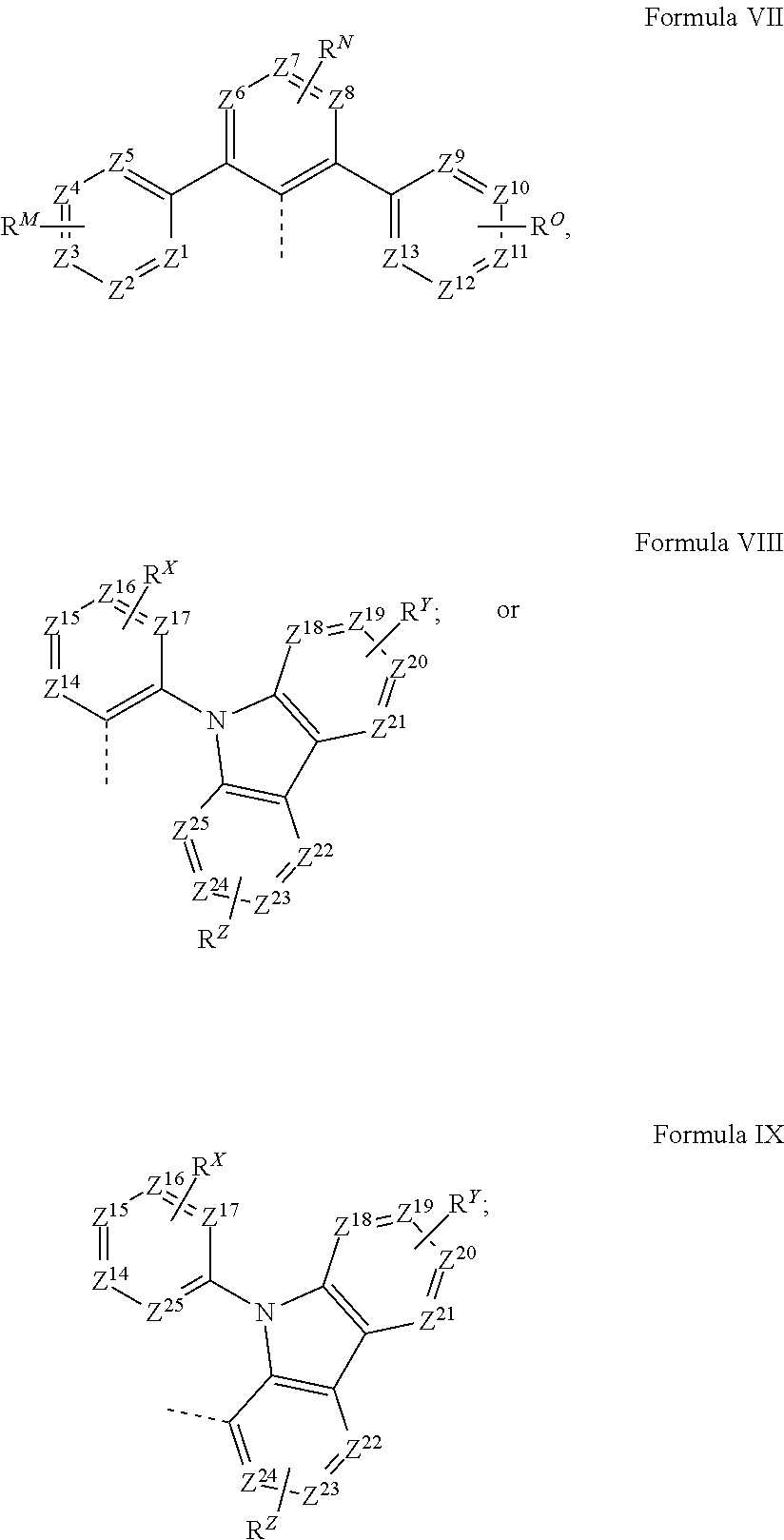



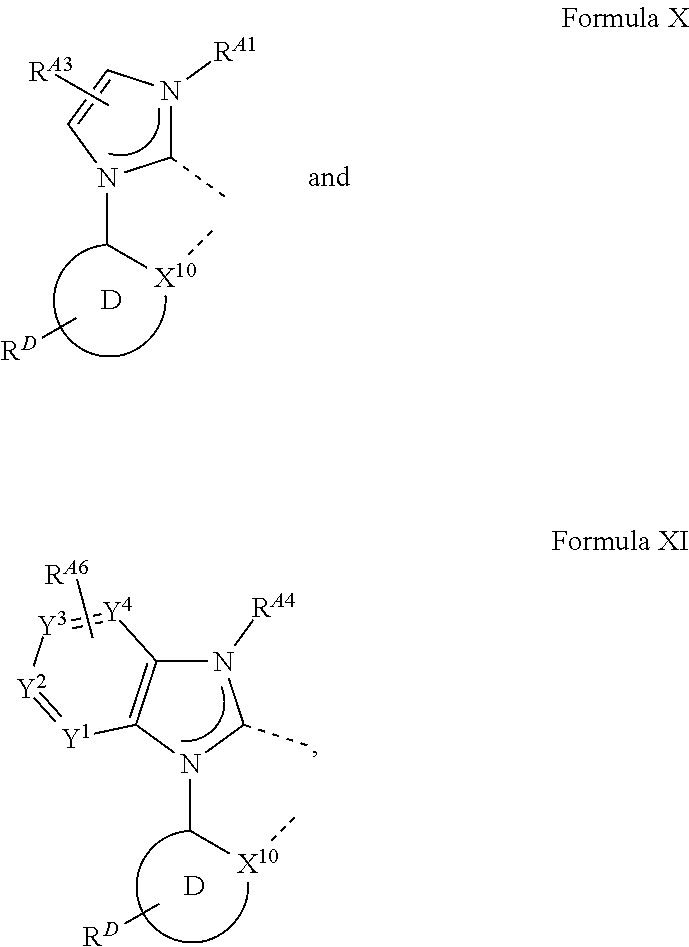







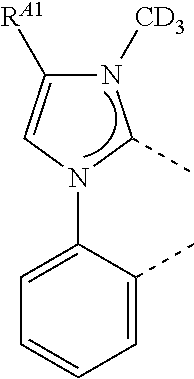





















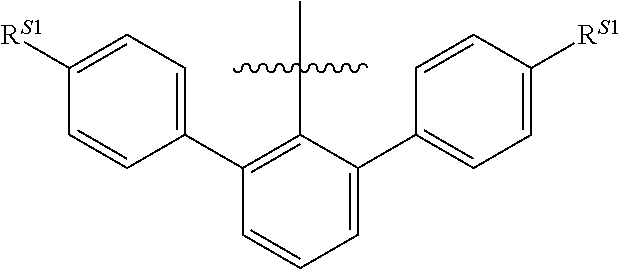











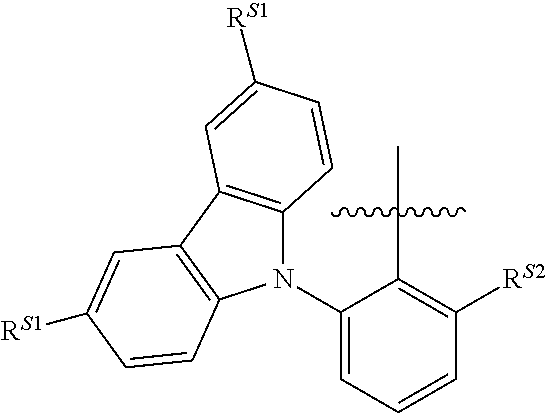




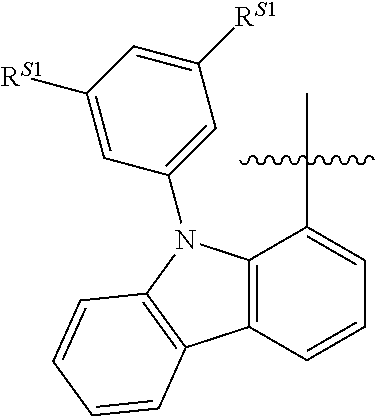

























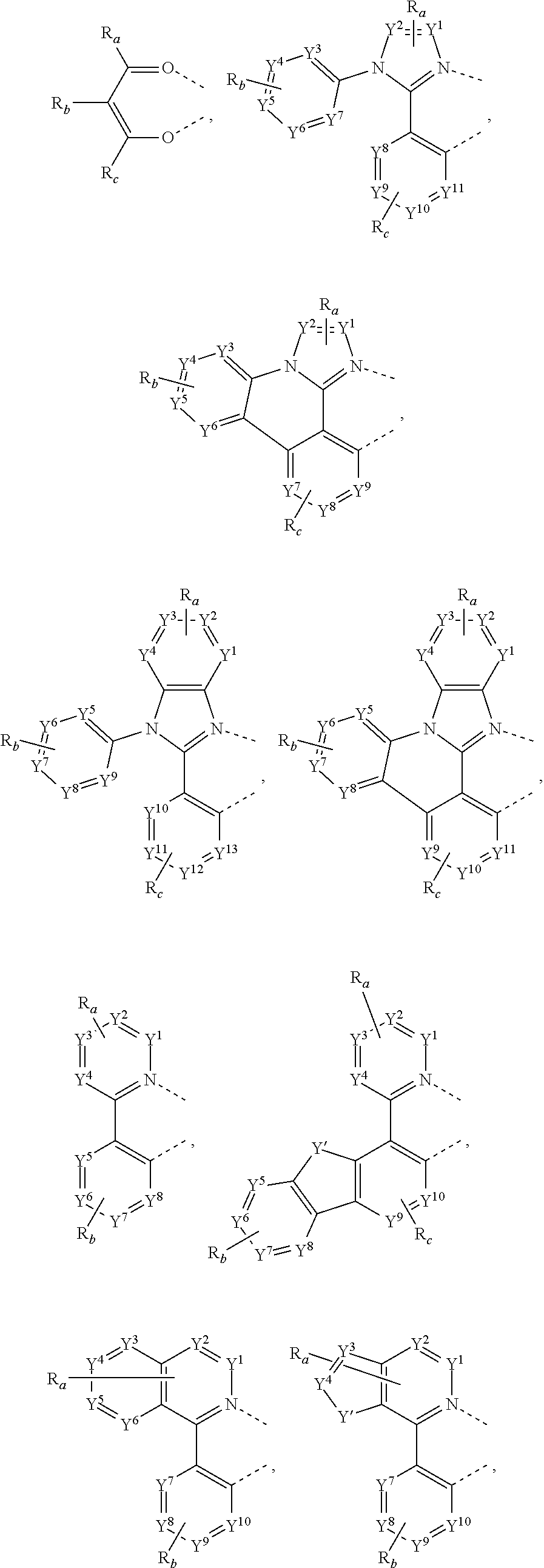
































































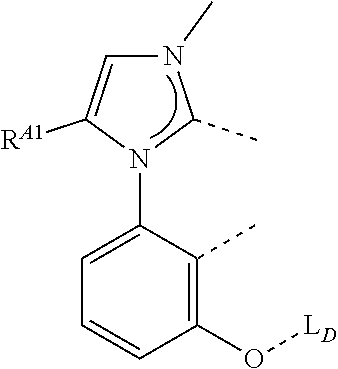










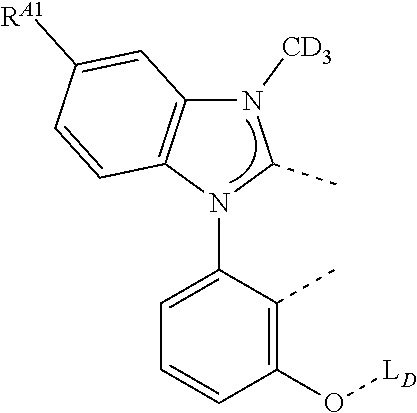

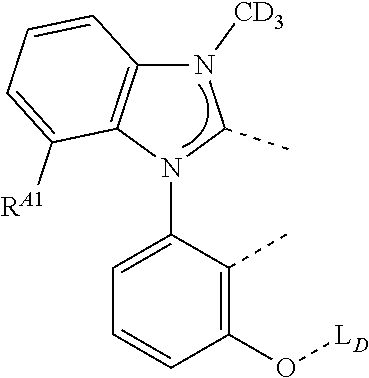









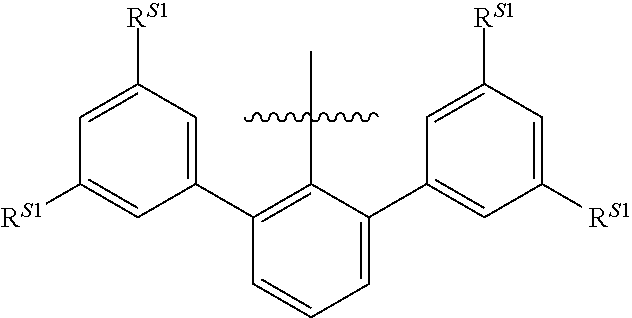










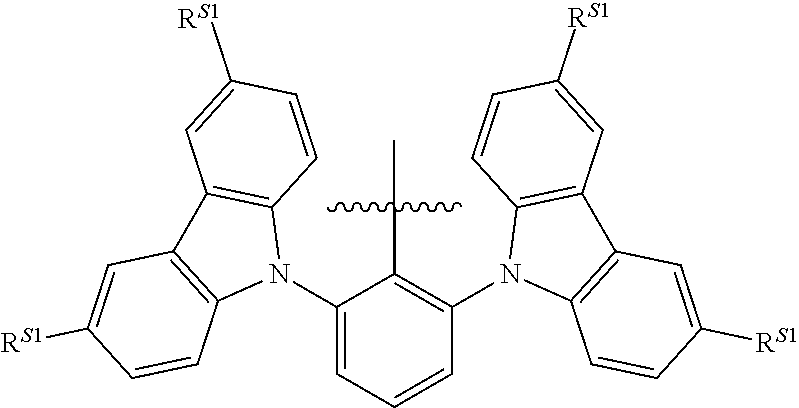












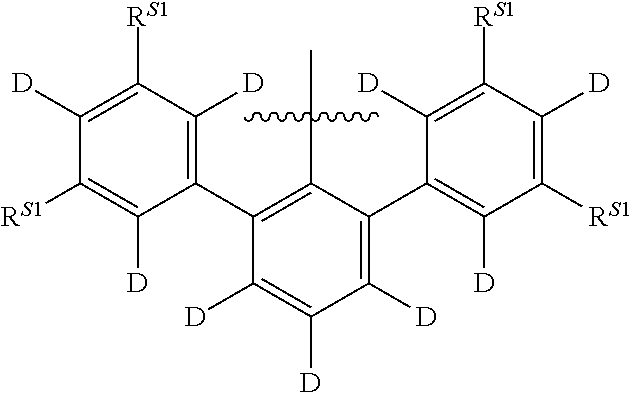



































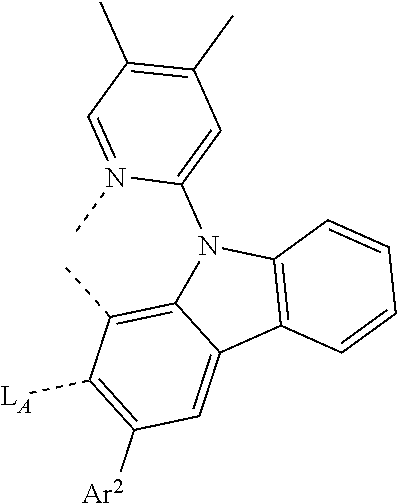





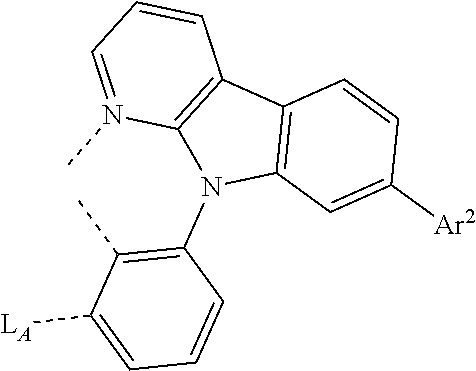





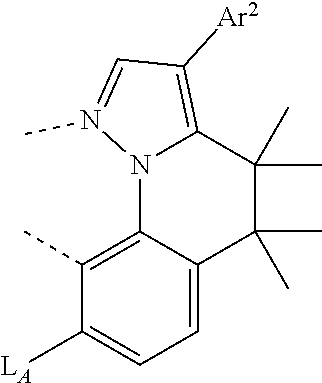






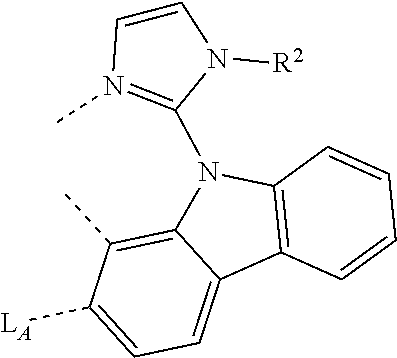


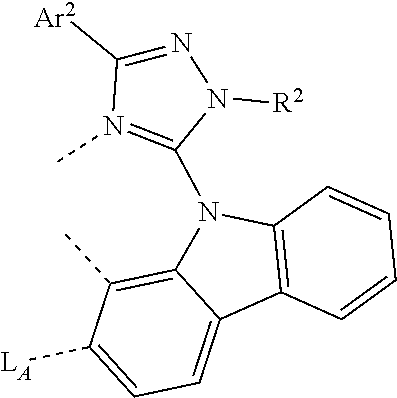








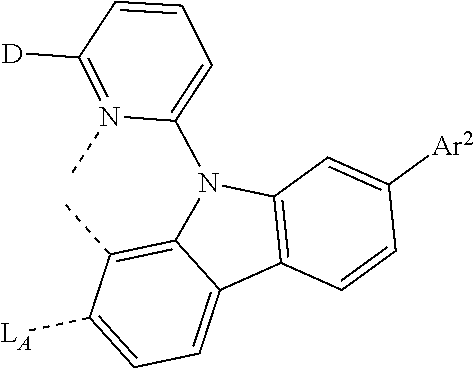






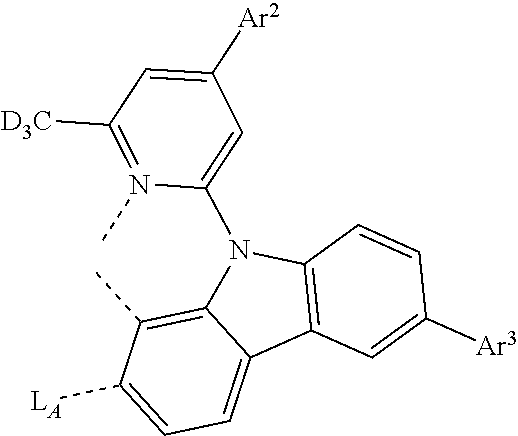












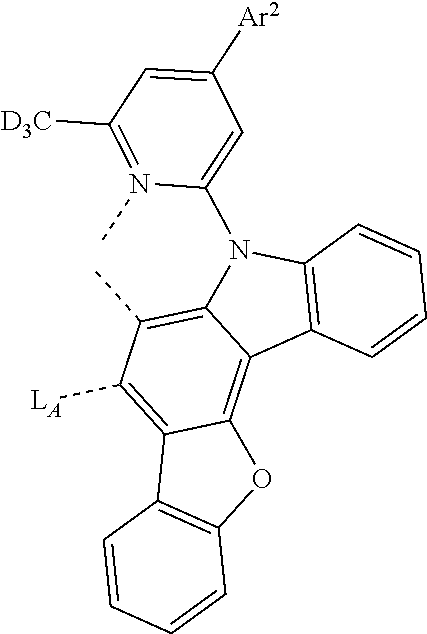



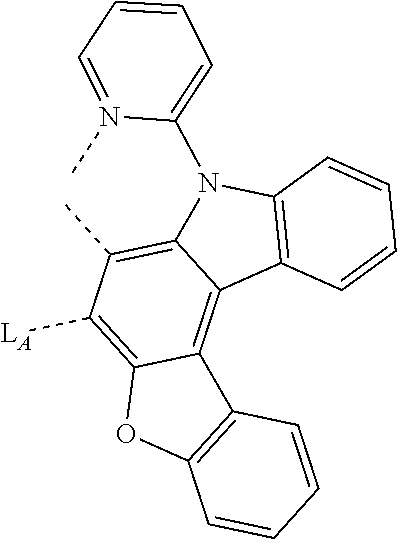



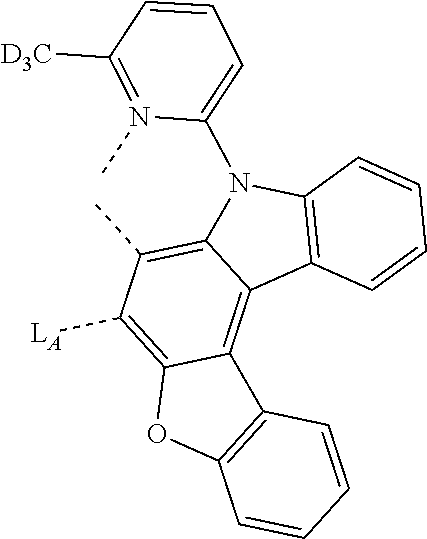






































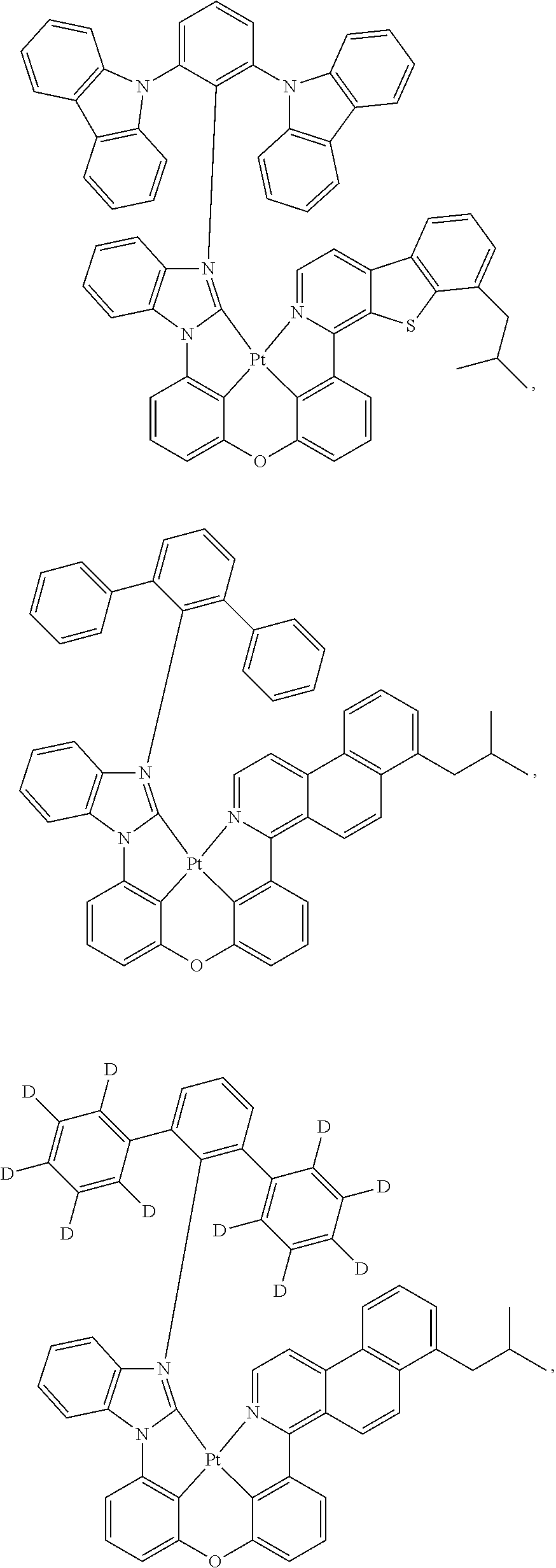







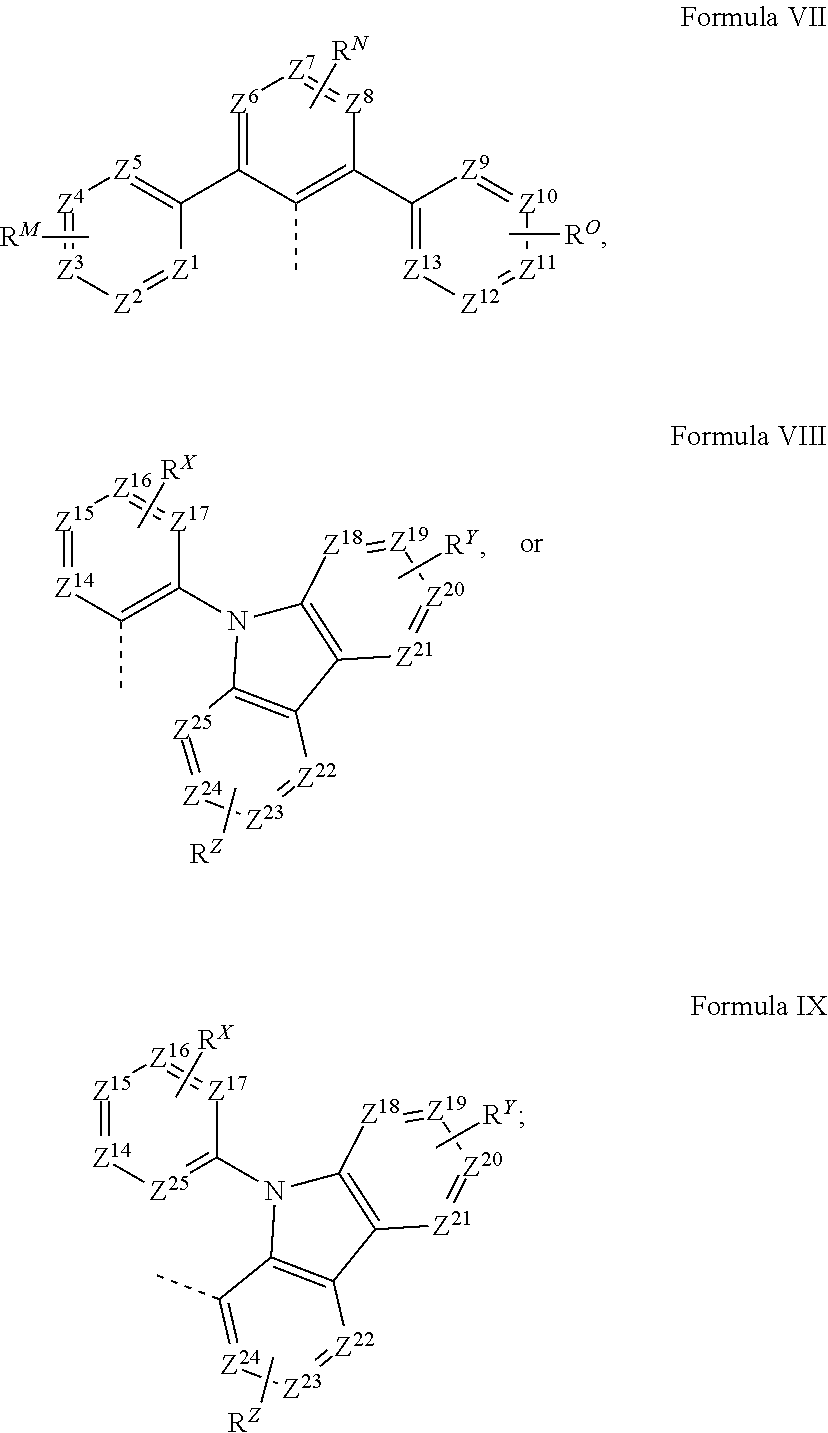




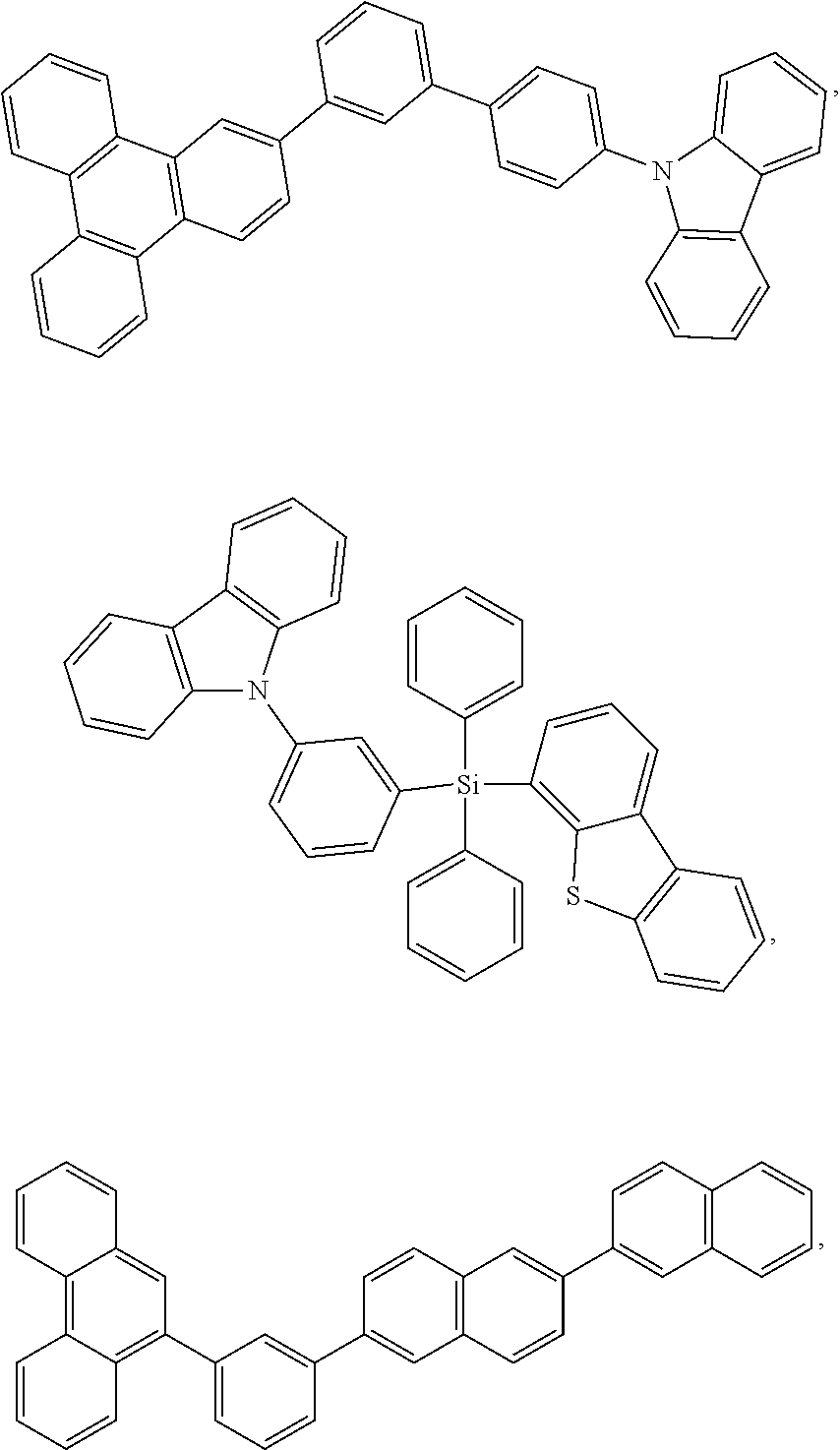

























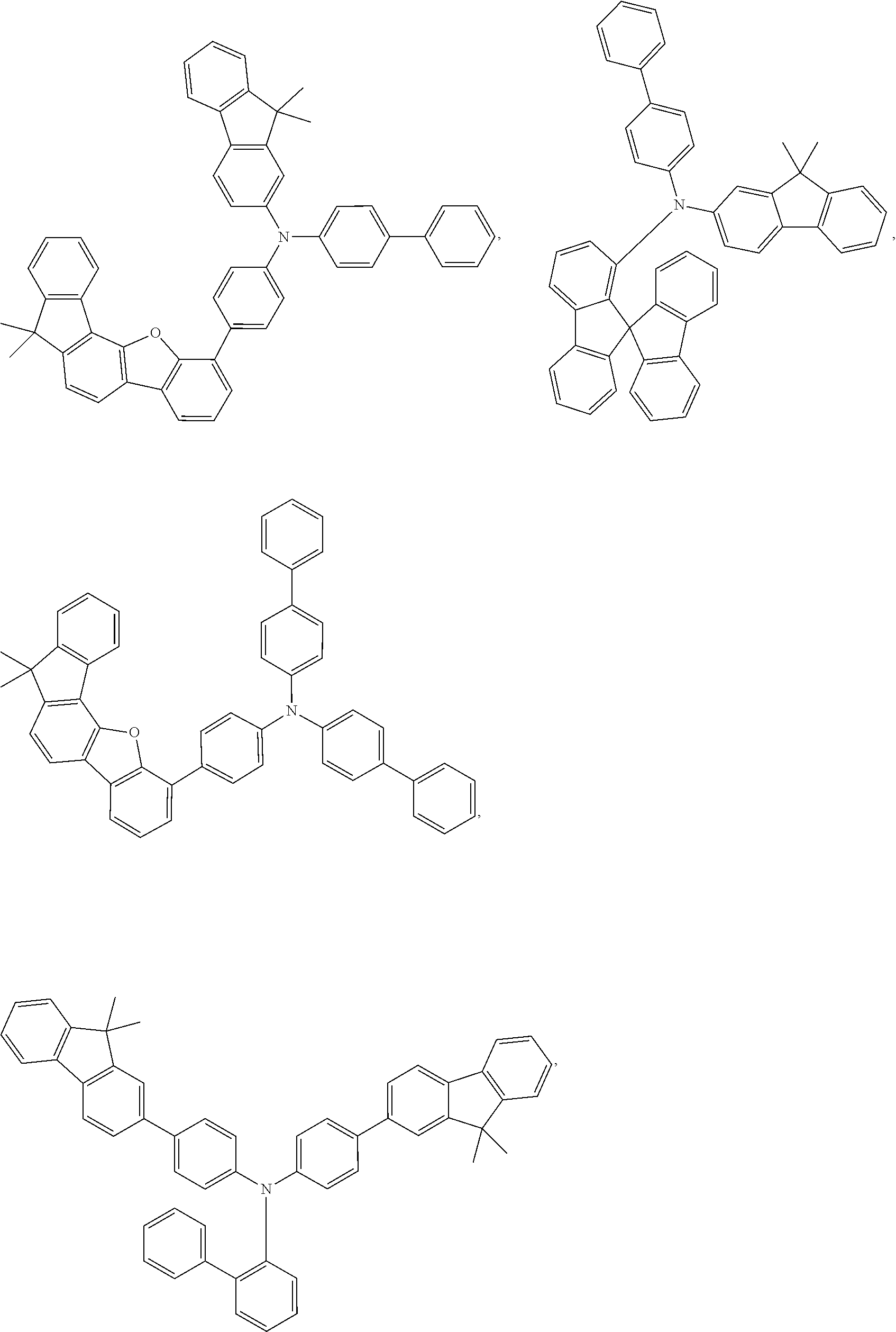



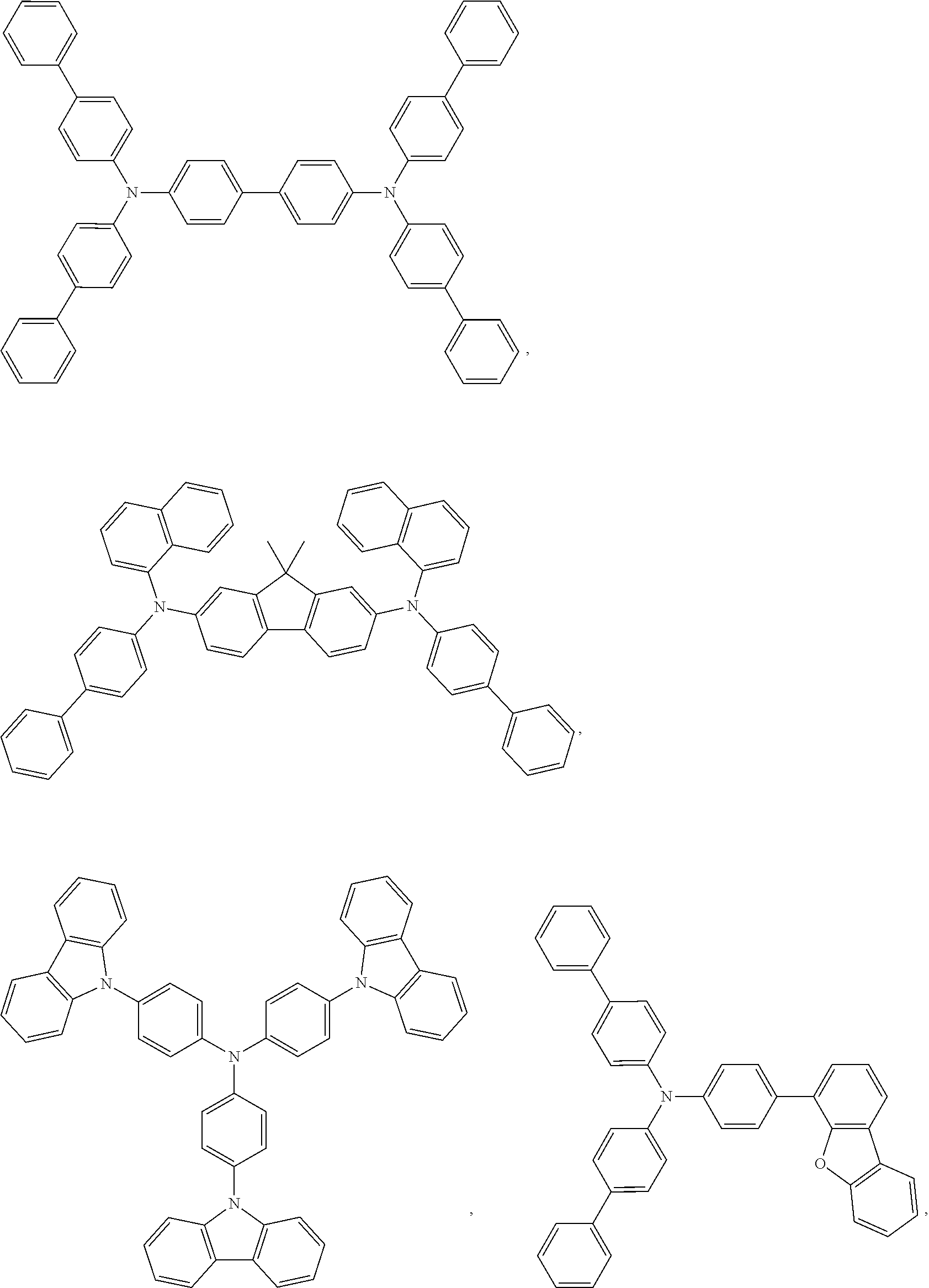
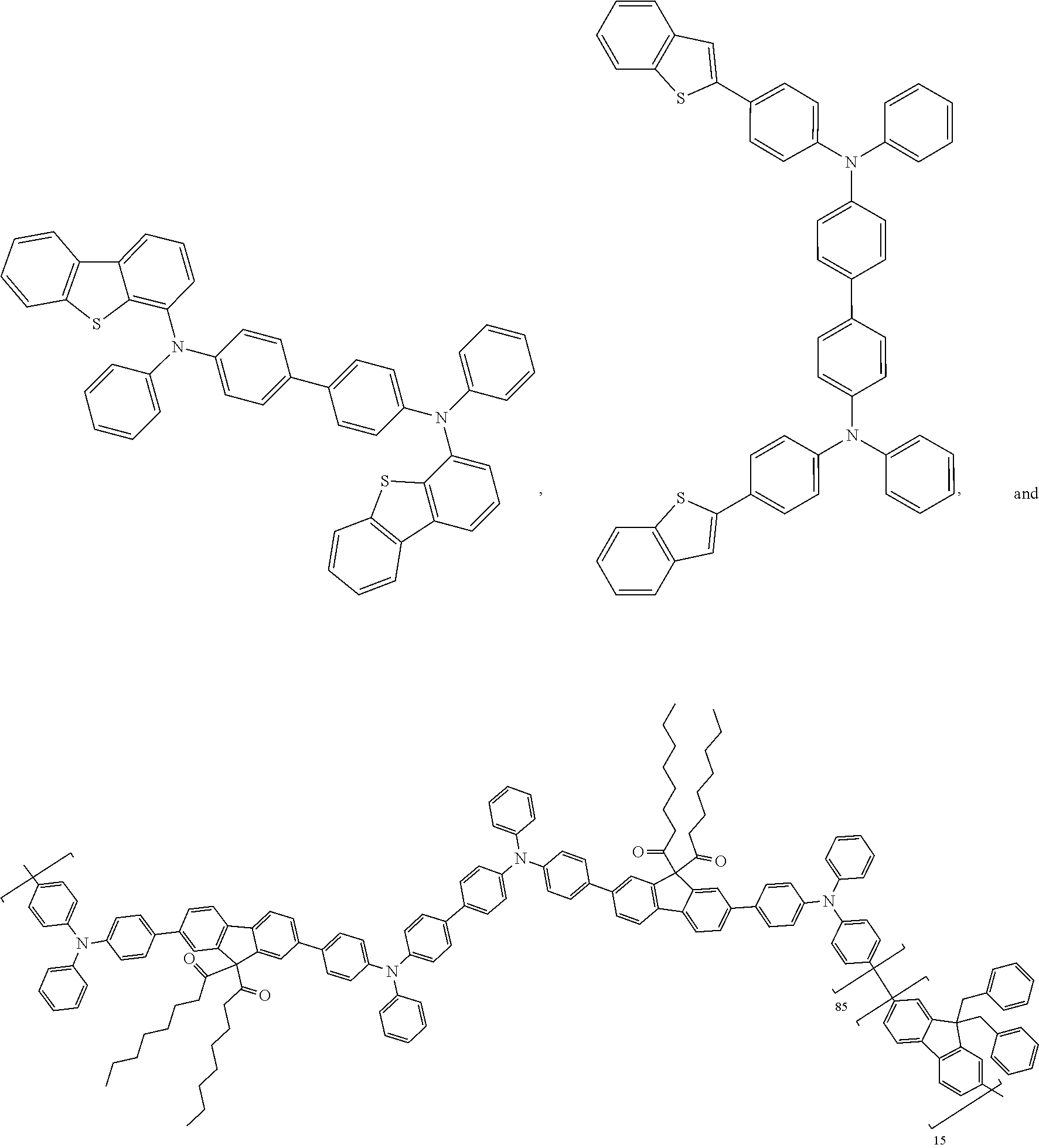








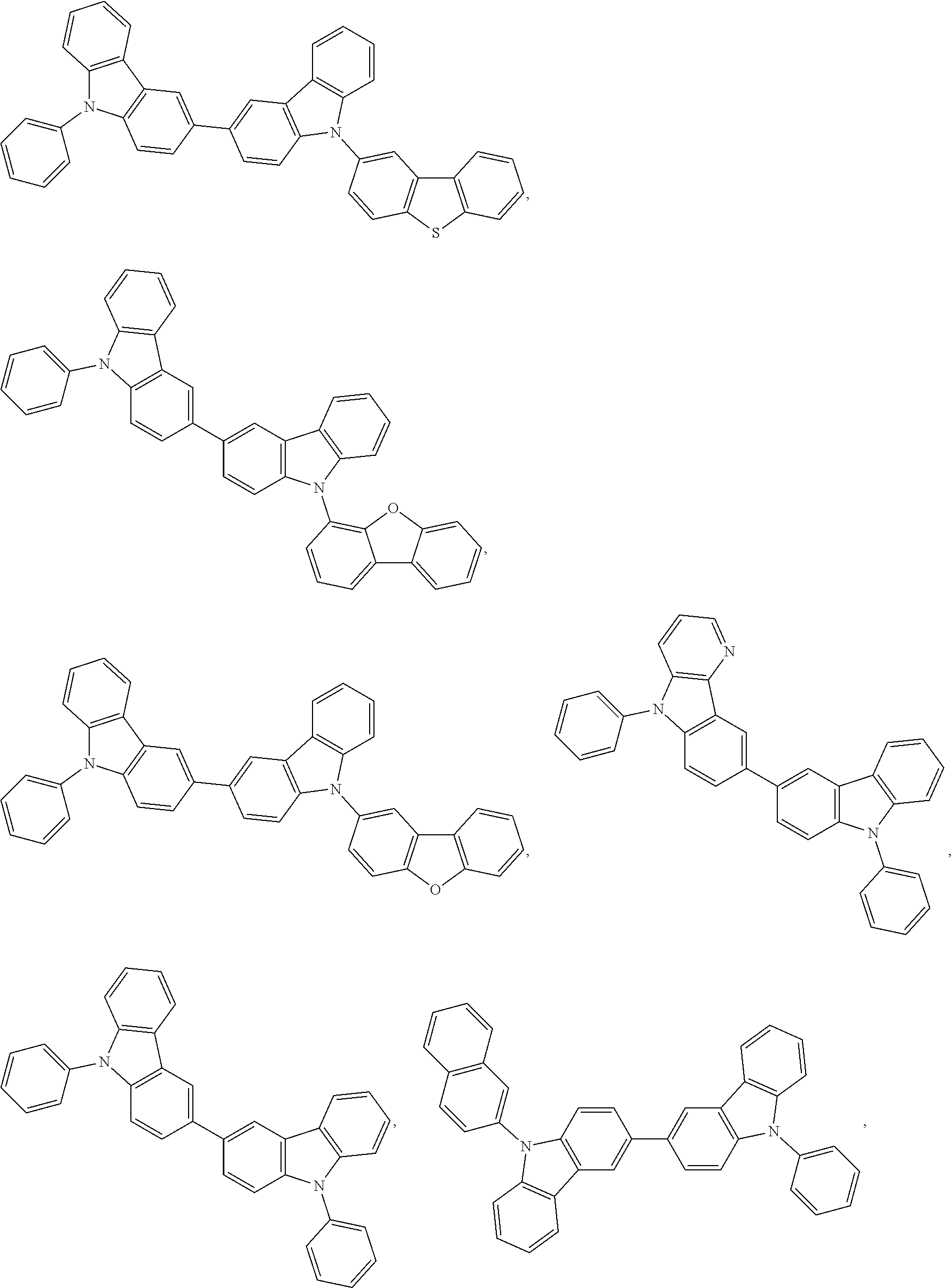

















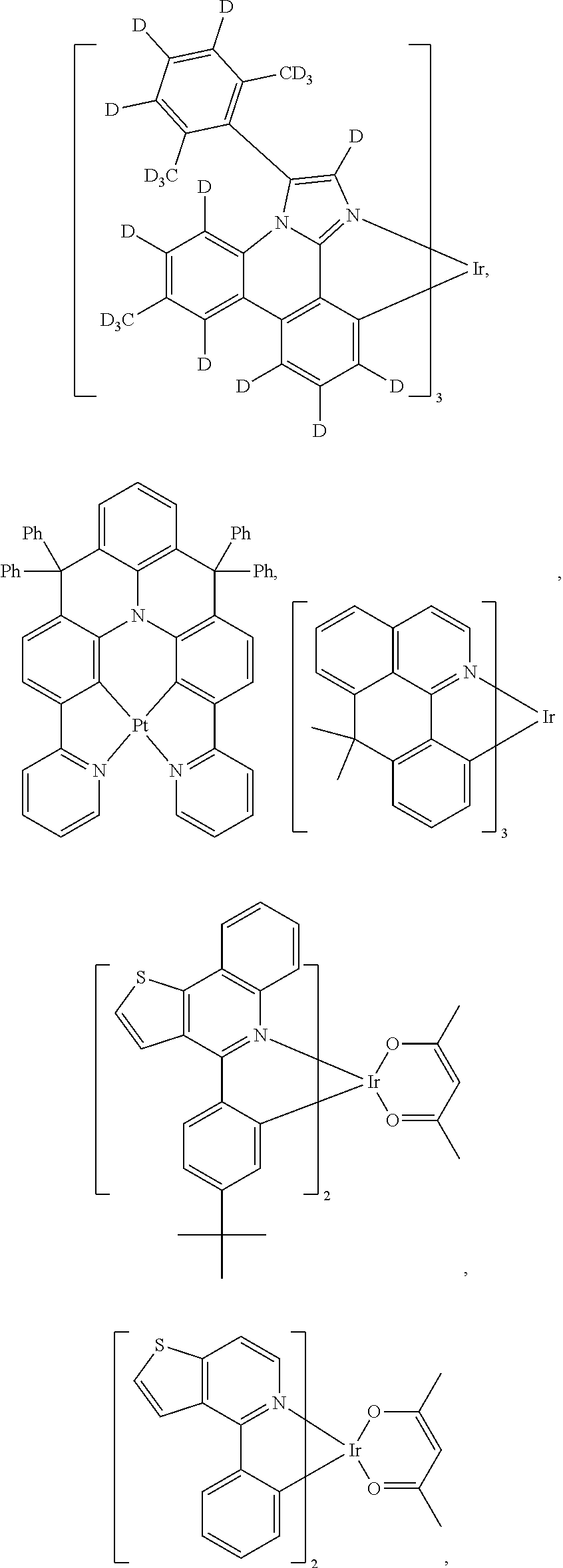











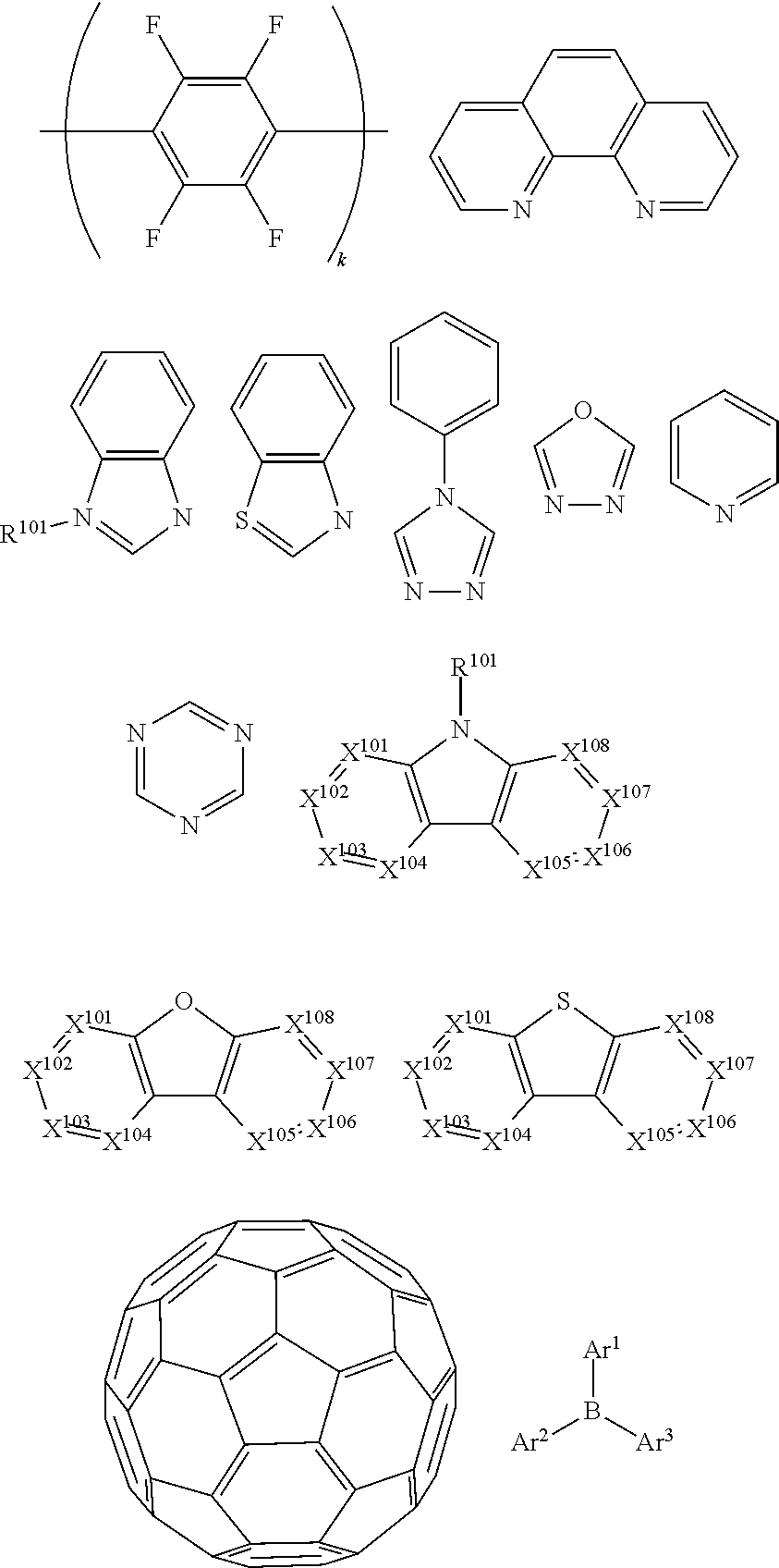



































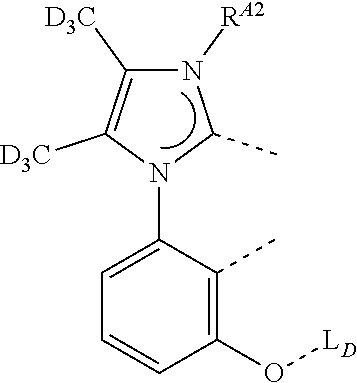




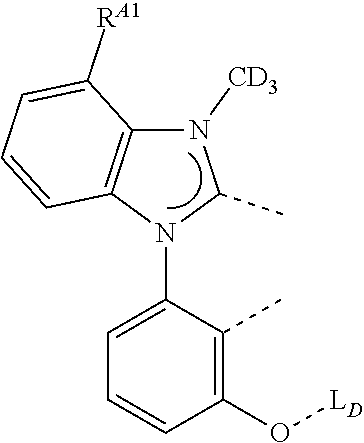




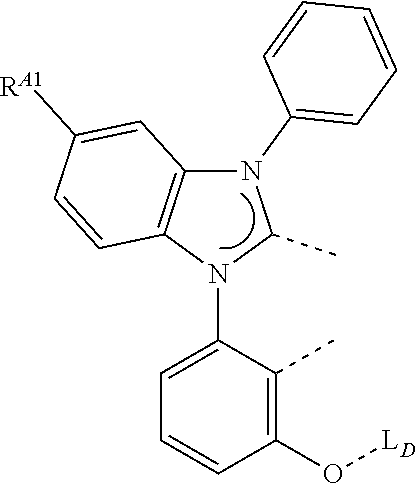



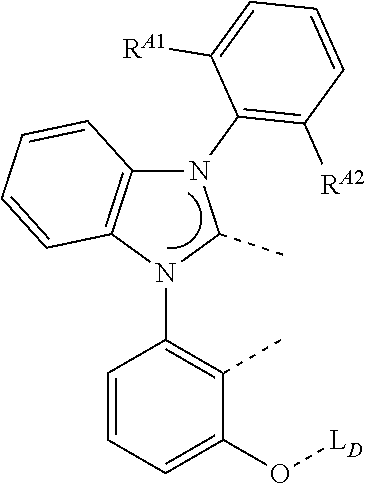


















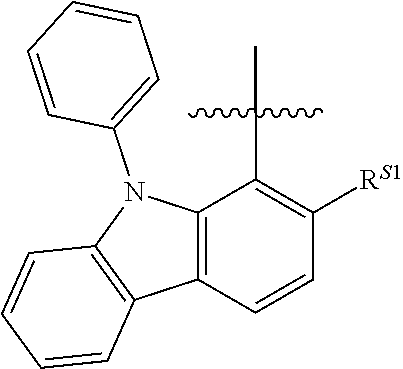

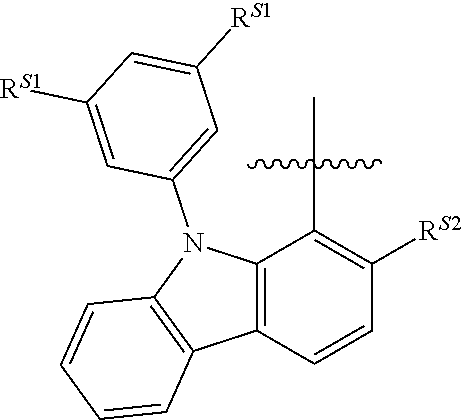




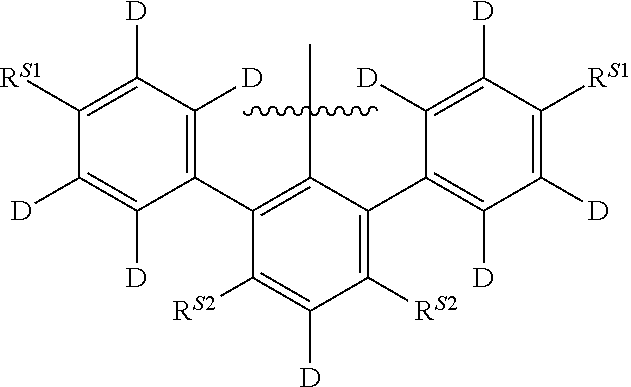

















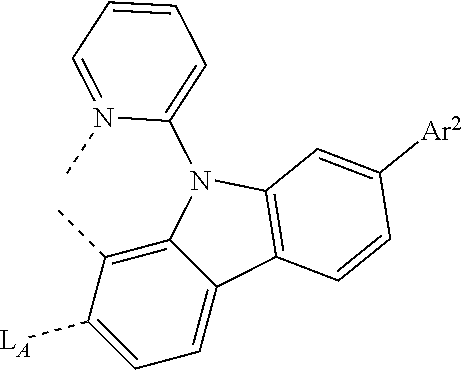
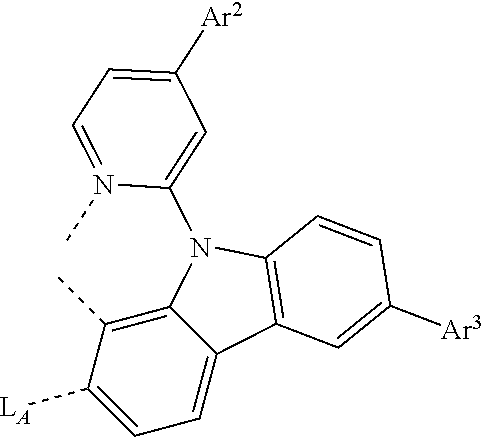

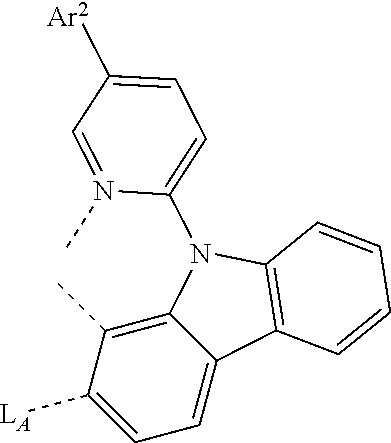
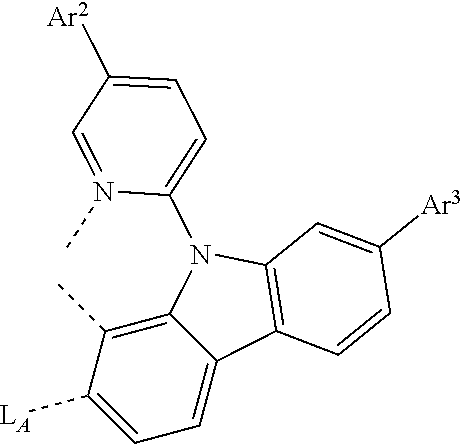






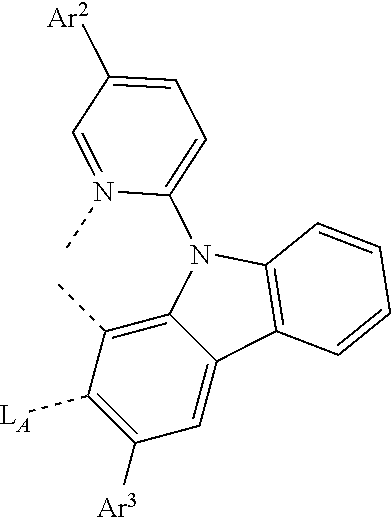






























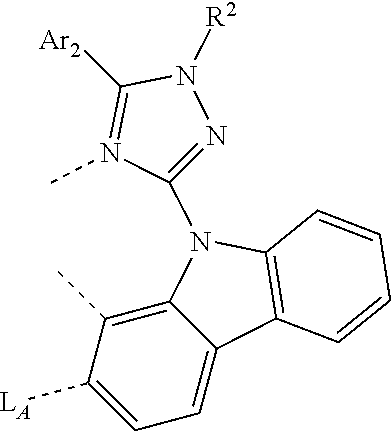
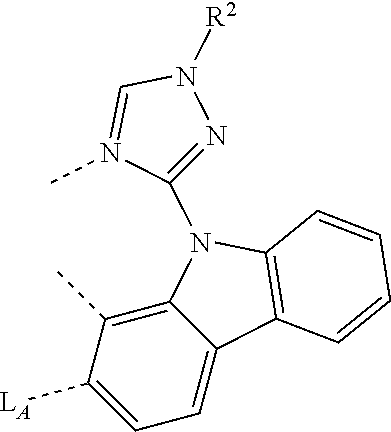



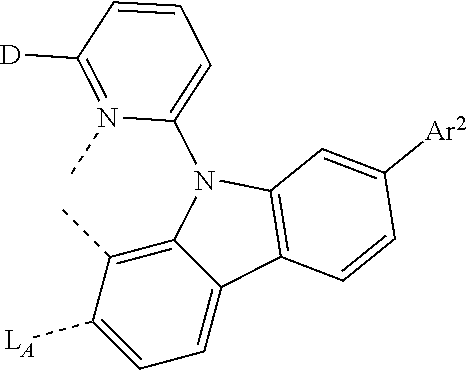




























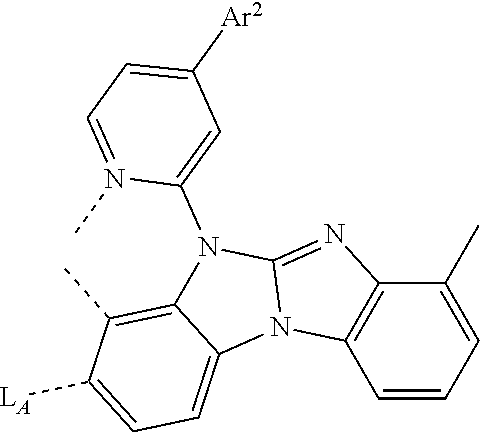











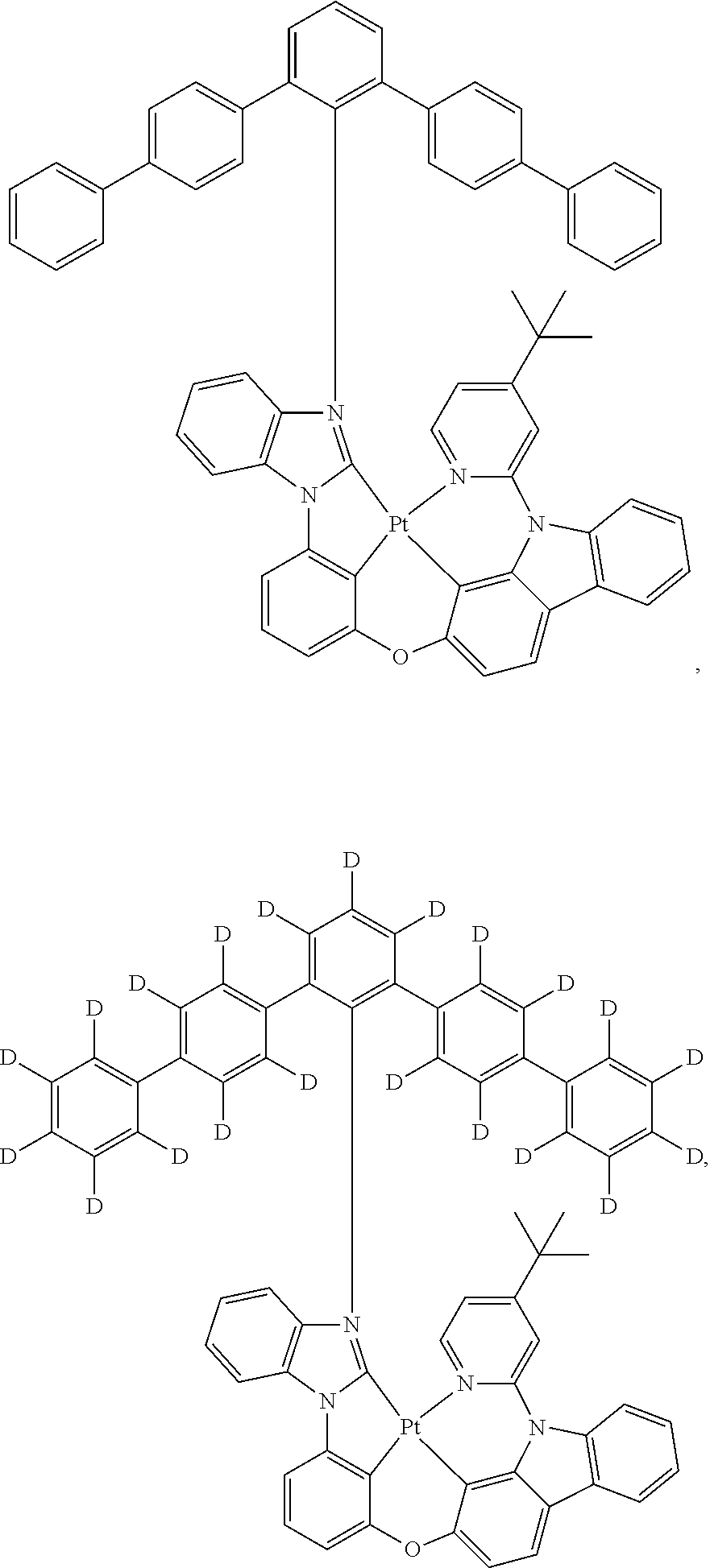











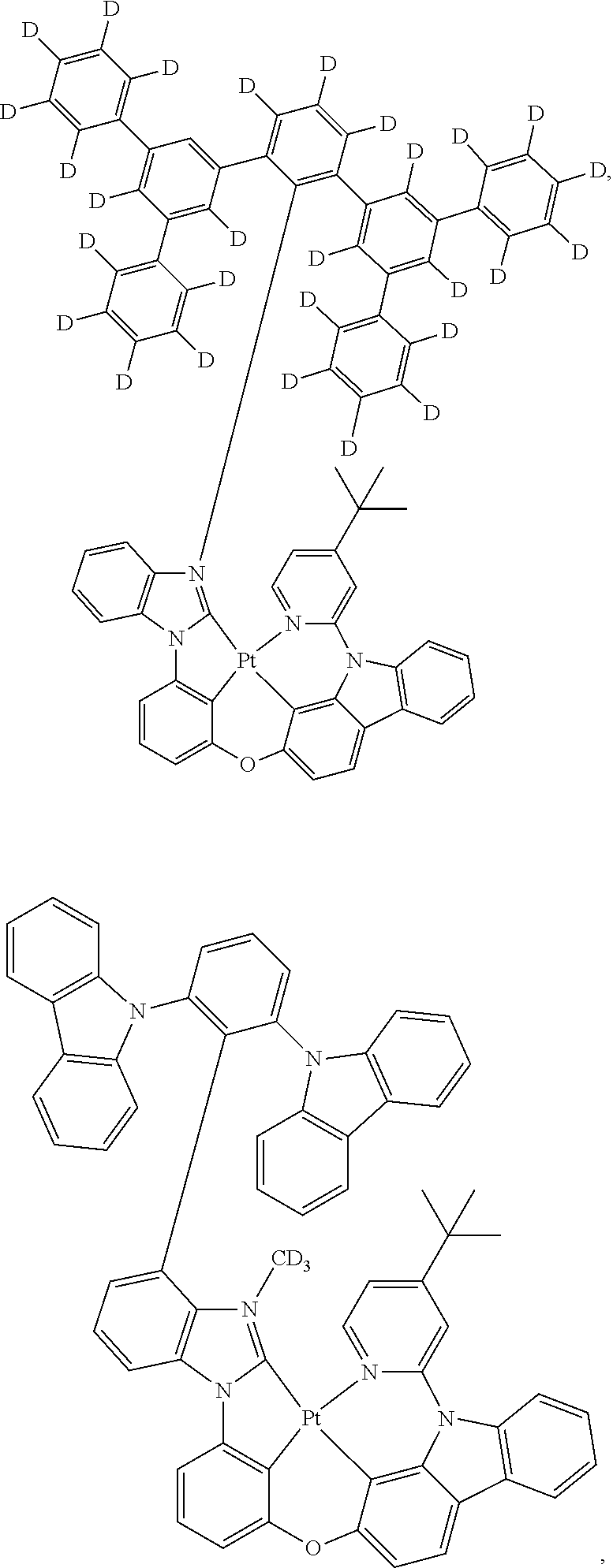






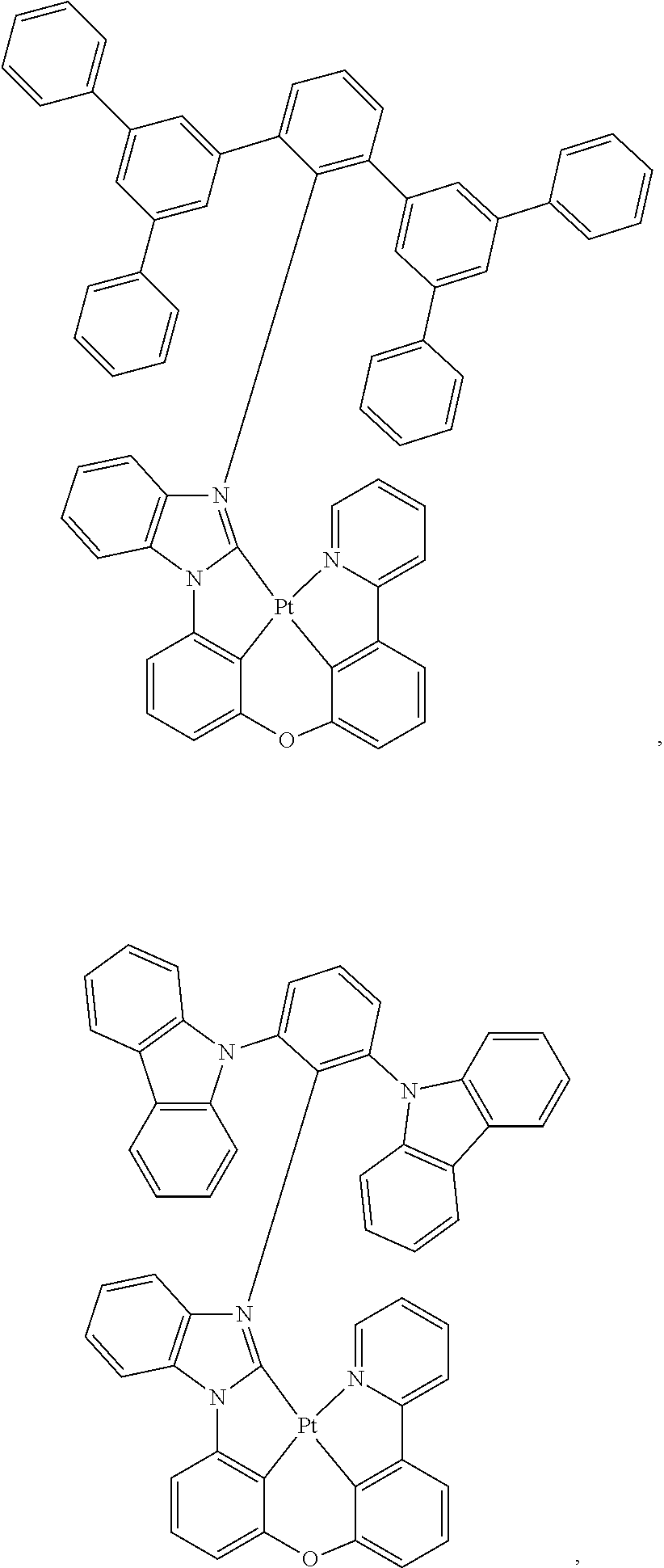







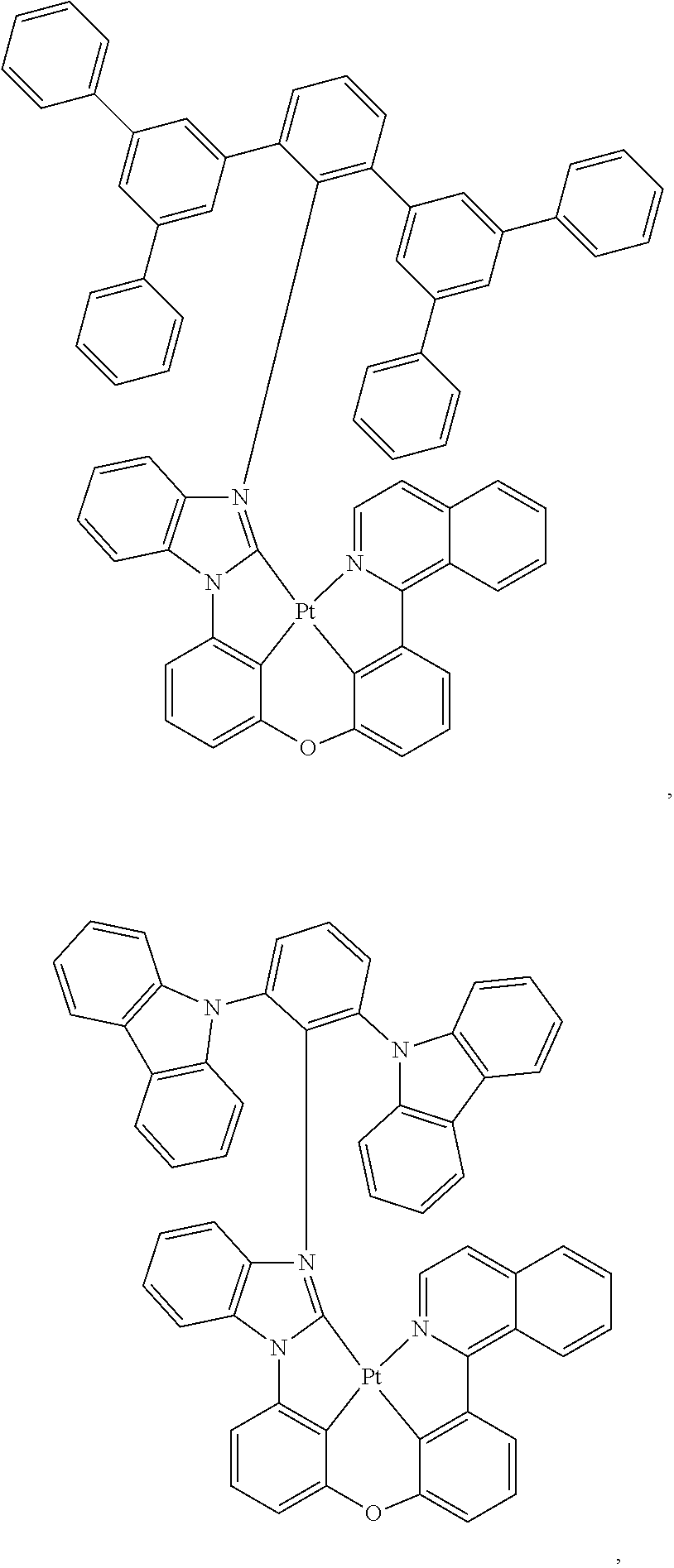
















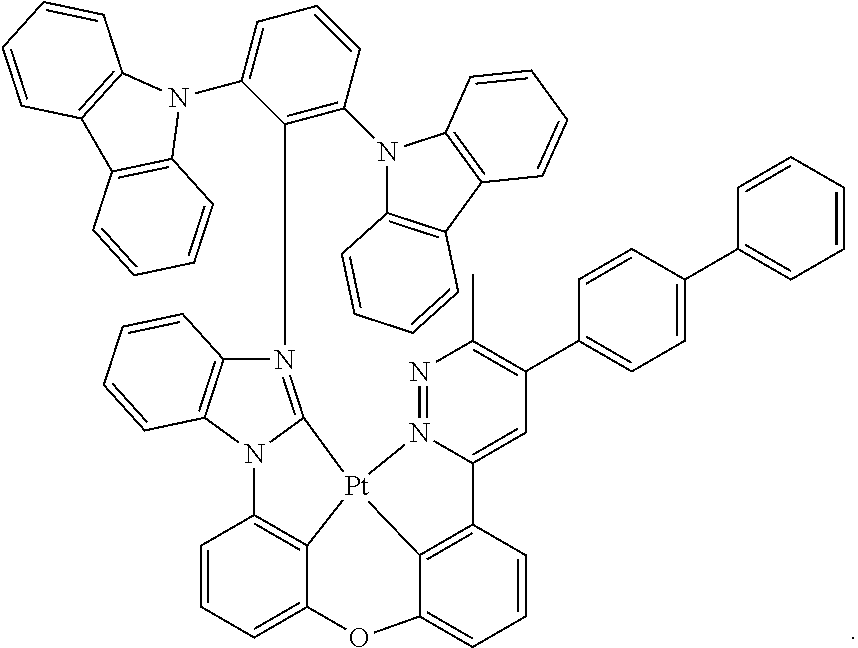
D00000

D00001

D00002

XML
uspto.report is an independent third-party trademark research tool that is not affiliated, endorsed, or sponsored by the United States Patent and Trademark Office (USPTO) or any other governmental organization. The information provided by uspto.report is based on publicly available data at the time of writing and is intended for informational purposes only.
While we strive to provide accurate and up-to-date information, we do not guarantee the accuracy, completeness, reliability, or suitability of the information displayed on this site. The use of this site is at your own risk. Any reliance you place on such information is therefore strictly at your own risk.
All official trademark data, including owner information, should be verified by visiting the official USPTO website at www.uspto.gov. This site is not intended to replace professional legal advice and should not be used as a substitute for consulting with a legal professional who is knowledgeable about trademark law.